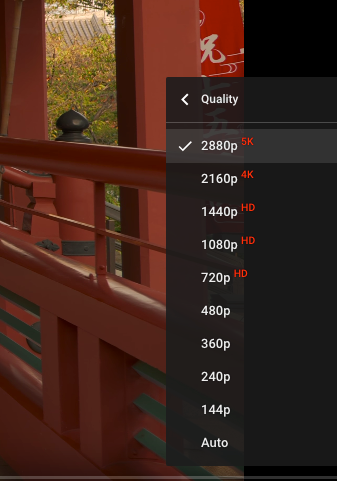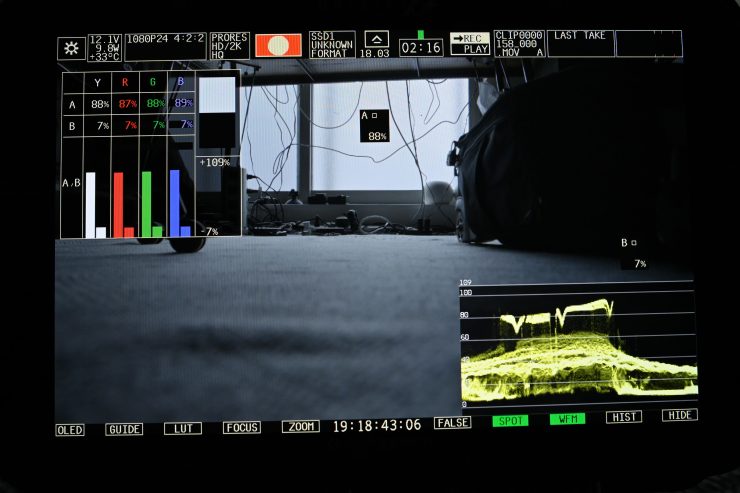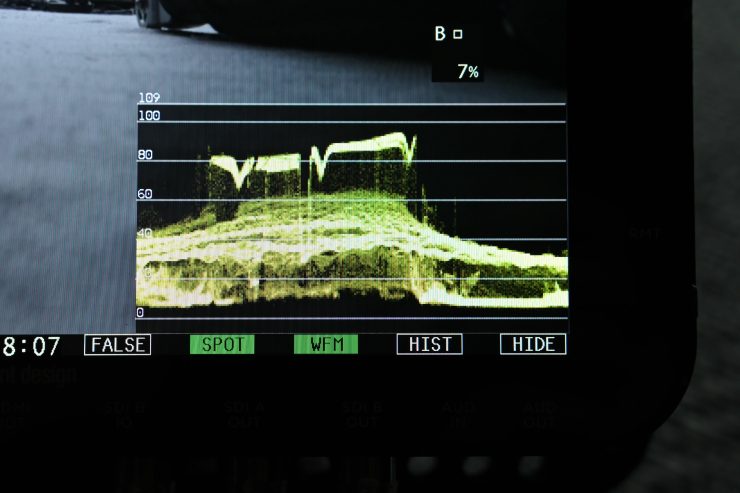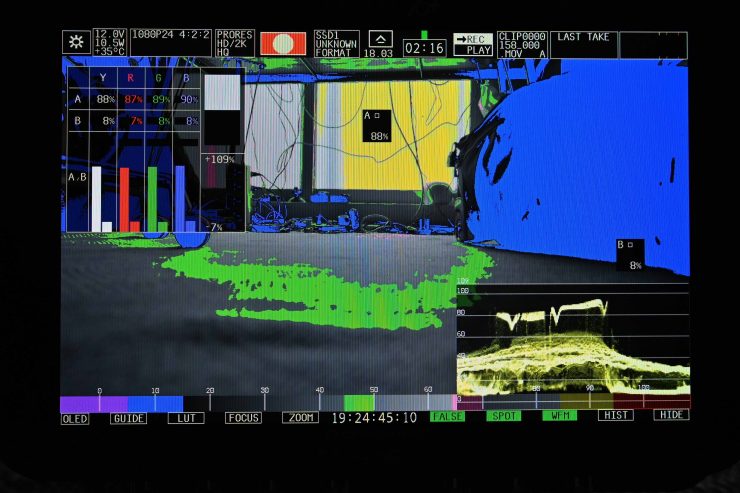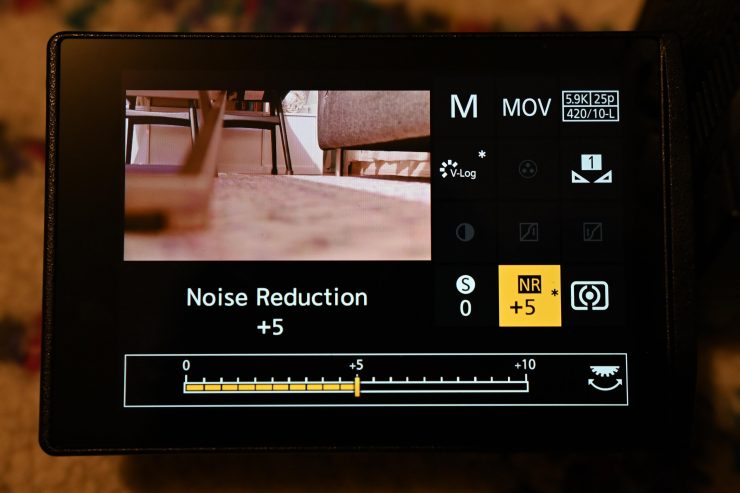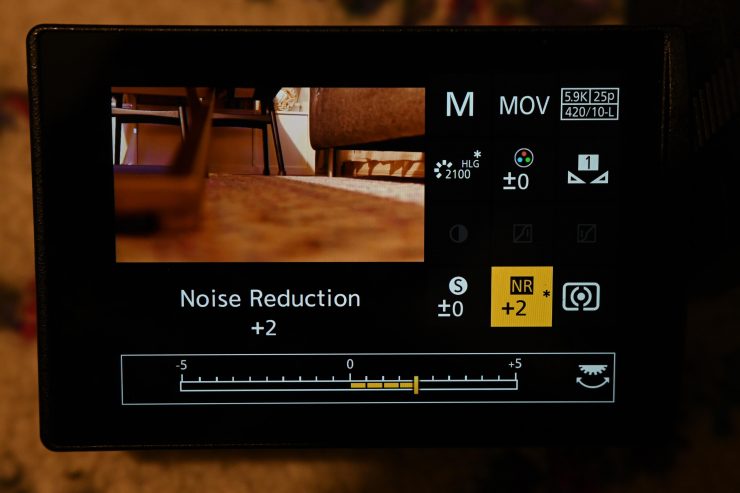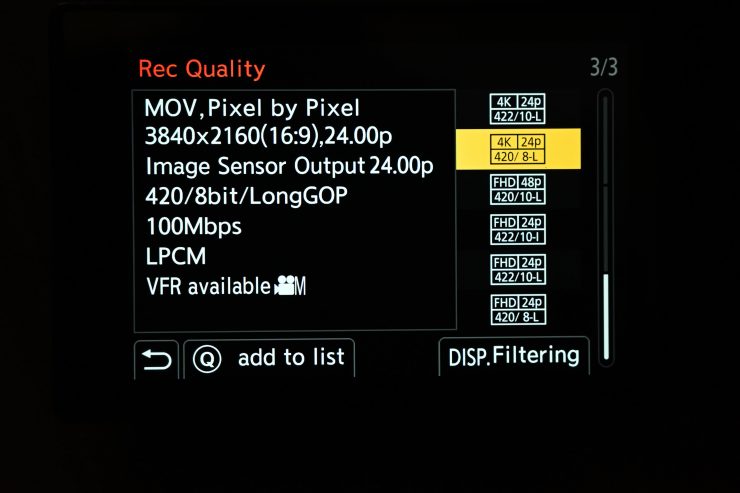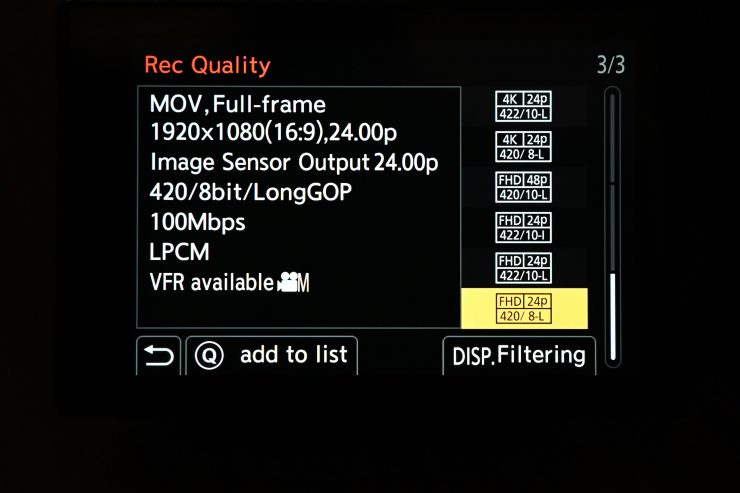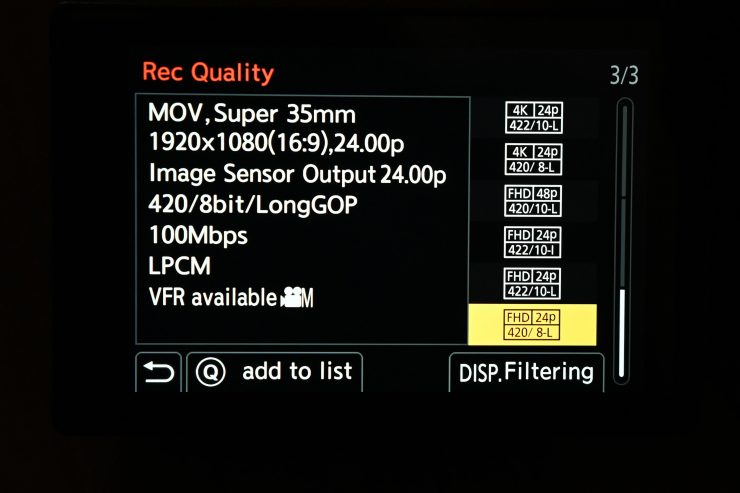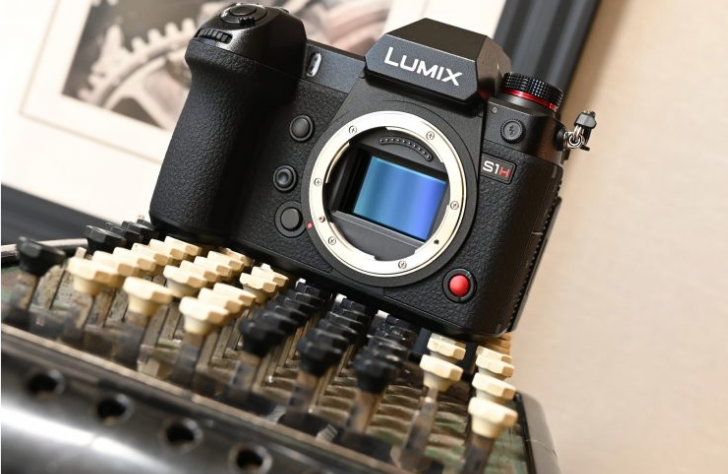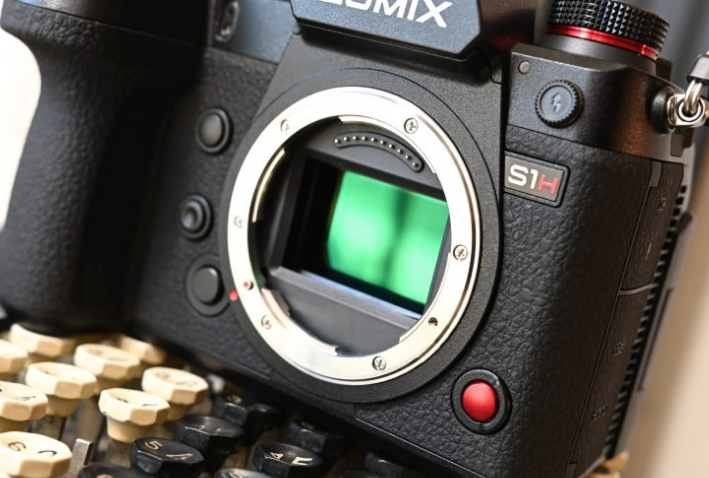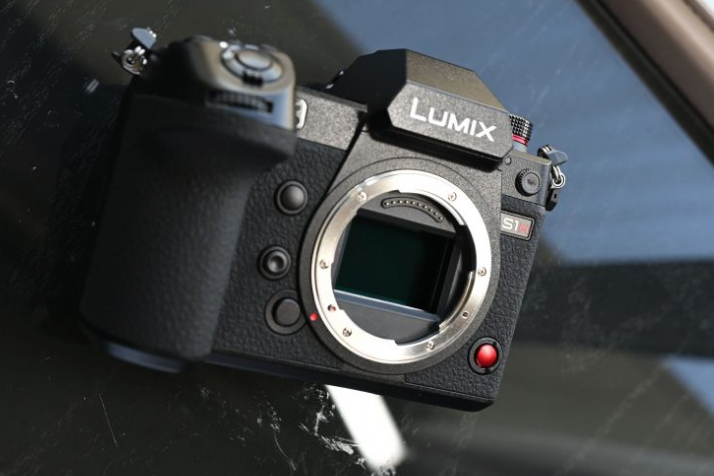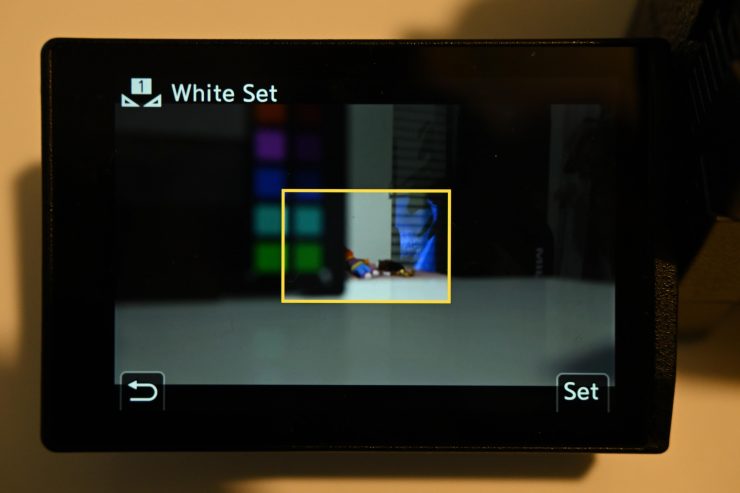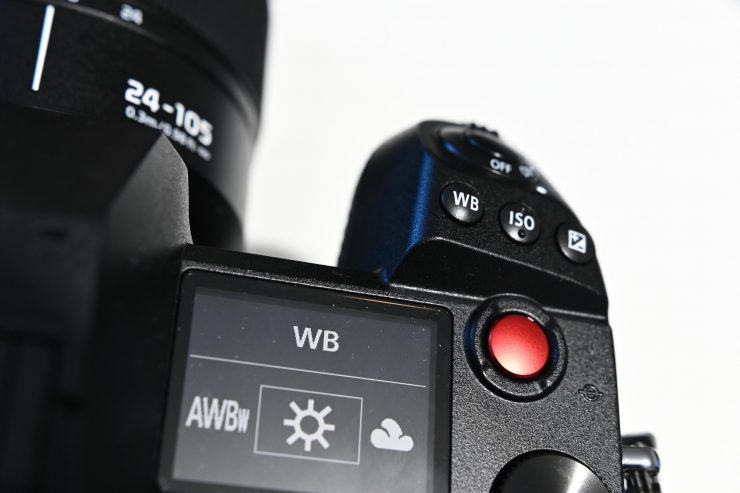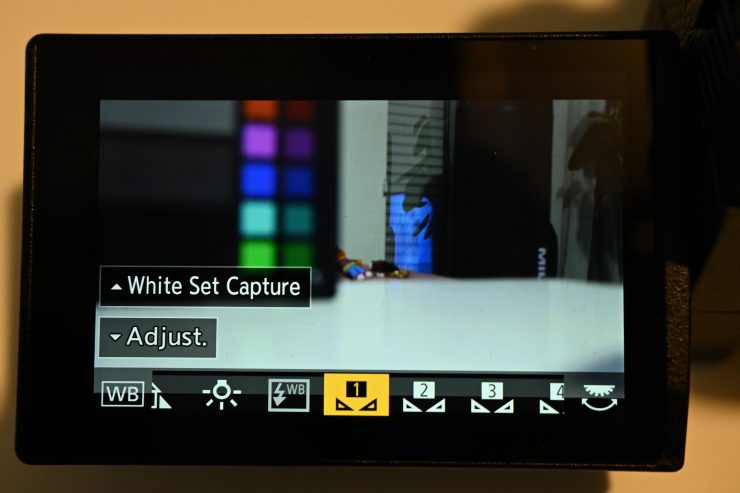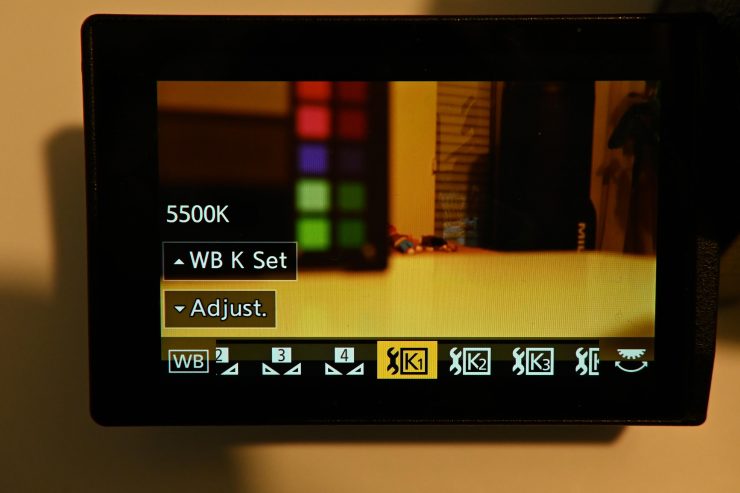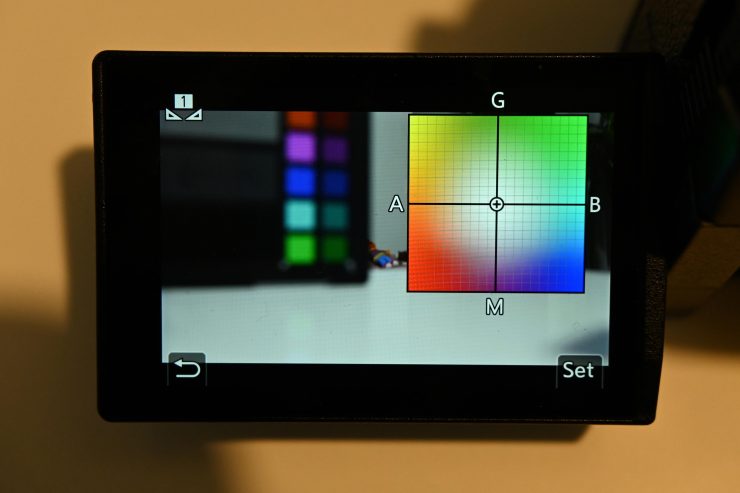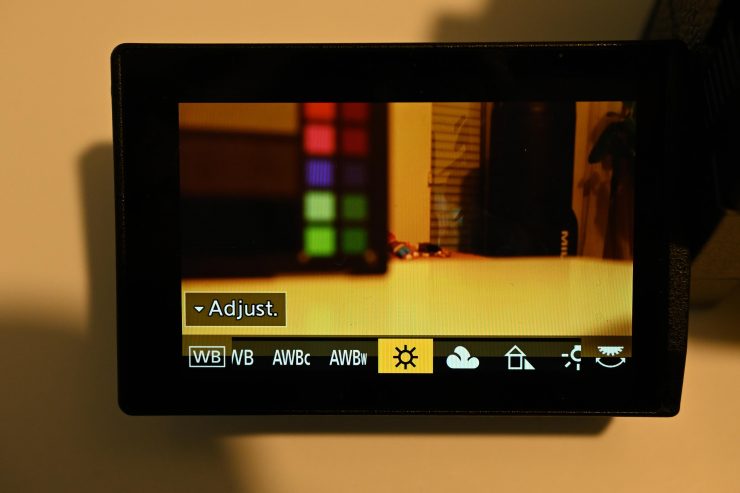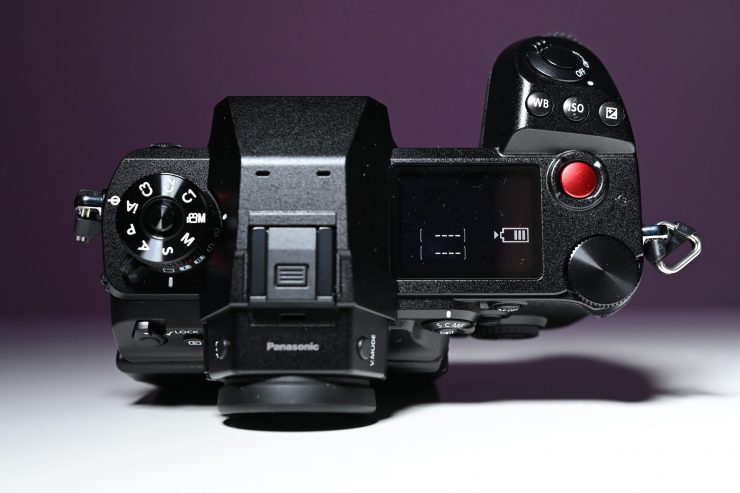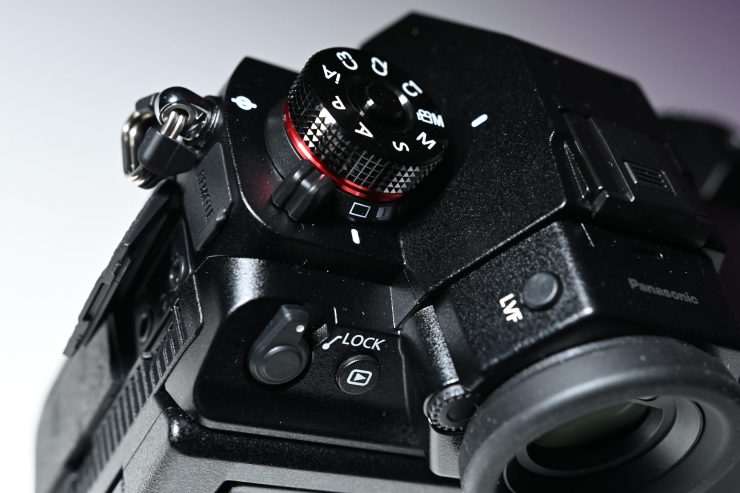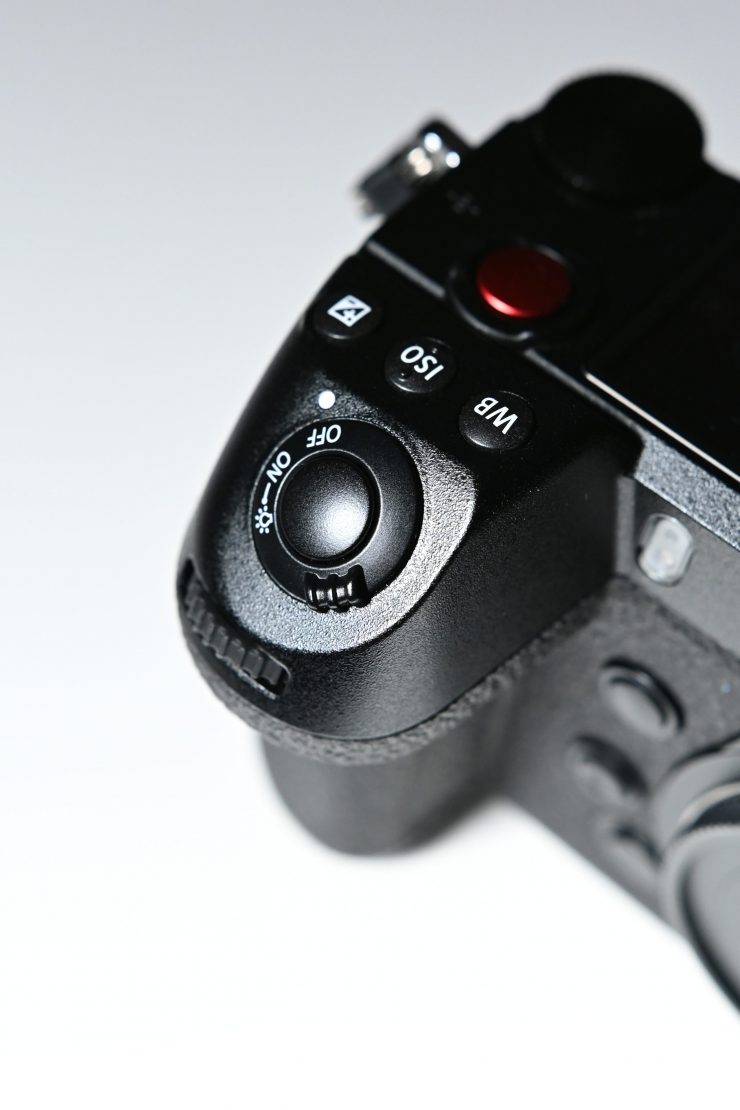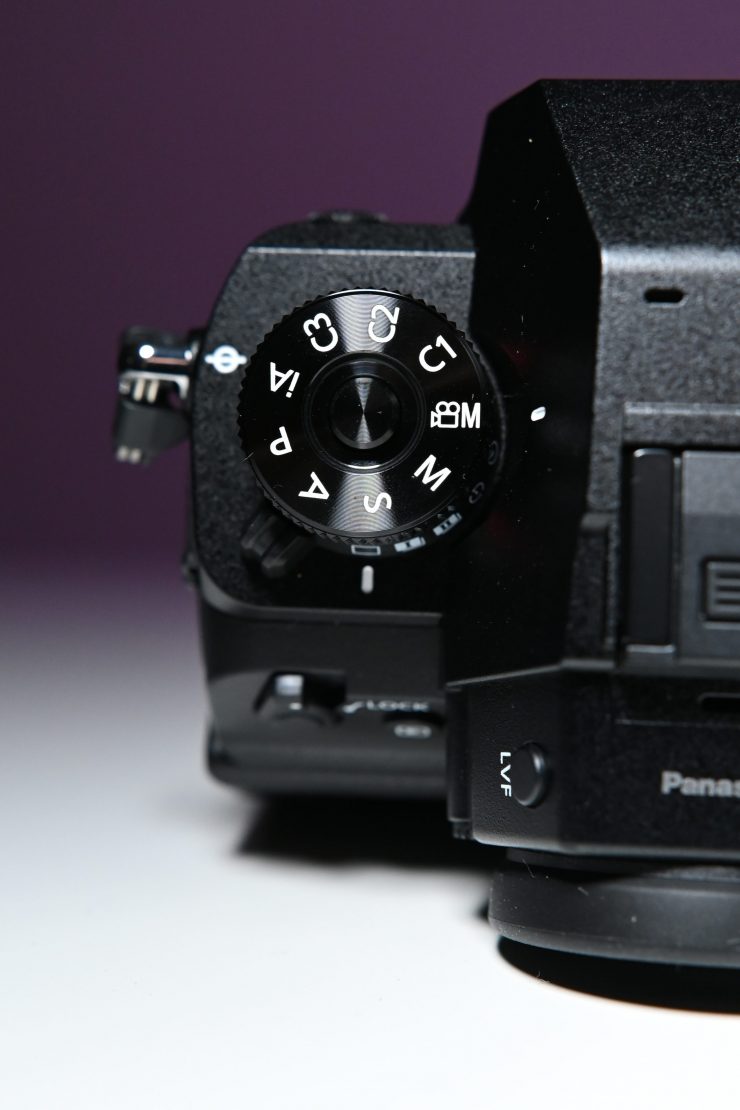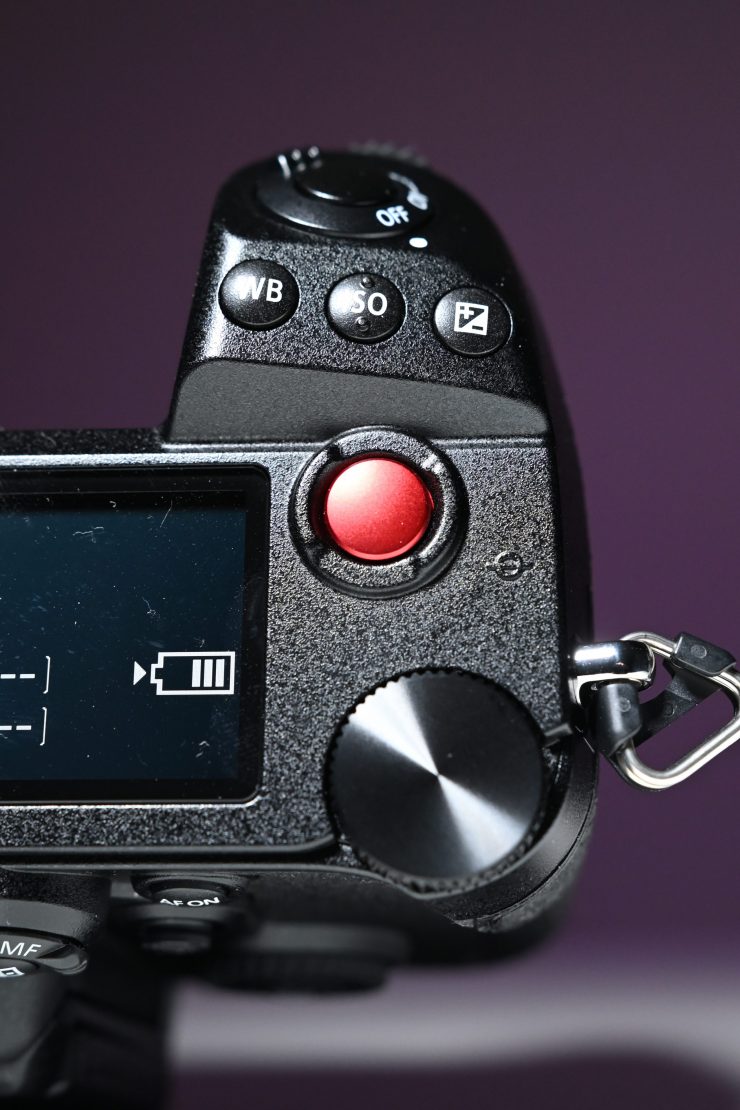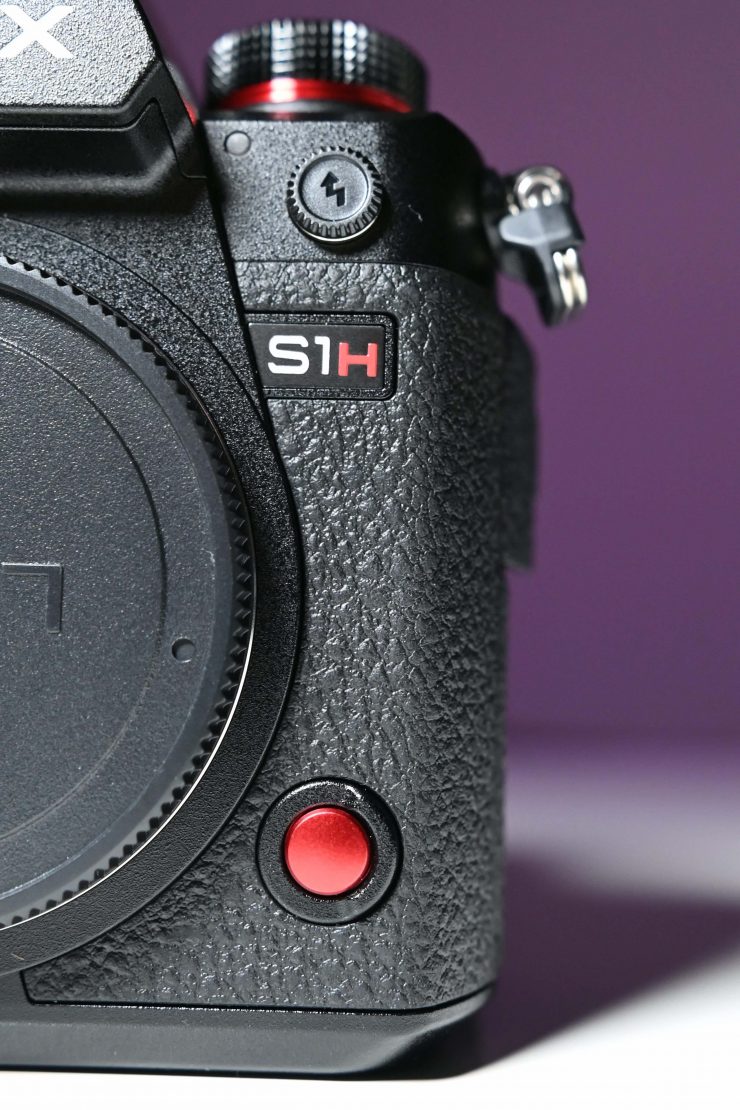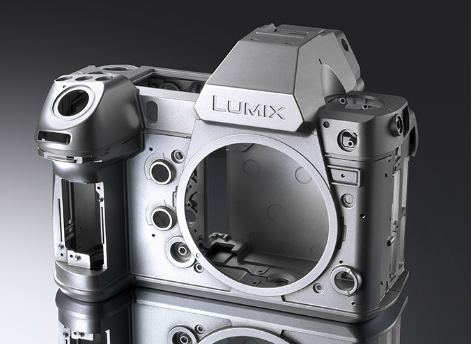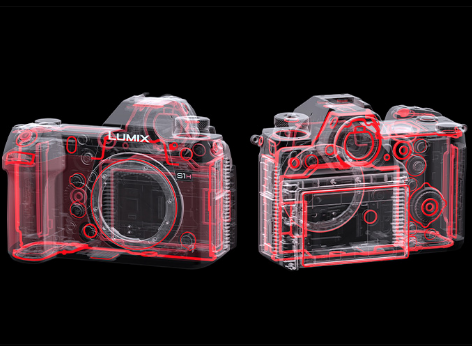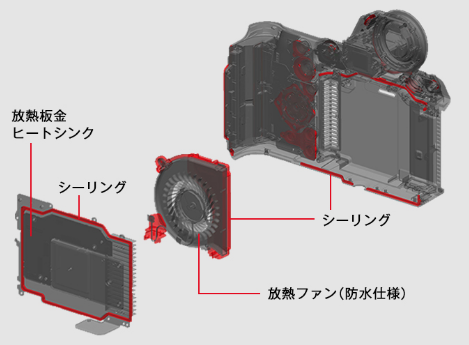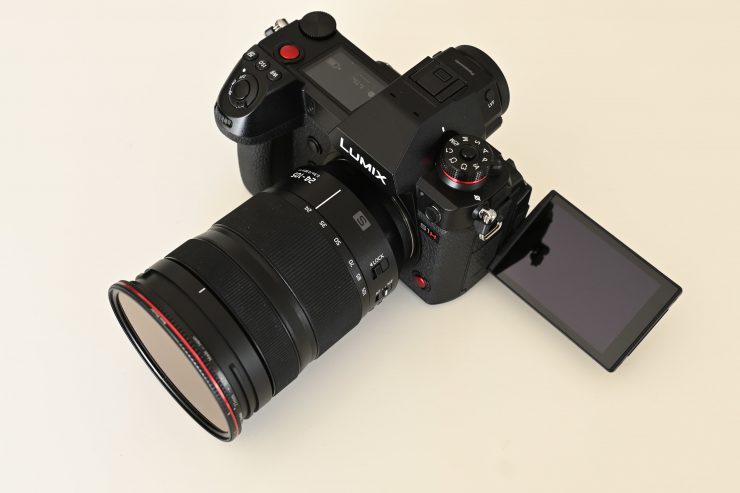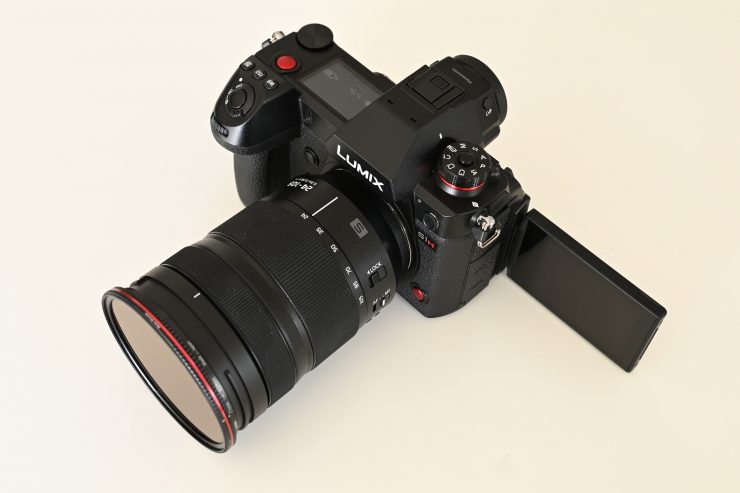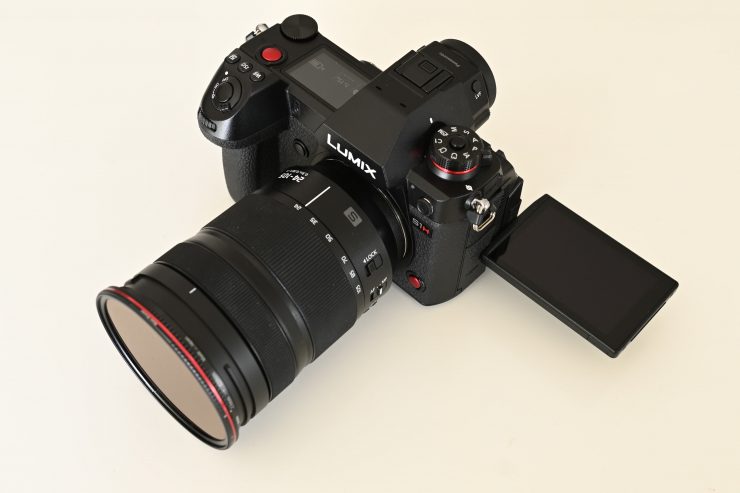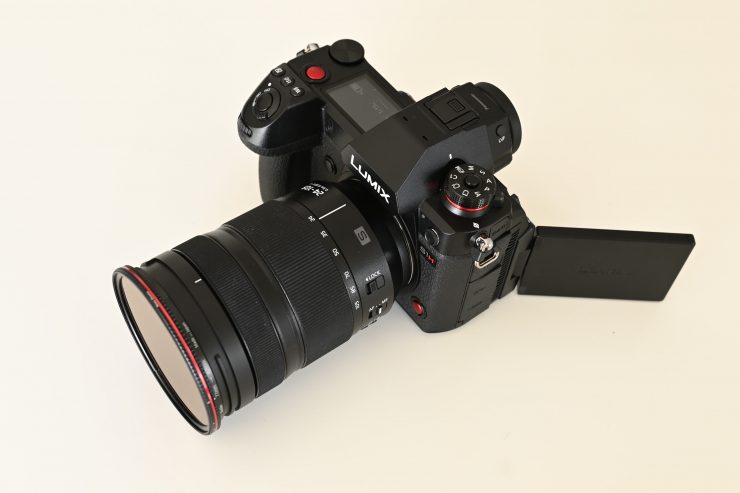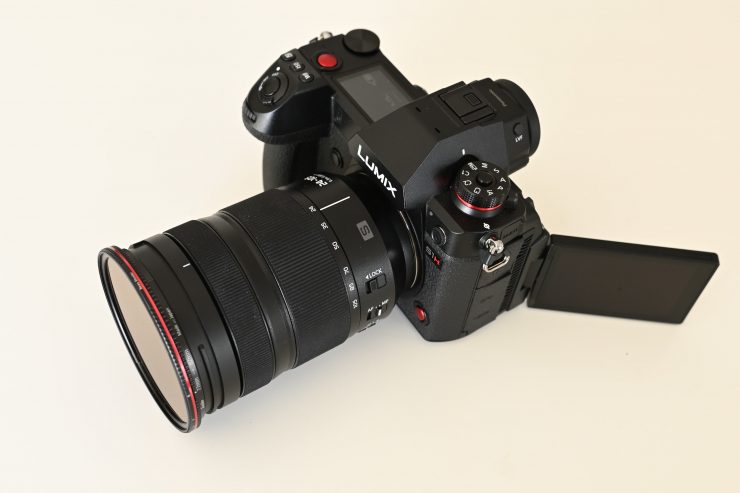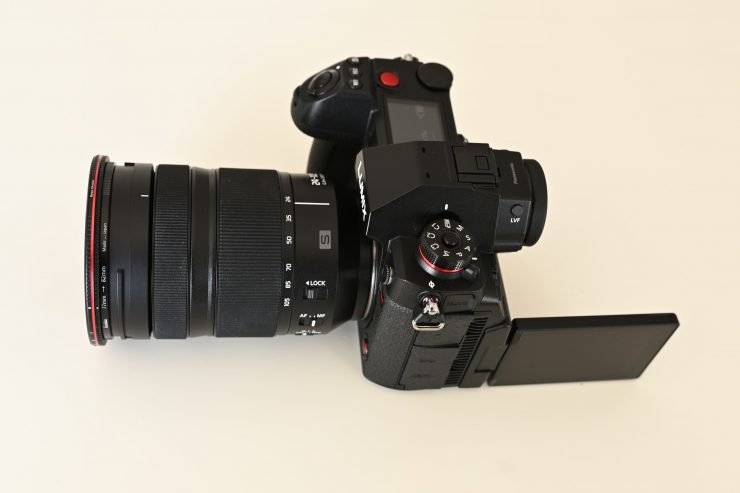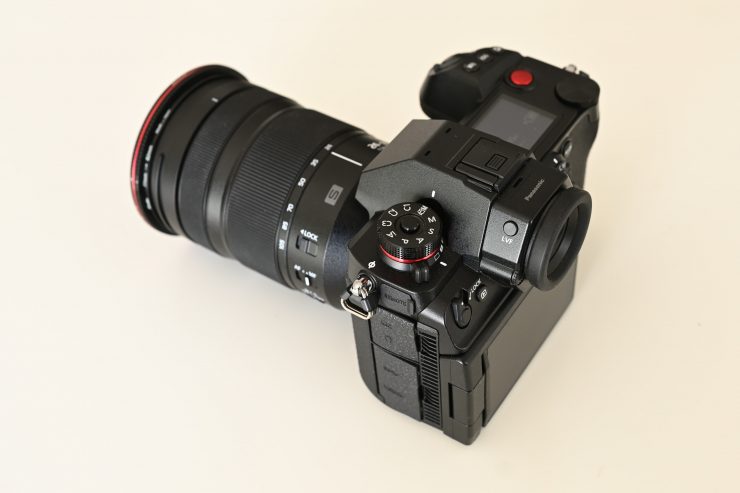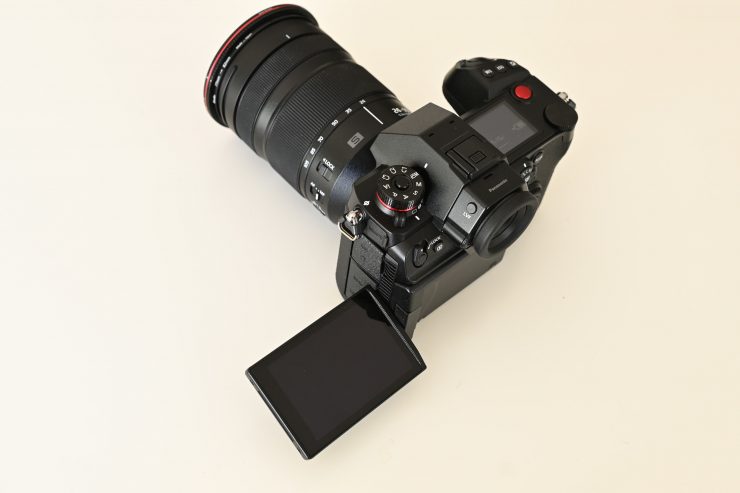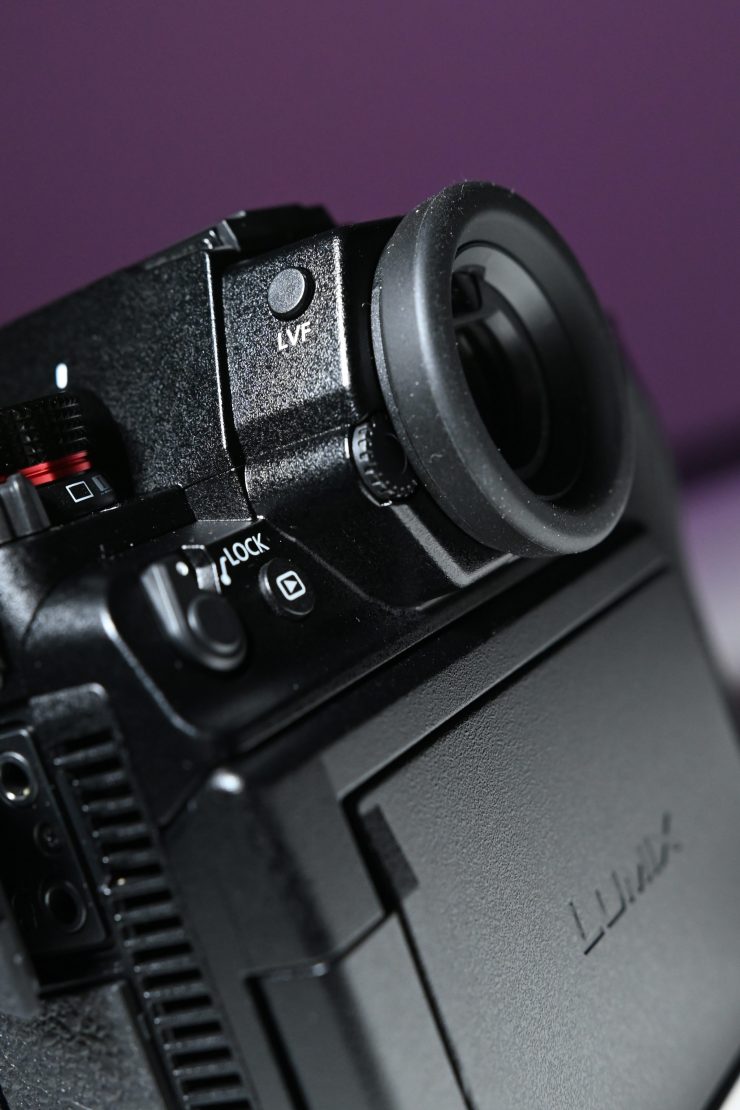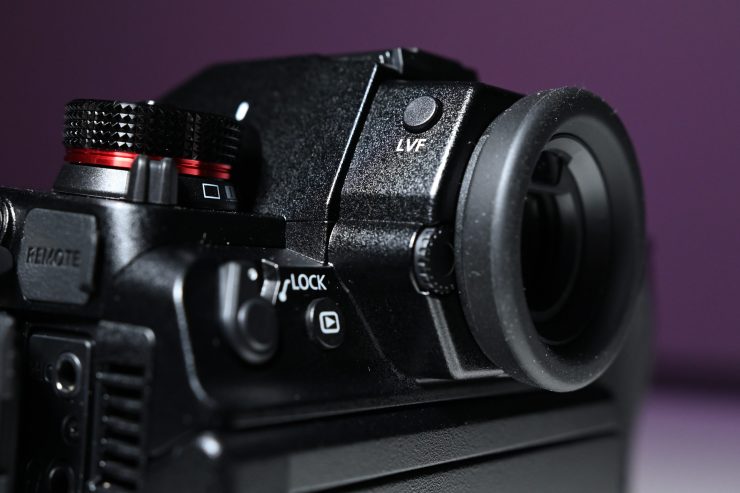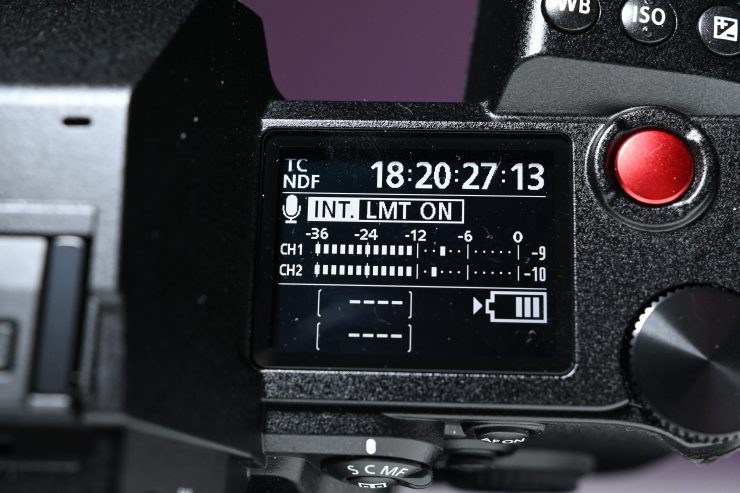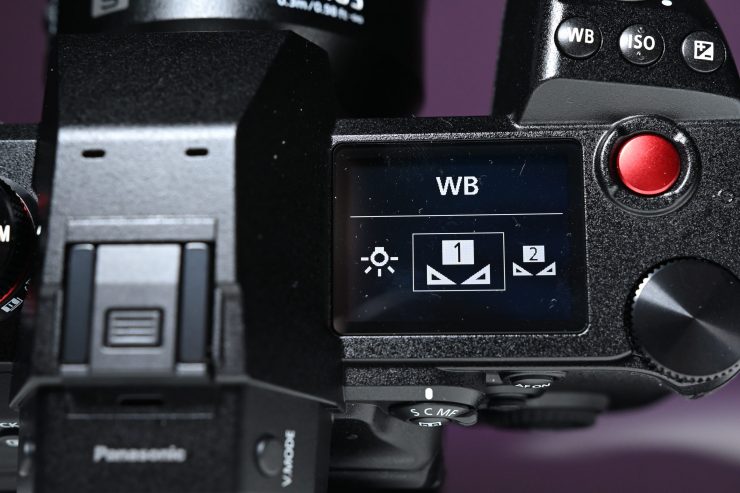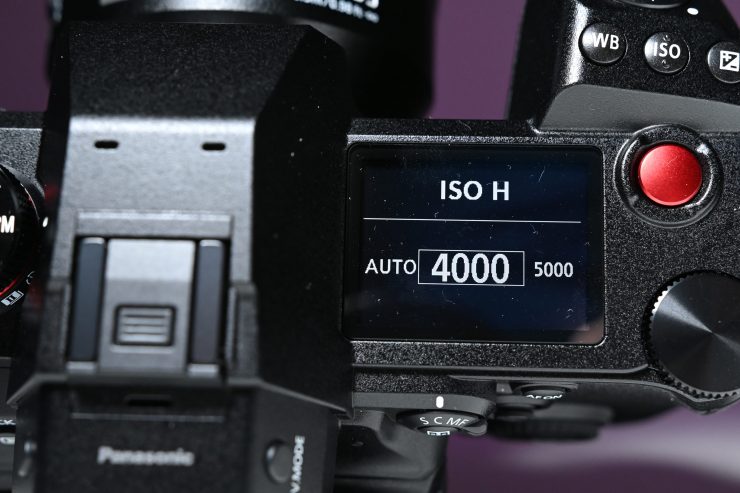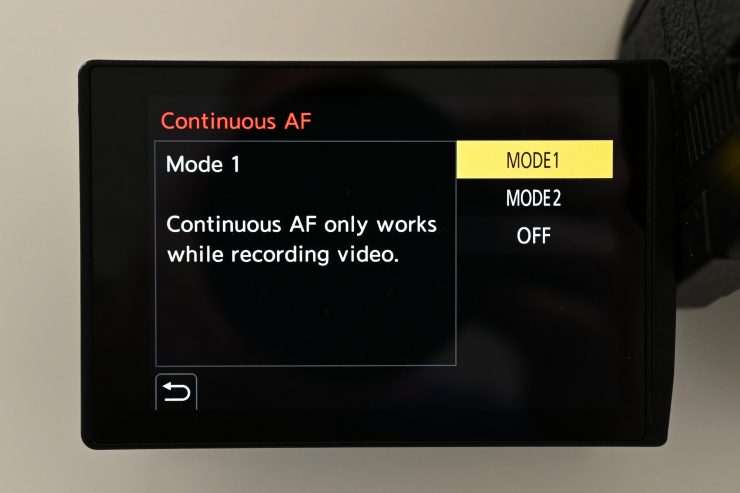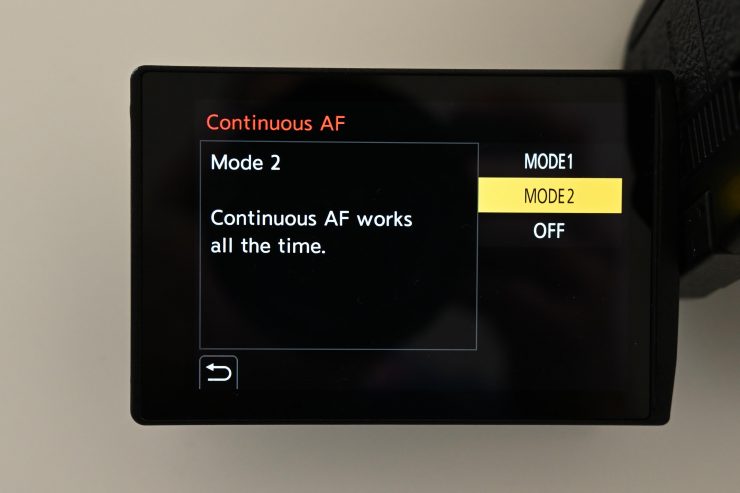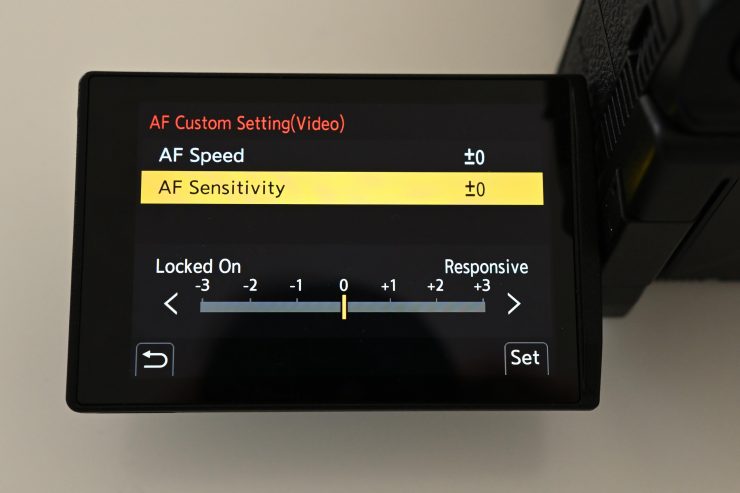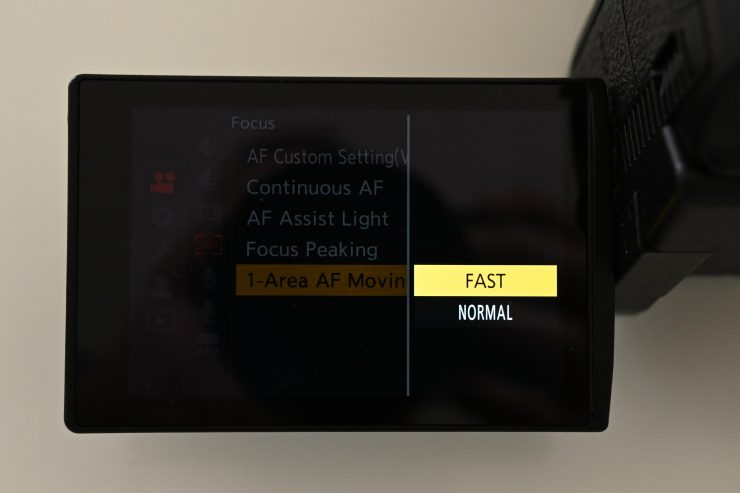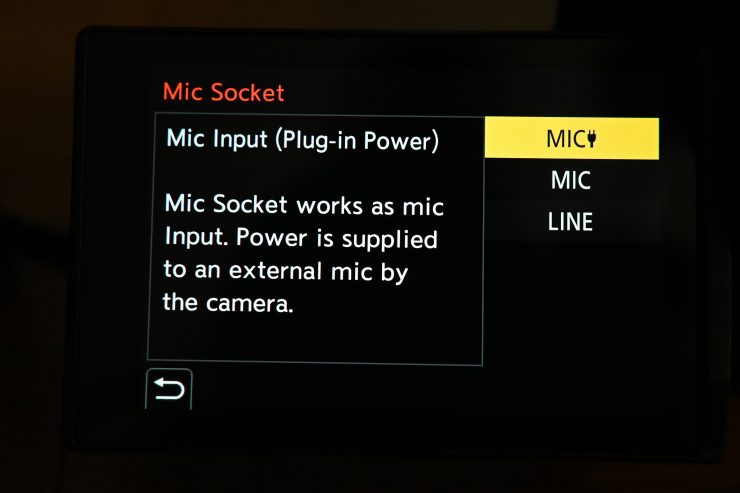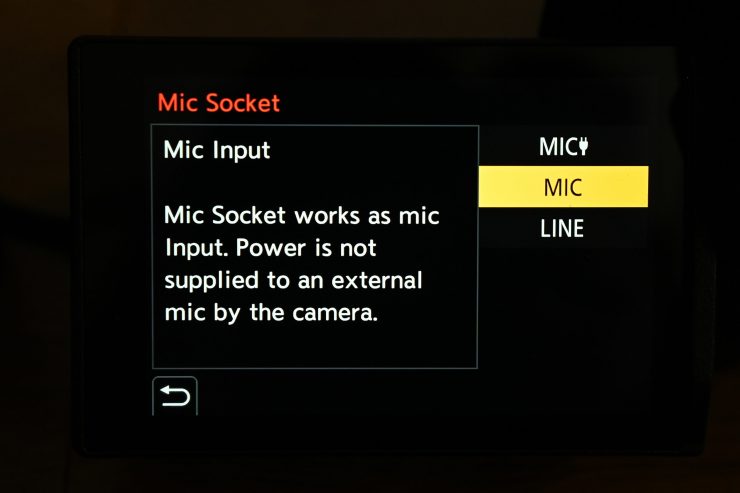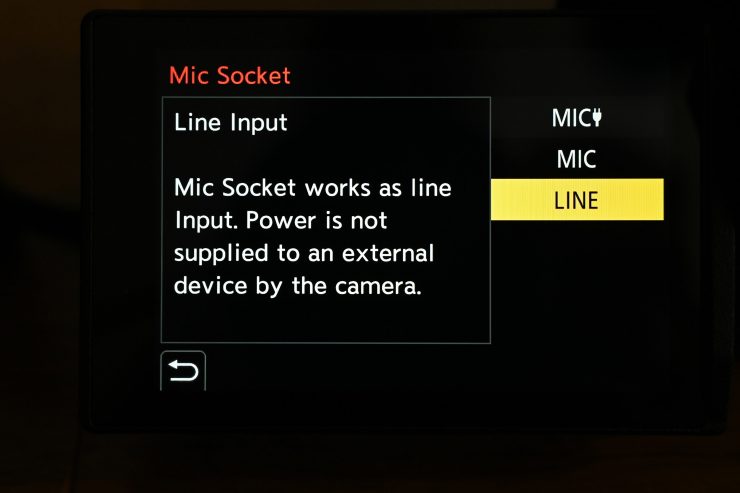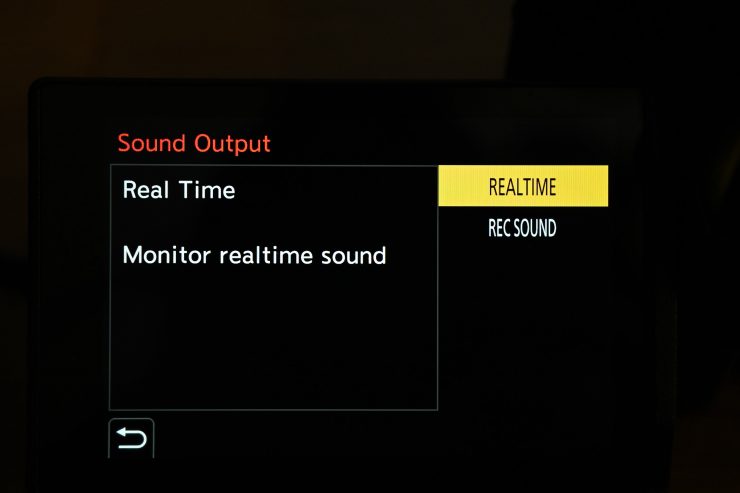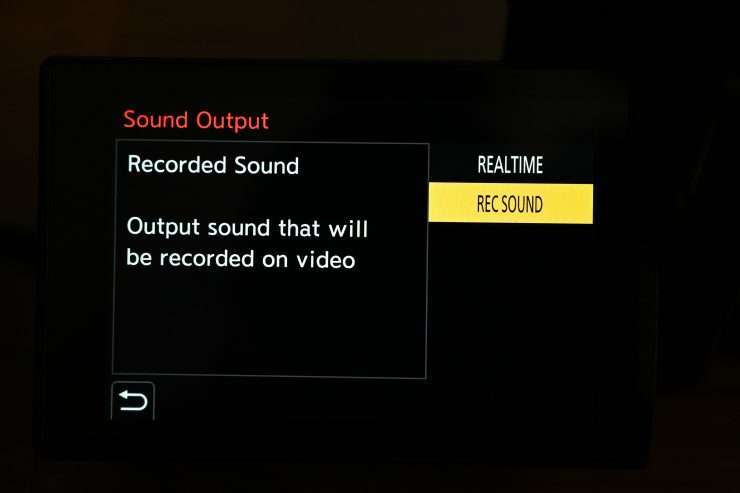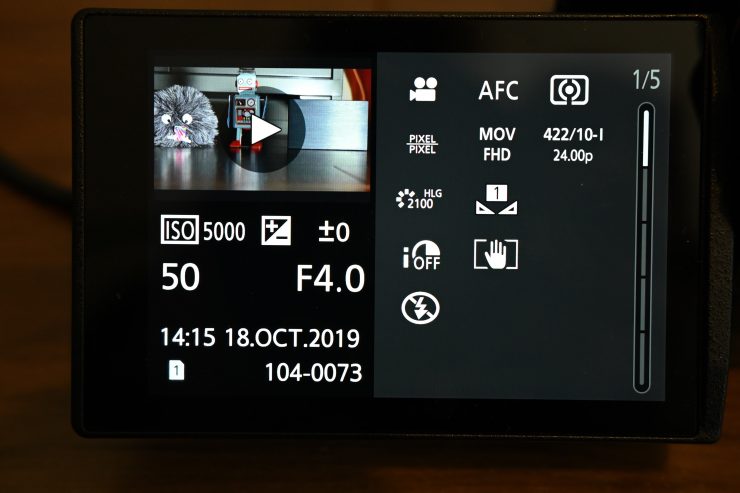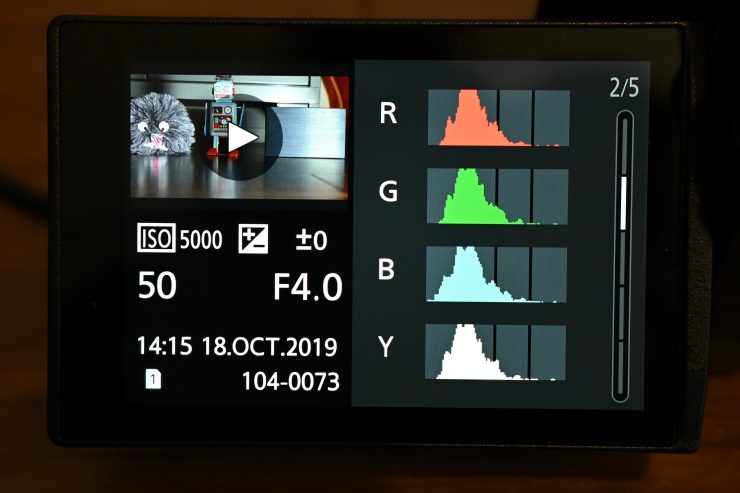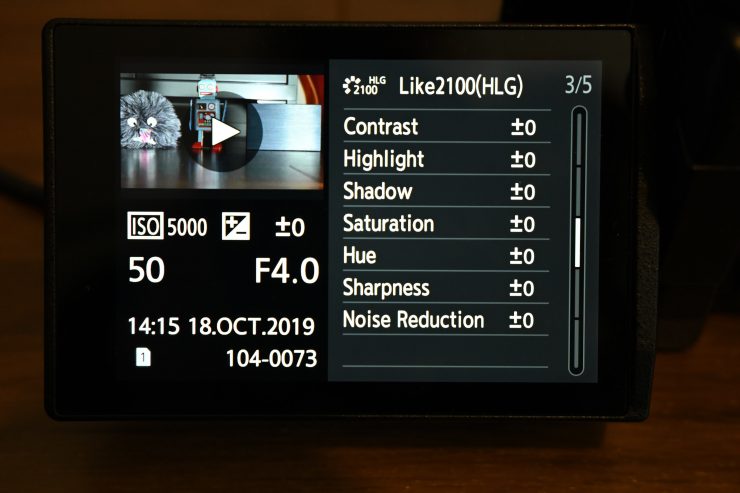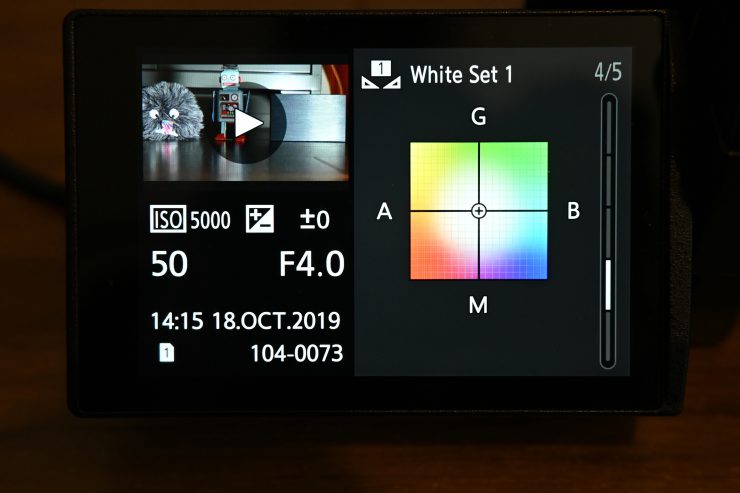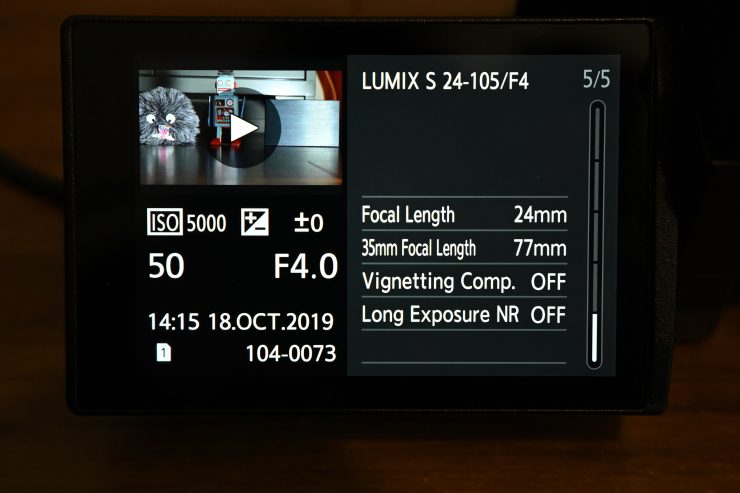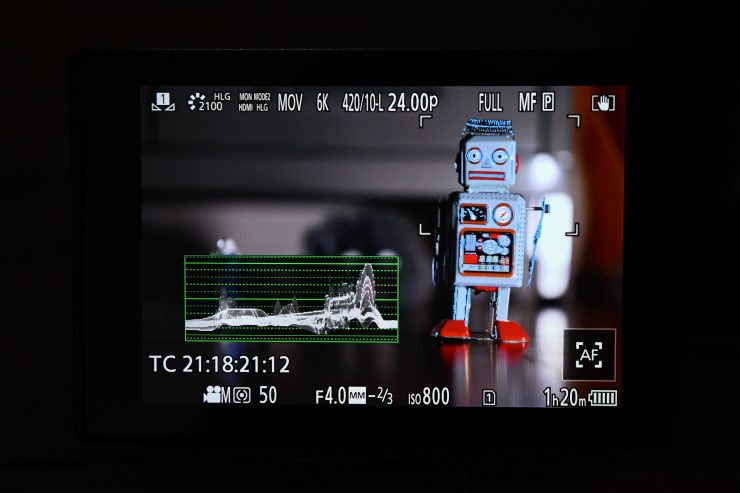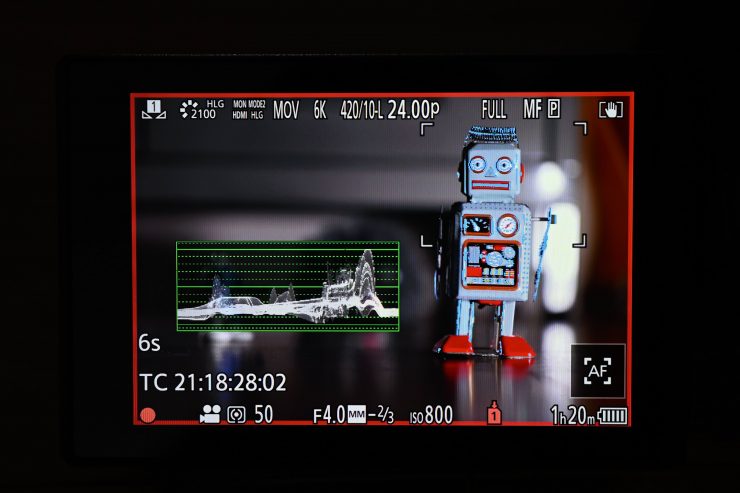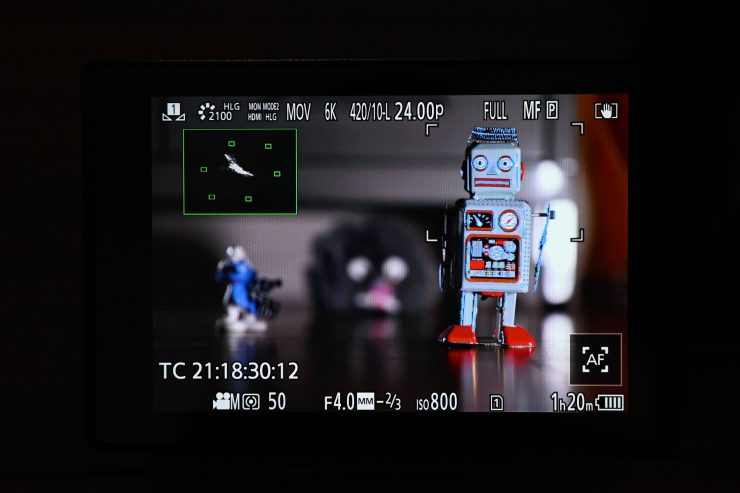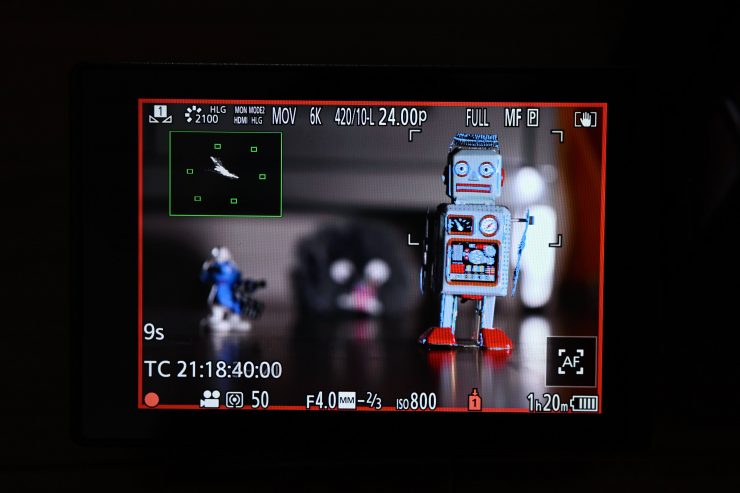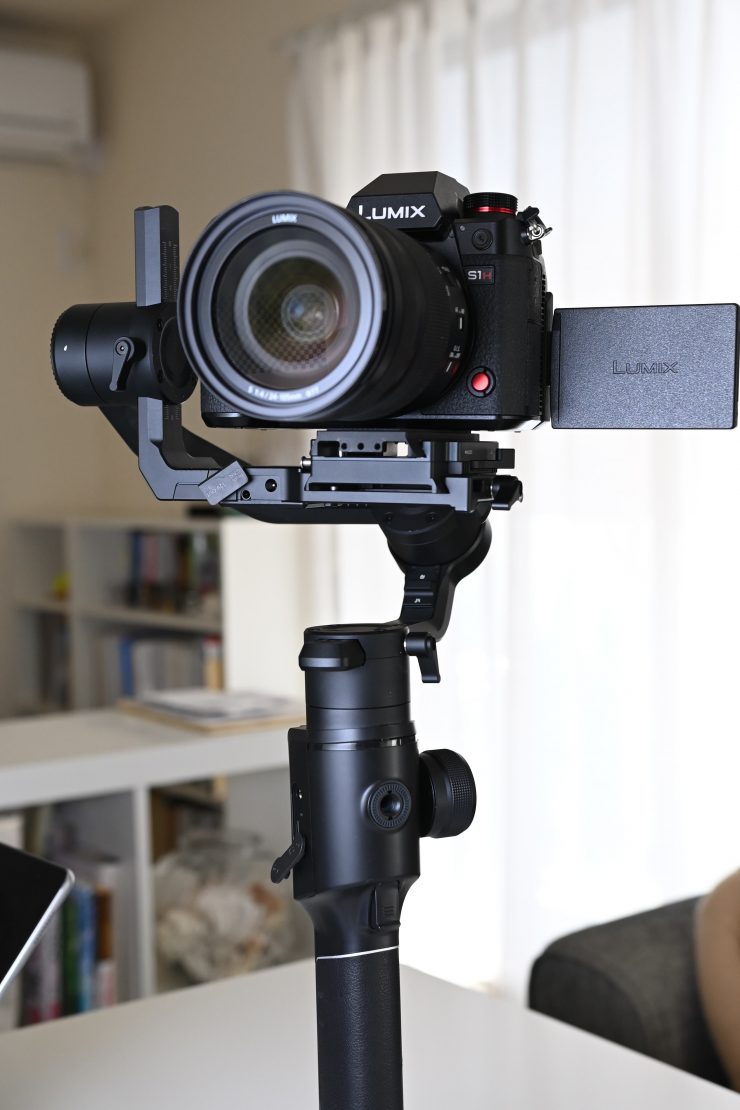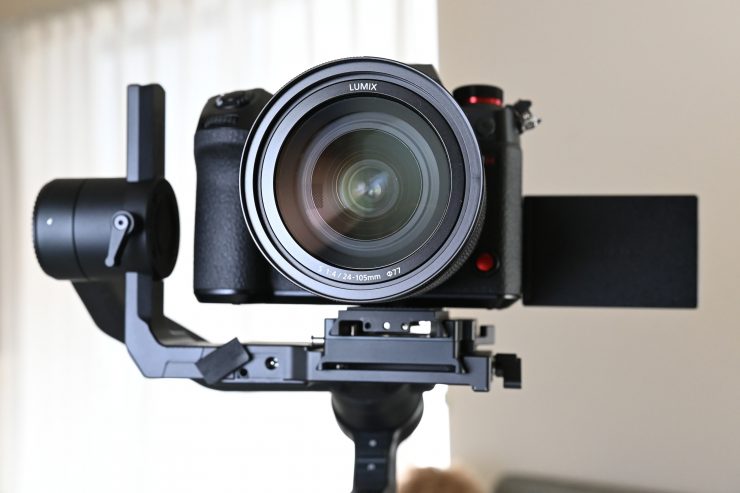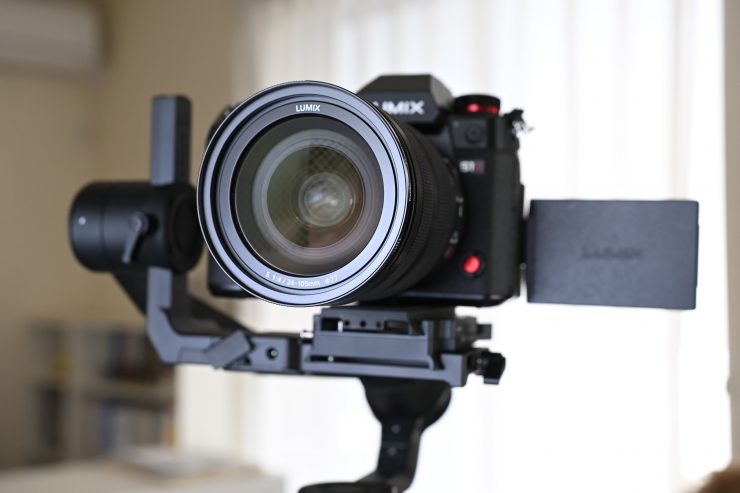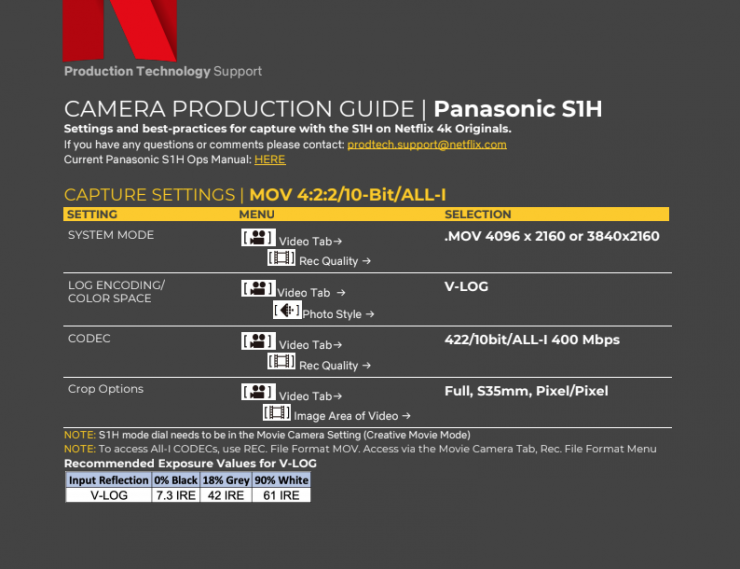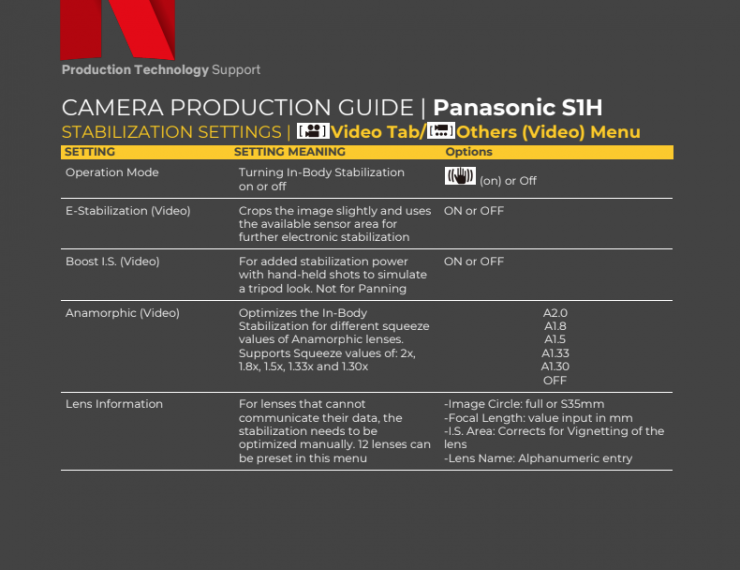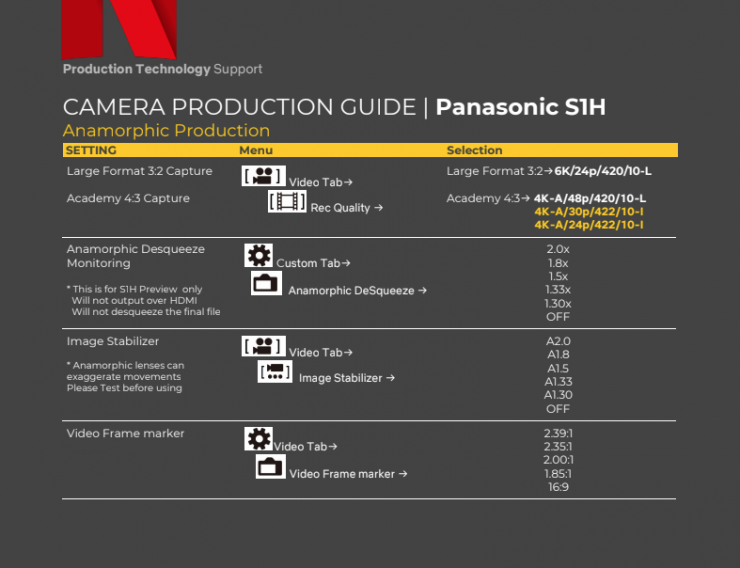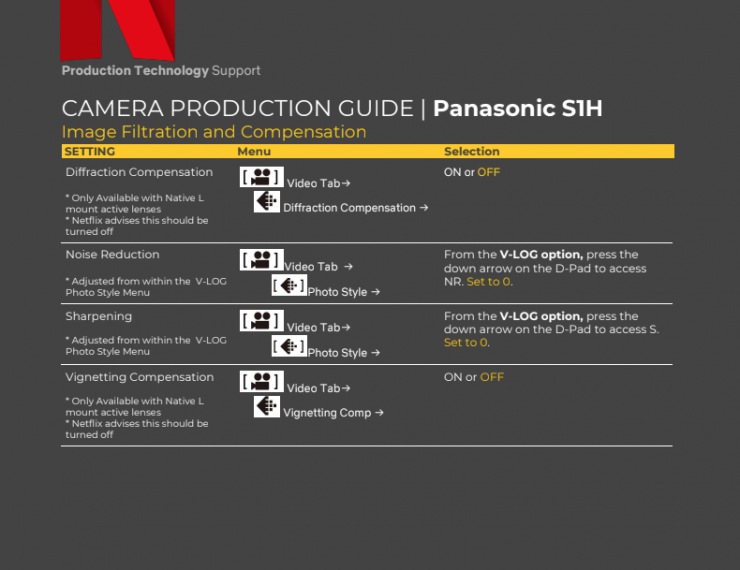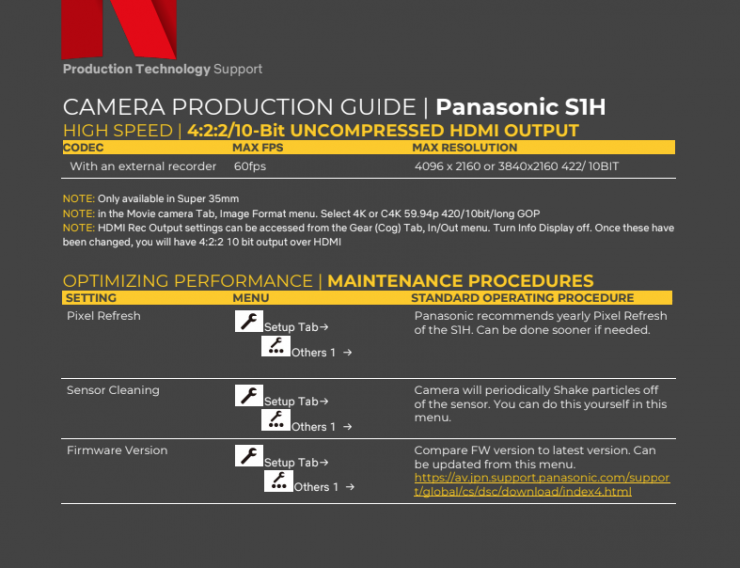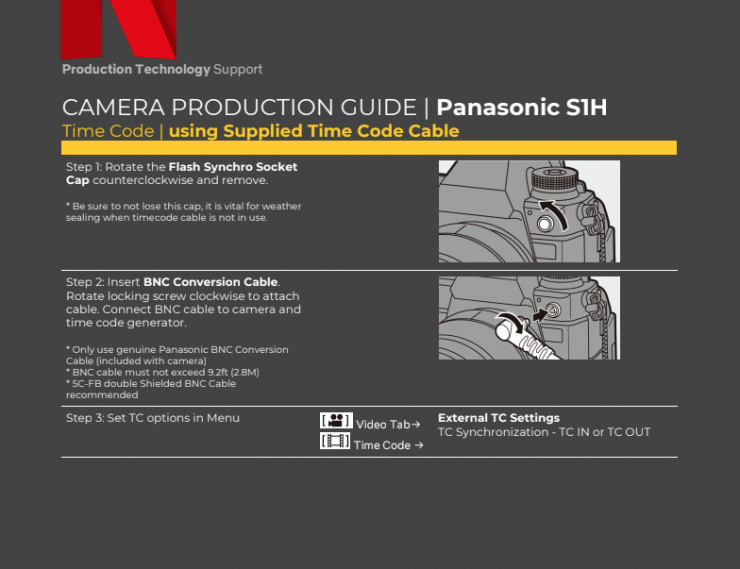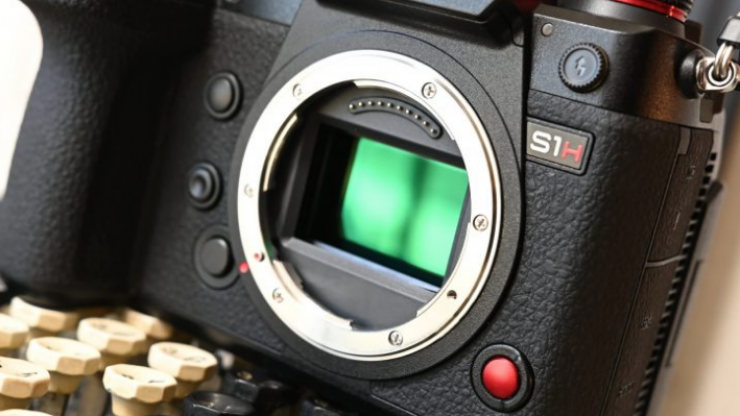
The Panasonic Lumix DC-S1H was unveiled at Cinegear earlier this year and the full specifications, pricing, and availability were announced at an event in Hollywood in August. I got to spend a short amount of time with a pre-production version of the camera at that event, but now I have a full production version to put through its paces.
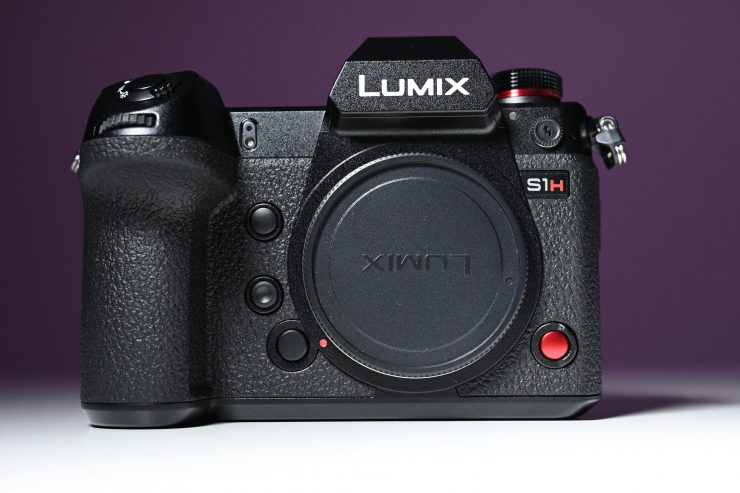
If you look solely at specifications, the S1H ticks a lot of boxes if you are looking for a high-end mirrorless camera for video. Not only can it record it 6K, but it can also capture full-frame 4K at up to 30p internally in 4:2:2 10-bit. We can all argue about the merits of higher resolutions, but it is impressive that a full-frame camera of this size can record 6K internally.
On the surface, there is a lot to like about the S1H, but what about if we dive below the surface? Well, let’s jump in and find out.
Please remember that a review can be very subjective. I encourage you to read and look at as many reviews as possible so you get more than one opinion.
Key features
- 24.2MP Full-Frame CMOS Sensor
- 6K24p Video
- 4:2:2 10-Bit DCI 4K/UHD 4K
- V-Log, Dual Native ISO
- HFR-up to 180fps in HD
- 5.76m-Dot 0.78x-Magnification OLED LVF
- 3.2″ 2.33m-Dot Tilt/Free-Angle Touch-LCD
- 1.8″ Top LCD, Tally Lamps, Dual SD Slots
- ISO 100-51200, Up to 9 fps Shooting
- Contrast-Detect 225-Area DFD AF System
- 5-Axis Sensor-Shift Image Stabilization
- ProRes RAW output in development for Atomos recorders
- Weather-Sealed Construction
Image Quality
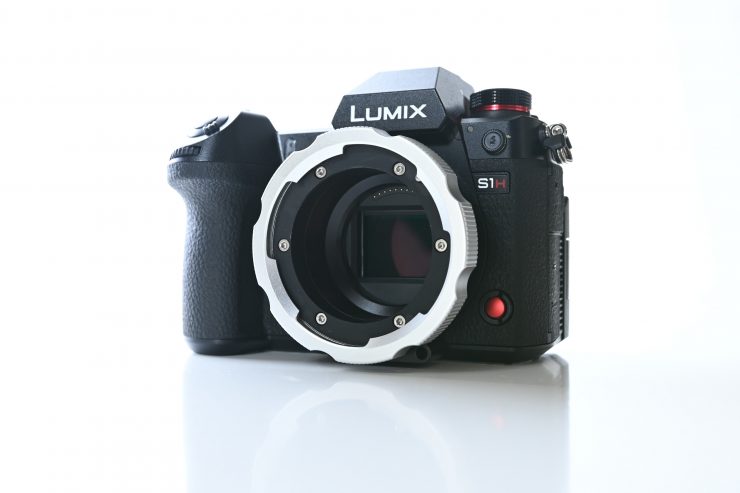
This is probably what the majority of people are going to care about, so I’ll address it first.
I think the S1H certainly is a very capable camera that can get you good results, but it is not without its flaws. If you don’t want to read through everything here is a quick summary before I dive in deep:
- Best image quality (in my opinion) of any currently available Mirrorless hybrid
- Very true and realistic color reproduction right out of the box if you are not using V-Log
- Good detail and fine texture when shooting in 4K 4:2:2 10-bit All-I
- Very robust 4:2:2 10-bit All-I internal codec
- Good dynamic range
My first impressions of the image quality of the S1H were mixed after using it at the event in Hollywood. Like most cameras in this price range, the camera looked nice in controlled lighting scenarios and in conditions that are favourable. Where I did notice that it seemed to struggle was in mixed lighting conditions. For me, this is what separates the lower end cameras from high-end digital cinema cameras. To be fair to the S1H, this also applies to quite a lot of other cameras that cost below $10K USD.
I also found that a lot of the images had noise levels that were higher than I was expecting when shooting V-Log, especially at the cameras 4000 dual native ISO. The VFR HD material at 180fps at 4000 ISO was also quite noisy.
So these were some of my initial thoughts about the pre-production camera, but I only got to shoot with the camera for a very limited time. Now that I have had a closer look at the image quality, have my views changed?
Well, yes and no. I like some of the images coming out of the S1H, but I find them to almost be too clinical, especially when shooting in 6K or 5.9K. It’s almost like they look artificial and there is a certain aspect of the image that doesn’t quite look organic. In saying this, there are so many parameters you can change with modern-day cameras that I don’t want you to get the opinion that the S1H can’t produce nice imagery. From lens choice to changing image parameters, to manipulating the look in post, there are so many ways the image can be changed.
With this in mind, the image characteristics of a camera that I am most interested in looking at are:
- Detail/texture
- Color rendition
- Highlight handling
- Organic feel
- Motion
One thing that did jump out to me (at least when not adjusting any camera parameters) is that the images if you look really carefully look smoothed out and lack detail and texture when shooting in 6K and 5.9K particularly. Maybe there is some sort of temporal noise reduction happening in the background when shooting in these resolutions

Above you can see a frame grab from a 5.9K shot with no spatial conform being applied on an HD timeline. I would expect to see a lot more detail and texture in this image.
When I was shooting with Panasonic 24-105mm F4 lens and not adjusting any of the camera’s image parameters I found the footage to be lacking any kind of emotion or feeling. The vision just seems to lack any depth or dimension.
That’s not to say that some of these aspects can’t be dealt with. By using different lenses, and/or filtration on the camera you can go some way towards getting a more organic looking image.
To be perfectly clear, there is absolutely nothing wrong with the imagery, but in my opinion, it is lacking something that I can’t put my finger on.
This is exactly what I found with the GH5 and is the main reason I ended up selling that camera. Please don’t start yelling at me in the comments section, this is just my personal opinion.
I also like to look at motion cadence, ie. how does the camera’s footage look at 23.98/25/25p. Does it appear to have the right amount of motion blur and feel to the image?
Now, there really isn’t anything that scientific when it comes to motion cadence. If you are running 23.98/24/25p with a 180-degree shutter then there shouldn’t be any noticeable difference between any camera with a CMOS sensor and electronic shutter. Whether you like motion cadence of a particular camera comes down to your personal perception more than anything. There could be factors that help influence motion cadence such as sensor read out speed and rolling shutter.
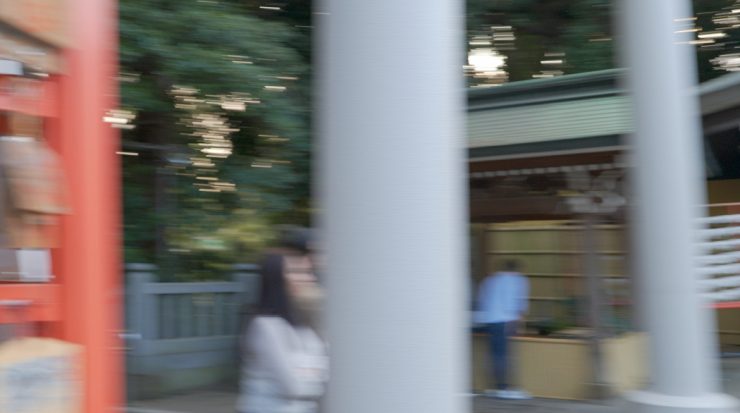
So does the S1H have good motion cadence? I personally don’t have any real concerns with the motion cadence of this camera. You do get some ghosting of the image on medium/fast pans where you will see parts of the image overlapping others, but this is fairly common on any camera.
All of the shooting modes (except HFR above 152fps) give you good results. So, let’s dive in deeper and have a look at image quality.
Overall Image Quality Impressions
If you don’t want to read through everything I’ll do a quick sum up. In my opinion, the S1H offers the best out of the box image quality of any mirrorless hybrid camera on the market today. It’s certainly not without its flaws, but if you know the camera’s strengths and weaknesses you can obtain good results.

If you are just shooting in the standard, HLG, or non V-log picture profiles, the colors are very good. Above you can see what the 709L profile looks like without any tweaking. This was shot with just available light.
Look, there is no doubt that the camera is extremely capable in the right hands. I have seen some incredible imagery from the camera on the big screen. However, any camera can look good in controlled conditions with good lenses, good lighting, and good color grading. For me personally, I wanted to see how the S1H would perform in uncontrolled conditions where the camera needs to adapt to where and what I am shooting.
I didn’t set out to shoot anything that was just going to make the camera look good, because, for a review, that can be misleading. I wanted you to be able to see the good, the bad, and the ugly.
6K & 5.9K
The above video was uploaded in full 5.9K, but whether YouTube ends up processing it at 5.9K who knows!
Apparently YouTube keeps native resolution above 5K (2880p) so the video is 5.9K even though the upload only shows 2880p 5K. You will need to use Chrome, Firefox or another browser that supports higher resolutions as Safari is limited to 1080p/1440p.
6K (5952 x 3968) is recorded as 200Mbps (4:2:0 10-bit LongGOP) H.265/HEVC. Despite being 4:2:0 10-bit and not 4:2:2 10-Bit ALL-I it doesn’t seem to matter. I could pull the images around in post without seeing any color banding or having the image fall apart. I do, however, think that there is some sort of temporal noise reduction going on in the background. As I mentioned earlier I’m not seeing fine detail and texture in the footage.
The 6K and 5.9K images are nice, but as I mentioned earlier, there’s just something about the footage that doesn’t quite seem right.
At the top of this section, you can see some example footage recorded in 5.9K. All of this vision was taken without a tripod. I have tried to include a variety of uncontrolled shooting environments so you can see how the camera performs. I haven’t done any grading to the images.
It’s nice to be able to shoot in these resolutions if you have to deliver in UHD or HD. They give you a lot of breathing room for cropping and post stabilizing your images if need be.
4K & UHD 4:2:2 10-bit
If you are shooting in 4K DCI or UHD at up to 30p you can do so in 4:2:2 10-bit. This is the beefiest codec option available on the S1H.
Despite all the marketing hype with 6K, I think shooting in 4K/UHD is the S1H’s sweet spot. To my eye, there seems to be more detail and texture to the images than when shooting in 6K or 5.9K. In the clips below this is what you can expect when shooting with none of the parameters of the camera changed. I could have manipulated the images in any way I wanted and created entirely different looks, but I want you to see what the camera produces straight out of the box.
All of the material I shot that is above was done hand held using the Pansonic 24-105mm F4 lens in Full Frame, S35mm, and Pixel/Pixel modes. I did this because I wanted to see what was possible to shoot with just one lens and no tripod.
Just to show you something different and to show how easily you can change the look, above you can see a few shots I did in V-log using a very old 38mm F2.8 lens.
I personally would prefer to shoot in 4K DCI or UHD in 4:2:2 10-bit than any other mode on the S1H. I found that the 4:2:2 10-bit ALL-I material was very robust and easy to grade without having any problems with the image falling apart.
How does it handle highlights?
I wanted to see how the camera handled highlights so I looked at a scene that challenges any cameras dynamic range and highlight handling. In this scene, I was getting IRE readings from as dark as 8% all the way up to the mid to high 90s.
I then connected the S1H up to a Convergent Design Odyssey 7Q+ as it has a very clever spot meter function that can give me accurate IRE readings.
Above you can see that to expose the scene without clipping any highlights the S1H (in V-Log) was giving me an IRE reading of 88.
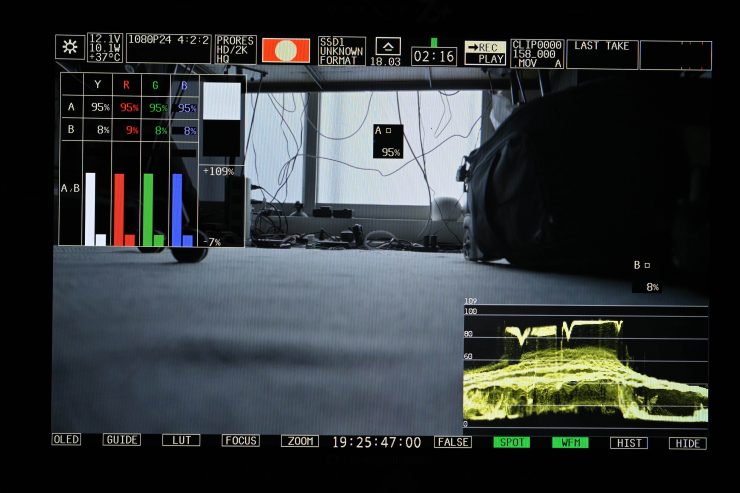
If I tried to open up the iris slightly more I started to clip highlights. At 95 IRE it was hard clipping highlights.
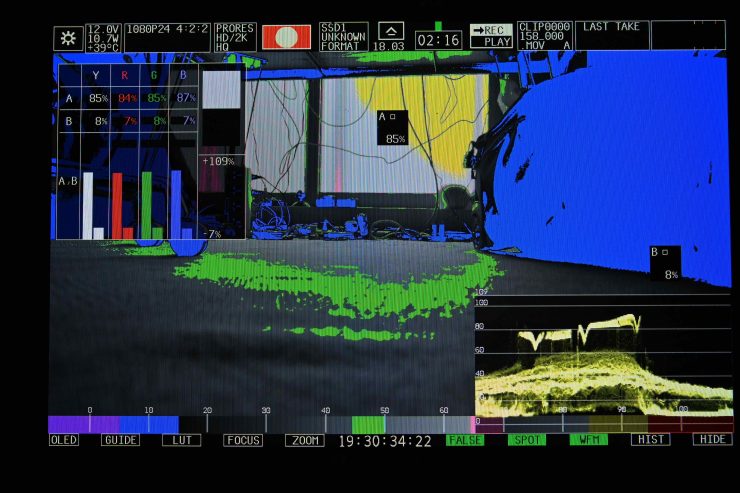
When I moved to the camera’s other dual native ISO of 4000 I could expose at 85 IRE before highlight clipping occurred. This shows me that at 4000 ISO the camera doesn’t quite have as much highlight handling as when used at 640 ISO.
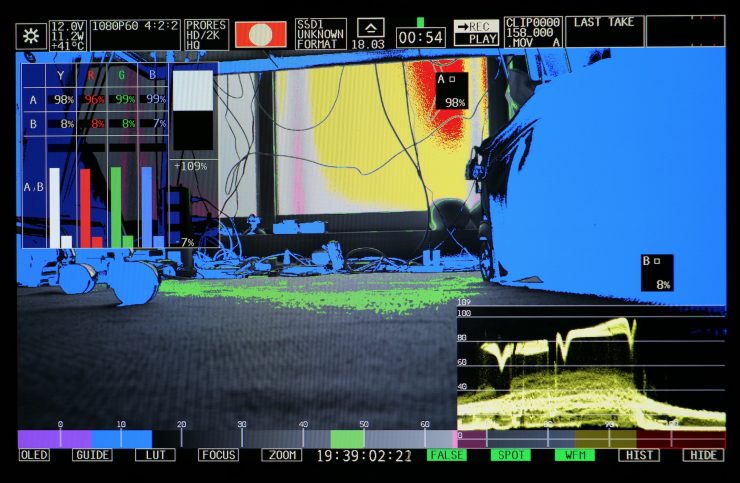
Nikon Z6 Z-Log 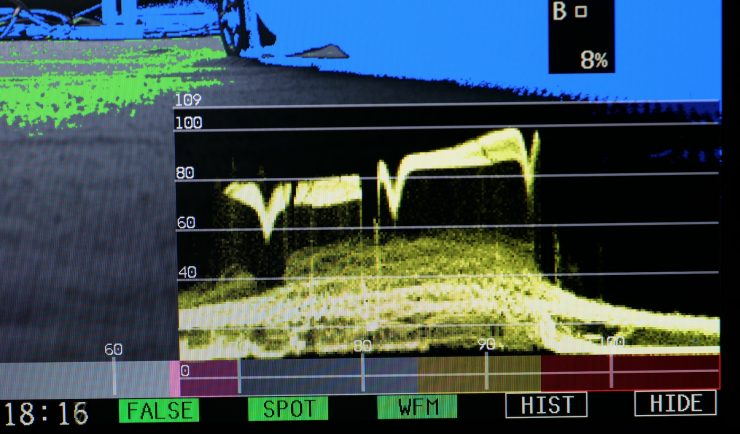
Nikon Z6 Z-Log
Just as a quick comparison I did the same test with a Nikon Z6 shooting Z-Log at 800 ISO. I could push the Z6 to 98 IRE before it would start losing detail in highlights. But as you can see, the highlight roll-off appears to be better than the S1H, at least on a scope.
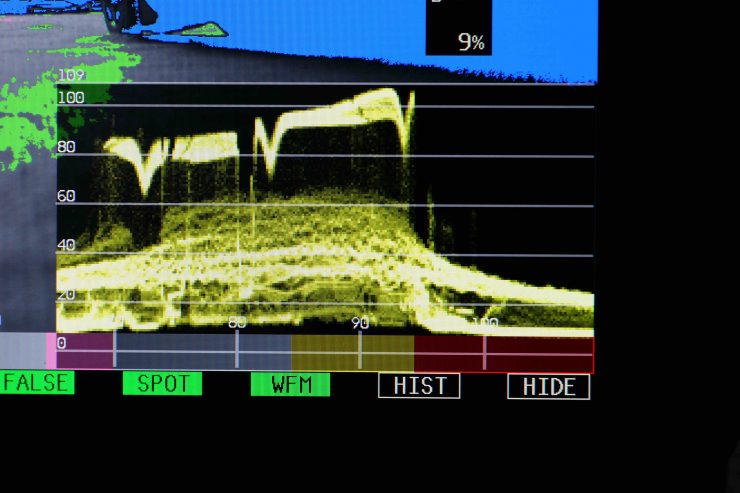
Nikon Z6 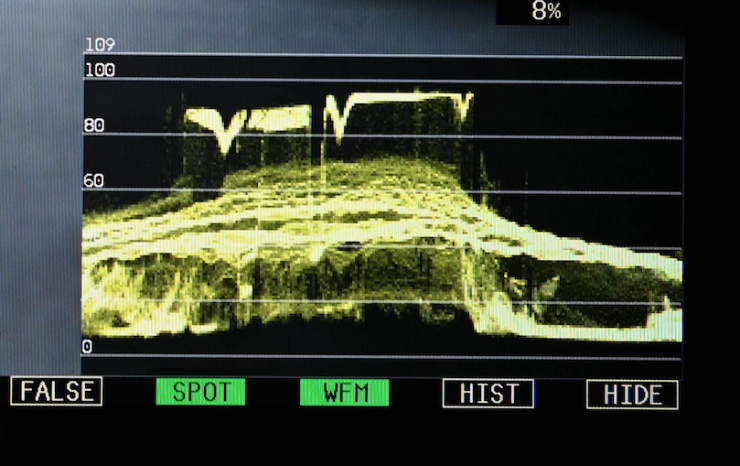
Panasonic S1H
In fact, I could push the Z6 over 100 IRE and while it lost highlight information the roll-off was still smooth. If you look at the S1H the highlight roll-off doesn’t appear to be as smooth, and it is clipping highlights a lot earlier. However, it is important to point out that the S1H is able to show more information in the mids and it doesn’t crush the blacks as much.
As another test, I shot a short clip at 640 ISO in V-Log and exposed so that I wasn’t getting any highlight clipping. Above you can see the V-Log and a graded version of that shot. I have graded the shot so the information in the scene covers an IRE range from 0 to 100.

V-Log 640 ISO 
Graded V-Log 640 ISO
Above you can see the scopes for the V-Log and then the V-Log graded images.
Despite the highlight roll-off being quite aggressive on scopes, when looking at actual real-world images it isn’t nearly as bad as the scopes indicate.
The S1H does have an adjustable knee setting and master pedestal. Can you adjust these to obtain better highlight roll-off? If you have V-Log or HLG selected you can’t make any adjustments to the master pedestal or knee settings.
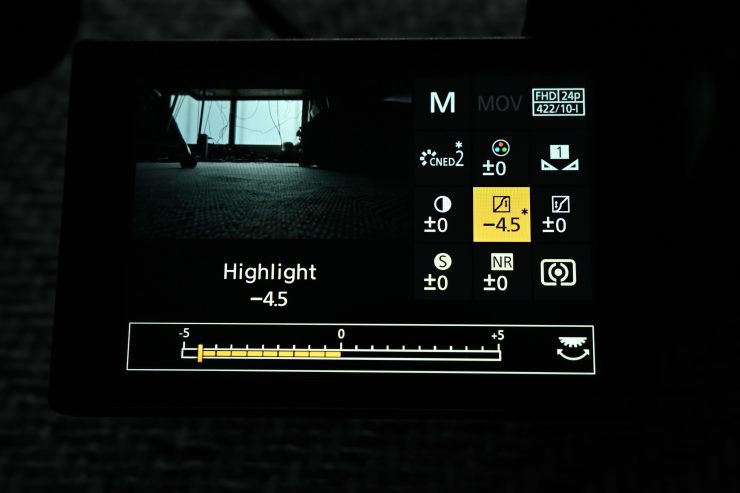
CineD 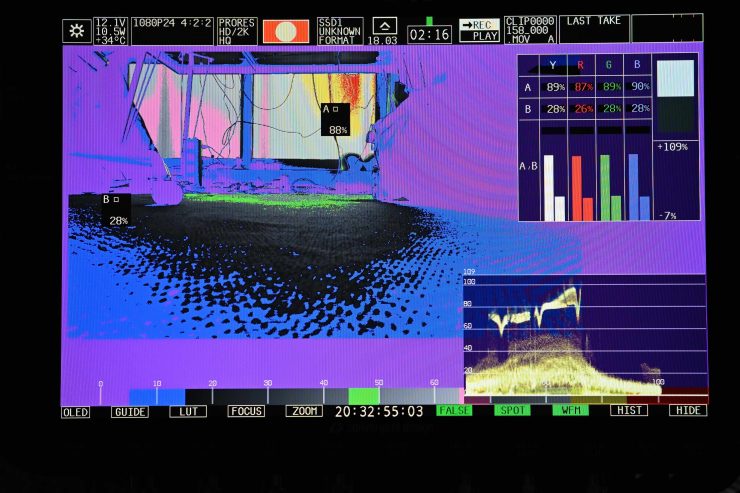
CineD 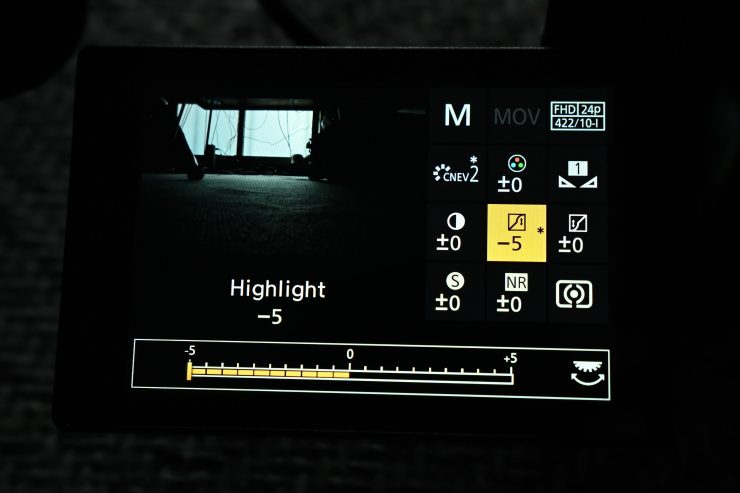
CineV 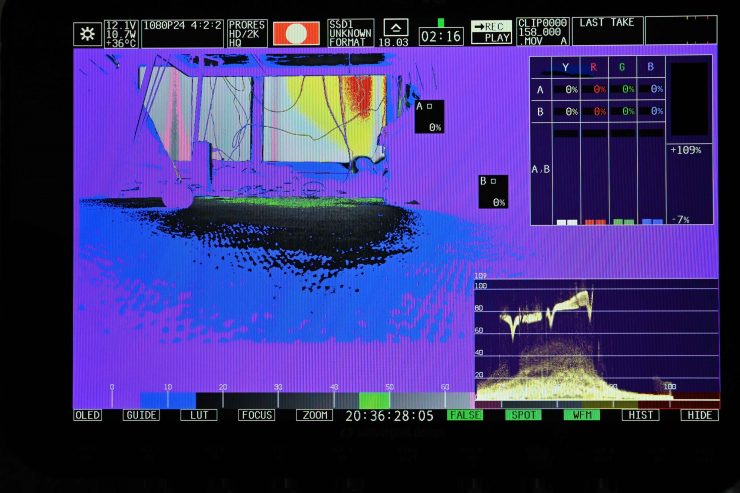
CineV
I did try setting the S1H to CineD and CineV and changing some of the image settings. While I couldn’t get any more information in the highlights, the roll-off was a lot smoother than when shooting in V-Log or HLG. The downside is, by adjusting the image parameters of both CineD and CineV you lose a lot of information in the mids and shadows. You could do this if you were shooting a very bright scene with not a lot of dynamic range where you wanted to have a slightly smoother highlight roll-off. Just to be clear, this isn’t a magical solution, it is just an alternative way of dealing with highlight roll-off.
Dynamic range
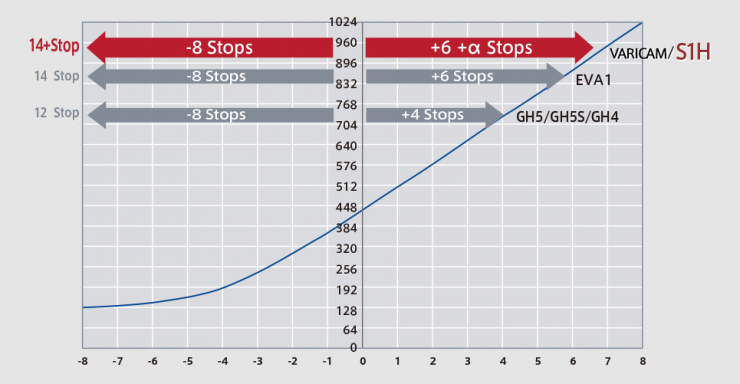
While the camera has a good amount of dynamic range, out of the claimed 14 stops, 8 of those are below middle grey. This is the same as the Varicam LT and Varicam 35, and EVA1.
This is why it is important to do real world tests to check dynamic range. The amount of stops a camera has doesn’t mean anything if the highlight handling of the camera isn’t great. The S1H may well have 13-14 stops of dynamic range, but it doesn’t roll off highlights as smoothly as I would like, and it hard clips them before you get anywhere near 100 IRE.
Compared to the GH5, GH5S, or GH4 you should see quite a significant improvement in highlight handling and dynamic range with the S1H.
The overall dynamic range of the S1H is good and if you can’t work with the DR the camera has you are doing something very wrong.
Blue Channel Color Bleed
On the pre-production version of the camera, I noticed a slight highlight bleed in the blue channel when the camera is challenged. This only seems to happen with the color blue. Strangely this doesn’t occur if you shot in HLG.
Panasonic was aware of this problem and it looks like they did do something to fix it. When I asked Panasonic, I was told that Japan made improvements on the mass production S1H to improve color matching to the Panasonic pro video line up including Varicam / EVA 1. This improvement looks like it did go some way towards rectifying the issue, but it is still there.
Interestingly enough, Panasonic is releasing a firmware update shortly for the S1 and S1R that rectifies this problem.
Low light performance
A lot has been made about the camera’s dual native ISO feature (there is more about this further down in the review).
So how does the camera perform when you start increasing the ISO? I was reasonably impressed by the high ISO performance of the S1H. ISO performance can be hard to quantify as it really depends on what conditions you are shooting in. If you are shooting in conditions where everything in your scene is dark, you will, of course, see more noise. If a good proportion of your scene can be exposed correctly, then the noise levels are less distracting, even when shooting at higher ISO levels.
I personally don’t like shooting anything above 5000 ISO regardless of the camera I am using. But depending on the type of work you are doing you may find yourself having to push ISO levels to get that shot that couldn’t otherwise be captured.
You can adjust the amount of noise reduction being used regardless of what picture profile you are using. In V-Log it is set at the lowest default level of 0. You can adjust it up to +10. On all the other picture profiles it also defaults at 0, but you can adjust it from -5 to +5.
I would use the noise reduction very carefully if you plan on having it on. Even Panasonic clearly states that Increasing the effect may result in a slight drop in picture resolution.
To cut a long story short, you are better off staying clear of V-log when shooting in low light conditions. You get much cleaner results using something like HLG. If you don’t want to look at all the tests, I’ll sum it up by saying that the S1H is a very impressive low light camera.
For the first tests I didn’t want to shoot completely dark scenes, instead, I wanted to see what the noise looked like when you could still obtain decent exposure. In all of the below tests, you can see what the noise looks like on black, grey, colors, dark and light objects. As far as I am concerned, if you are shooting in conditions where you are having to run your ISO above 8000/10000 then noise is probably going to be the least of your problems.
In 4K full frame, I personally found the ISO levels to be very acceptable up to around 8000 ISO. You could go as high as about 16,800 ISO, after that you will see fixed pattern noise.
In C4K (S35mm frame size) the ISO performance is not all that different from when shooting in full frame. There is a little bit more noise, but it’s not a substantial increase.
I found that in HD full frame I would comfortably shoot up to around 6400/8000 ISO with no real concerns. I personally think ISO levels up to around 16,800 ISO could be used if you really had to. From 16800 ISO and above you do start to see fixed pattern noise.
If you shoot in HD using the S35mm frame size, you will see slightly more noise than when shooting in full frame.
If you use the Pixel/Pixel frame size you will see a lot more noise, but that really isn’t too much of a surprise. I found that at 4000/5000 ISO the noise levels were too much for my liking. If you are going to use the Pixel/Pixel frame size setting you don’t want to be shooting in low light situations.
In 6K (5952 x 3968) the noise levels are not too bad, but I do personally think they are a little higher than when you are recording 4K.
Above you can see 5.9K in HLG. I think this picture profile offers good results in low light conditions.
Above you can see 5.9K in V-Log. There is a lot more noise present in V-Log than when shooting in other profiles. This is to be expected.
If you want to see how the S1H compares against the Sony a7 III and Nikon Z6 in low light, you can see a test towards the end of this review.
Internal Sharpening
You can turn the internal sharpening down anywhere from 0 to -5 in V-LOG if you think the images are too sharp. All of the picture profiles offer a sharpening setting of -5 to +5.
Color
It is fairly easy for any camera to reproduce a single color (for example a blue sky) but where it is a lot more challenging to reproduce lots of different colors accurately at the same time.
Generally, I like the color science of the S1H. Colors look nice and neutral. I found like most Panasonic cameras, the S1H is a little on the warm side with a slight push towards magenta.
Color accuracy is a hard one to judge as both lenses and lighting will play a factor in how color is perceived.
The camera replicates colors nicely out of the box. and if there is one thing Panasonic does tend to get right, it’s pretty accurate color rendition. Skin tones out of the box look nice. Skin tone tests on modern cameras are a bit of a waste of time to be honest because any color can be turned into accurate skin color by adjusting primary color temperature, and adjusting hue and brightness. The only thing you can actually test for is how accurate it is out of the box when making zero adjustments in post.
I found the colors are very reminiscent of the EVA1 and Varicam LT and you would struggle to tell those cameras apart in good shooting conditions.
For news, documentary and event shooters who need to turn material around quickly and can’t shoot in a Log profile or grade the image at all, the S1H is a very good choice. I found that I didn’t have to do anything to the images for them to look pleasing to the eye.
If you need to turn around material quickly then the HLG profile or i[Cine-like D2] / [Cine-like V2] are good profiles to shoot in.
I did find that the camera struggles a bit in mixed lighting conditions when it comes to accurate color rendition, but again, this is common among more affordable cameras.
Anamorphic 4K 3328×2496
As one of the selling points is the anamorphic modes I also shot some material in 4K 3328×2496 at the event in Hollywood a few months ago. Above you can see some of those shots. Now, I purposely wanted to shot some shots in a variety of different conditions to get a feel for how the camera reacts.
All the shots were done on an Atlas 40mm and 100mm T2 anamorphic. Please note the above vision was shot with a pre-production version of the camera.
How does the image quality compare to the BMPCC 6K?
Despite being two completely different types of cameras, I’m sure you all want to know how the images compare. Both cameras can internally record 6K. In the case of the S1H it is done as a 4:2:0 10-bit LongGOP H.265/HEVC file. On the BMPCC 6K, the files are recorded in Blackmagic Raw.
I personally prefer the look of the images coming from the BMPCC 6K out of the box. I find the footage has a more organic look (when compared to the S1H in 6K or 5.9K) and it’s sharp without looking artificially sharp. That’s not to say that the S1H can be made to look just as good (especially in 4K with a bit of work).
The caveat with the BMPCC 6K is it has a host of usability issues that can only be addressed by adding a lot of extra items to the camera.
What can it record?
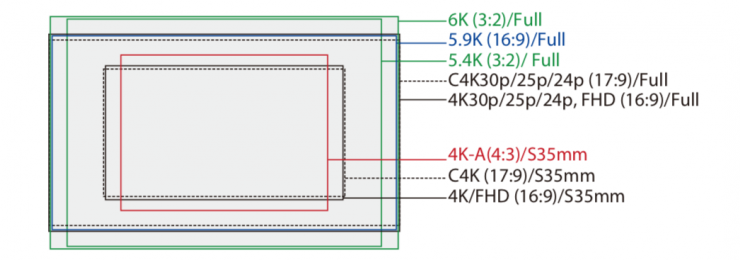
The S1H is the World’s first full-frame mirrorless camera capable of recording at 6K (5952 x 3968 23.98p (3:2 aspect ratio), 5.9K (5888 x 3312) up to 30p (16:9 aspect ratio), and 5.4K 5376 x 3584 (3:2), So what bitrate and codec can you do this in?
FULL FRAME MODE
| 6K (5952 x 3968) 23.98p/24p (3:2 aspect ratio) | 200Mbps (4:2:0 10-bit LongGOP) H.265/HEVC |
| 5.9K (5888 x 3312) 23.98p/24p/25p/29.98pH | 200Mbps (4:2:0 10-bit LongGOP) H.265/HEVC |
| 5.4K (5376 x 3584) 23.98p/24p/25p/29.98p(3:2) | 200Mbps (4:2:0 10-bit LongGOP) H.265/HEVC |
The S1H is also the world’s first full-frame digital interchangeable lens system camera to enable 10-bit 60p 4K/C4K HEVC video recording. Now, there is a slight catch, to do this the camera is using an image area equivalent to Super 35mm. You can only record 4:2:2 10-bit from the full area of the sensor when shooting 4K/UHD (up to 30p). Below you can see what bitrate and codec you can record 4K DCI and UHD in.
Full Frame MODE
| C4K 4096×2160 23.98p/24p/25p/29.97p | 400Mbps (4:2:2 10-bit ALL-Intra) 150Mbps (4:2:2 10-bit LongGOP) 100Mbps (4:2:0 8-bit LongGOP) H.264/MPEG-4 AVC |
| UHD 3840×2160 23.98p/24p/25p/29.97p* | 400Mbps (4:2:2 10-bit ALL-Intra) 150Mbps (4:2:2 10-bit LongGOP) 100Mbps (4:2:0 8-bit LongGOP) H.264/MPEG-4 AVC |
Super 35mm / Pixel by Pixel
| C4K 4096×2160 50p/59.94p/47.95p | 200Mbps (4:2:0 10-bit LongGOP) H.265/HEVC 150Mbps (4:2:0 8-bit LongGOP) H.264/MPEG-4 AVC |
| C4K 4096×2160 23.98p/24p/25p/29.98p | 400Mbps (4:2:2 10-bit ALL-Intra) 150Mbps (4:2:2 10-bit LongGOP) 100Mbps (4:2:0 8-bit LongGOP) H.264/MPEG-4 AVC |
| Anamorphic 4K 3328×2496 48p/50p (4:3) | 200Mbps (4:2:0 10-bit LongGOP) (H.265/HEVC 150Mbps (4:2:0 8-bit LongGOP) H.264/MPEG-4 AVC |
| Anamorphic 4K 3328×2496 23.98p/24p/25/p/27.95p (4:3) | 400Mbps (4:2:2 10-bit ALL-Intra) 150Mbps (4:2:2 10-bit LongGOP) 100Mbps (4:2:0 8-bit LongGOP) H.264/MPEG-4 AVC |
As a comparison, it’s baby brother, the S1, requires an optional paid update to get 4K 30p 10-bit 4:2:2 internal recording, and 4K 60p external recording with V-Log. On the S1H all of this can be done internally and without need for a license.
In Full HD, the S1H can shoot in the following frame rates and codecs:
Full Frame & Super 35mm / Pixel by Pixel
| HD 1920×1080 23.98p/24p/25p/27.98p | 200Mbps (4:2:2 10-bit ALL-Intra) 100Mbps (4:2:2 10-bit LongGOP) 100Mbps (4:2:0 8-bit LongGOP) H.264/MPEG-4 AVC |
| HD 1920×1080 47.95p/48p/50p/50i*/59.94p/59.94i* | 200Mbps (4:2:2 10-bit ALL-Intra) 100Mbps (4:2:2 10-bit LongGOP) 100Mbps (4:2:0 8-bit LongGOP) H.264/MPEG-4 AVC *50i and 59.94i can also be recorded in 50Mbps (4:2:2 10-bit LongGOP) H.264/MPEG-4 AVC |
| HD 1920×1080 100p/119.88p | 150Mbps (4:2:0 10-bit LongGOP) H.265/HEVC |
The S1H is a bit of a buffet of frame rates and resolutions, and it can all become a little confusing. Shooting in full 6K can only be done in 23.98p/24p. This does in some ways limit its usefulness. In saying that, you can still do 5.9K in 23.98p/24p/25p/29.98p so it’s not that big of a deal.
What you do need to clearly remember is that the S1H can only record in 4:2:2 10-bit internally in 4K resolutions and below. 6K, 5.9K and 5.4K are all limited to 4:2:0 10-bit (LongGOP) H.265/HEVC.
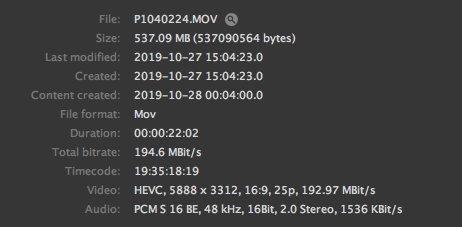
The positive aspect of recording 6K, 5.9K and 5.4K in 4:2:0 10-bit (LongGOP) H.265/HEVC is that the file sizes are very manageable. For example, the bitrate of a 5.9K 25p clip is under 200 Mbit/s. That’s roughly the same amount of data as an HD 25p ProRes 422HQ clip.
The limitations of 6K
Don’t get me wrong, it’s nice to have the ability to record internally in 6K, but it does come with a lot of caveats.
The biggest caveat is that you can only record in 23.98/24p. There’s no 25p available. If you need to deliver in Pal frame rates you are out of luck.
Another caveat is that you can’t use an external recorder or even a monitor when shooting in 6K. While you can see an image on a monitor, once you hit record on the camera, the image disappears. By the way, this is also the case if you choose to shoot in the 5.9K or 5.4K modes.
In the 6K mode you are also limited to recording at 200Mbps (4:2:0 10-bit LongGOP) in H.265/HEVC. I don’t really see this as too much of an issue though, as the quality of the 4:2:0 10-bit LongGOP is still pretty good.
Variable Frame Rates
The VFR (Variable Frame Rate) lets users record over-cranked / under-cranked video in C4K/4K (60fps, maximum 2.5x slow motion in 24p) and FHD (180fps, maximum 7.5x slow motion in 24p). The minimum frame rate for quick motion video is 2fps.
In C4K and 4K you can only record in frame rates above 30p if you are in the S35 or Pixel/Pixel modes. This can also only be recorded in 4:2:0 8-bit LongGOP.
You can shoot in HD at up to 150fps in full frame, S35mm or Pixel/Pixel modes. Anything above 152fps is limited to S35mm.
You can’t use auto focus when variable frame rate is activated. No audio can be recorded while in HFR modes.
The S1H is capable of Full HD up to 180 fps recording at 100Mbps (4:2:0 8-bit LongGOP) H.264/MPEG-4 AV.
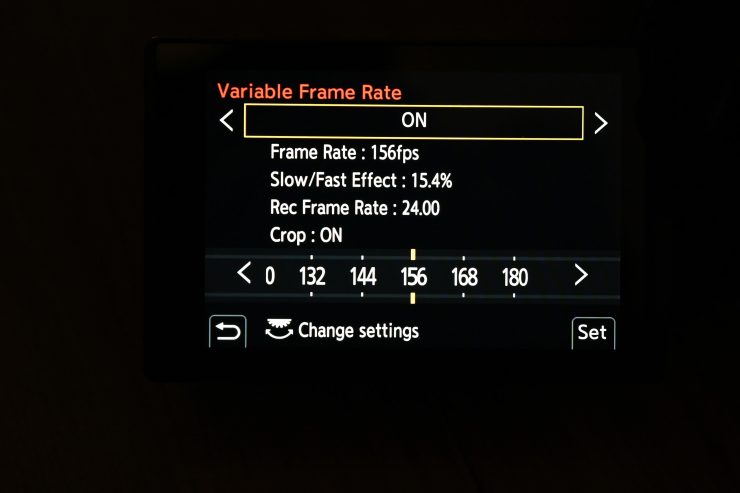
What you need to factor in is that angle of view narrows if you select a frame rate that is over 151fps.
HFR material is certainly very usable at lower ISOs, although it isn’t as sharp as when you are shooting in other modes and it does show a lot more noise. In fact, Panasonic’s own manual for the S1H states: When set to a frame rate exceeding 60 fps, there may be some deterioration in recording quality.
At 60fps the material looks good and there is no real noticeable increase in noise or decrease in image quality. It’s when you go above 60fps where you will notice more noise and a decrease in sharpness.
Above you can see some shots done at 180fps. Anything above 2500 ISO is pretty horrible. The vision is also not very sharp. At 4000 ISO in V-Log the footage is horrible.
The HFR is a lot better at lower ISOs. Above you can see 144fps at 640 ISO.
I wouldn’t use HFR recording in low light situations where you have to increase the ISO. If you try and use the S1H’s (High) 4000 ISO dual native setting in V-Log with HFR the shots do not look good. If you go over 150fps then the noise levels get even worse.
If you want to shoot in hyper sharp ‘Ang Lee’ style HD 119.98p you can. Above you can see what 119.98p looks like on a 23.98p timeline. The nice thing is that audio is also recorded at 119.98p.
Image Area of Video
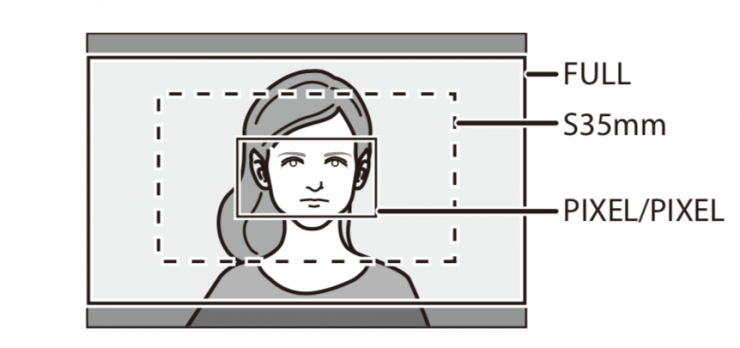
As the S1H utilizes a full-frame sensor you can choose what image area you would like to capture. The angle of view differs depending on the image area. By choosing a different image area you can effectively extend your lenses focal reach without image deterioration.
You can only choose Image Area when recording in various resolutions and frame rates. In all of the 4K and C4K modes you can choose S35 and Pixel/Pixel. Obviously in 6K and 5.9K you are limited to the full frame area.
Where this option is impressive is when you are recording in C4K/UHD/HD. Here you can select from using Full Frame, S35mm or Pixel/Pixel. This is very handy as you can use one full frame zoom lens such as the 24-105mm F4 to shoot just about anything you need. If you are shooting events, news, or even weddings, and you need to deliver in UHD or HD, an S1H and 24-105mm F4 full frame zoom makes for a compelling solution.
The other benefit of pixel to pixel when shooting in HD is that you can get incredibly good macro shots with a standard lens.
I couldn’t see any large difference in image quality when using Full, S35mm, or Pixel/Pixel. The only thing I could see is that the Pixel/Pixel is probably not quite as sharp as the Full Frame or S35mm modes.
Of course, you also can’t choose to shoot using the full view of the sensor if you are using a Super 35 mm/APS-C lens or if you have the Image Circle selected to S35mm.
Anamorphic shooting
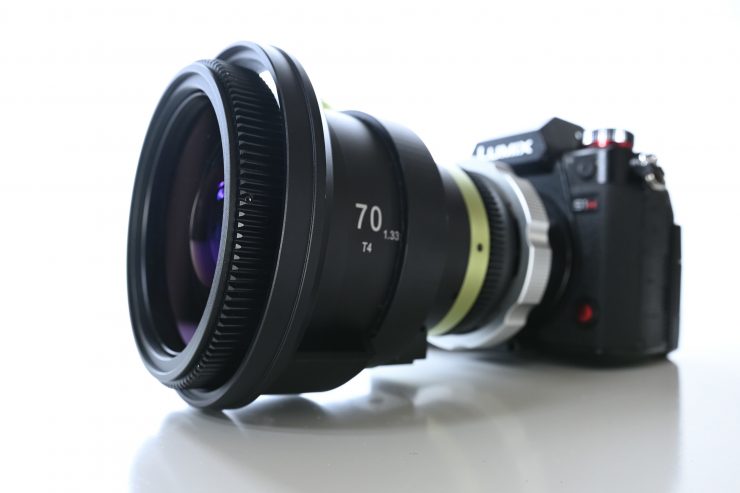
The S1H has a 4K 3328 x 2496 (4:3) anamorphic shooting mode. It can also record video with an aspect ratio of 3:2 that has 6K resolution or 5.4K resolution. You can select a recording quality that suits anamorphic recording from a variety of different video formats (recording qualities). In addition to the 2x and 1.33x anamorphic modes that were previously installed in the GH5 / GH5S, the S1H also supports 1.8x 1.5x, and 1.3x.
Images output via HDMI are not de-squeezed.
Making sense of it all
The camera certainly does offer a lot of frame rate and resolution options, but it does get slightly confusing working out what is available.
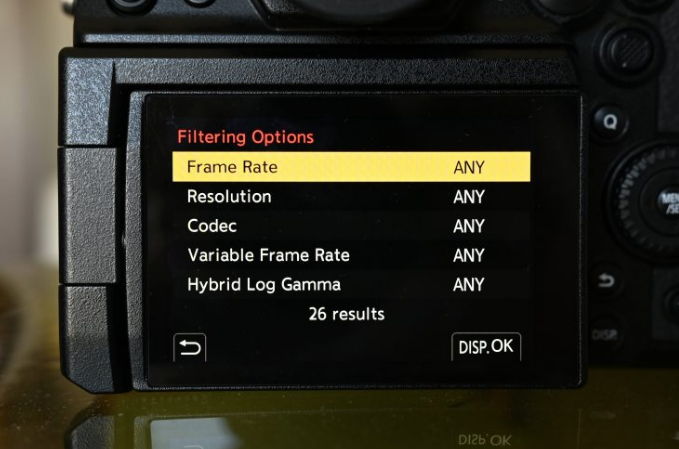
To try and make this a bit easier, Panasonic has come up with a menu function that helps tell you what codec and frame rates are available at certain resolutions. It does this by a process of elimination.
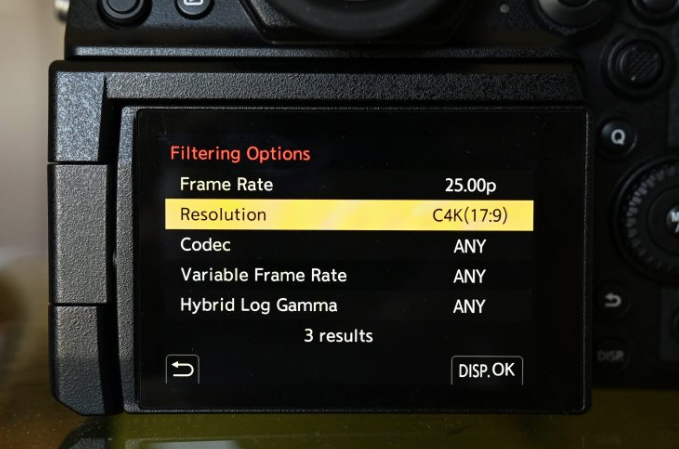
The more options you filter, the smaller the number of results becomes until you are left with only the options that are possible.
I like this filtering system as it allows you to quickly work out what options are available to you based on your requirements.
Menus
As this is a video-centric camera I would have preferred to have seen Panasonic make a way where you could disable or not show all the stills menus when you are shooting video. This way it would make for a lot cleaner and more straight forward way of making changes.
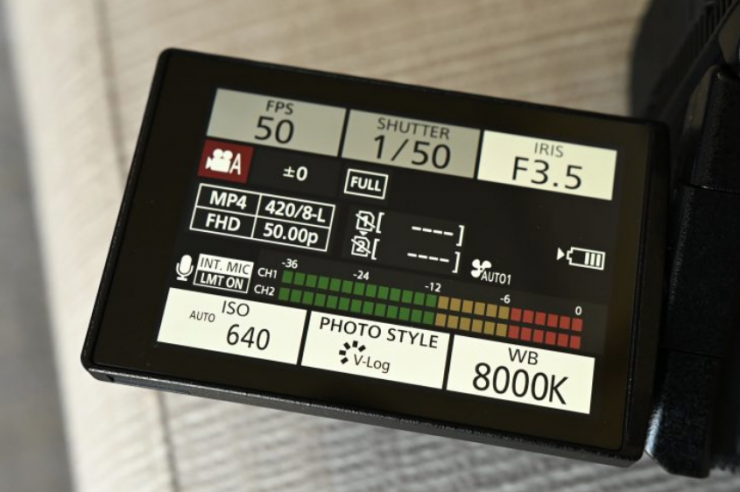
The S1H does have a nice display you can bring up which looks fairly similar to what you would find on an EVA1 or Varicam LT.
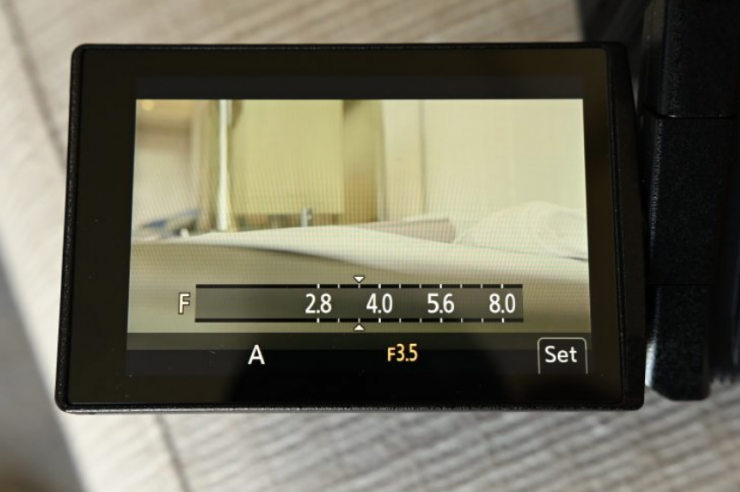
You can make changes to these items by touching the screen, but that then takes you to another screen. It would have been nice to see a way where you could toggle around on this screen and make changes to your key shooting parameters such as ISO, shutter speed, fps, and white balance.
Sensor
The S1H is using a 24.2-megapixel 35mm full-frame CMOS sensor (35.6 mm x 23.8mm) that’s capable of capturing 6K resolution video and still images measuring 6,024 x 4,016 pixels. The camera has an OLPF (Optical Low Pass Filter) to suppress moiré while the S1 does not. Signal processing is done by the Venus Engine.
There has been much debate about increased resolutions and whether we actually need them. The S1H uses a 6K sensor as opposed to a native 4K sensor. Due to loss of resolution to Bayer pattern math, at least 5.7K is needed to deliver proper 4K RGB. It’s the same reason ARRI uses 2.8K to deliver 2K. The S1H, in theory, should out-resolve any 4K native camera, as it can clearly delineate 2000 line pairs while most others max out at about 1600.
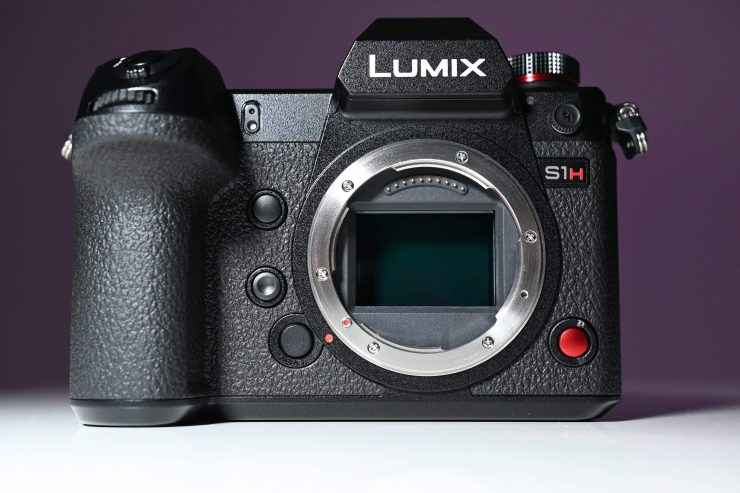
Panasonic told me that this is not the same sensor that is used in the S1.
The sensor also utilizes a non-dust system. This prevents dust from adhering to the sensor which is nice when you are changing lenses. How it works is that a supersonic wave filter (SSWF) creates around 80,000 times / second of ultrasonic vibration between the image sensor and the shutter each time the power is turned on.
Venus Engine
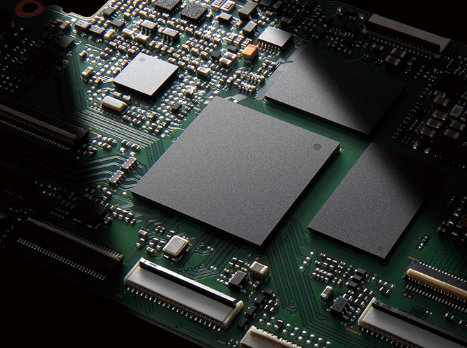
According to Panasonic, the Venus engine used in the S1H offers a lot of advancement in terms of resolution and reproducibility for full-size image sensors. They go on to say that Venus offers multi-pixel brightness and intelligent detail processing and good moire suppression performance. The new 3D color control improves the reproducibility of dark and bright areas, enabling smoother and richer gradation expression.
In addition, the high-precision multi-process NR installed in the engine improves the separation performance of the detail and flat parts of the subject. By separating the signal and noise components more accurately and effectively suppressing noise according to the characteristics of the image, it is possible to achieve a stunning and realistic depiction even with high sensitivity.
Boot-up time
If you are a documentary, news or event shooter the time it takes for a camera to boot-up is a big deal. There is nothing worse than missing a shot because you are waiting for your camera to fire up. The S1H is quick to fire up and get recording. I timed it as being around 2-3 seconds from the time you turn it on till you get an image and can press record.
What about the heat?
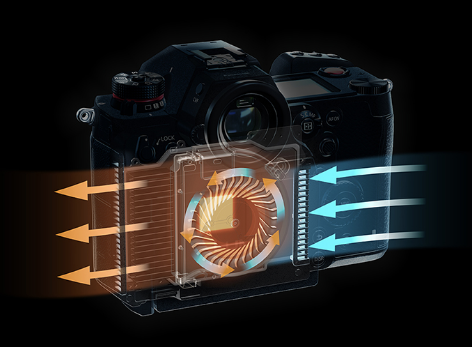
Full frame mirrorless cameras recording 4K video generate a lot of heat. Unlike digital cinema cameras that have large cooling systems and vents to dissipate the heat, mirrorless cameras are weather sealed. This means that there is nowhere for the heat to escape. A lot of full-frame mirrorless cameras suffer from overheating problems when they are recording video.
To achieve stable, continuous and extended video recording heat dispersion Panasonic designed a near-silent cooling fan with an innovative structure that is claimed to efficiently draw heat away from the sensor.
The reason that the body of the S1H is larger than the S1 and S1R is directly due to these heat issues. Having a larger body and a fan helps dissipate heat.
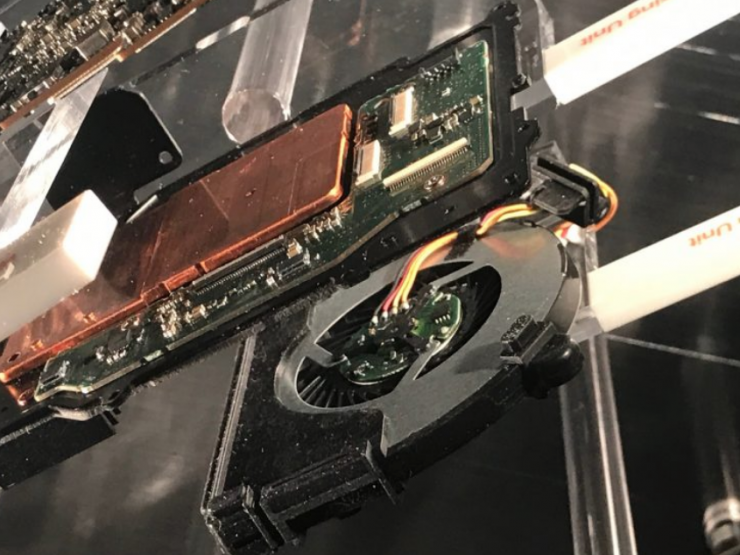
The fan has been designed so that it creates minimal vibration and noise and it can be operated in four different modes.
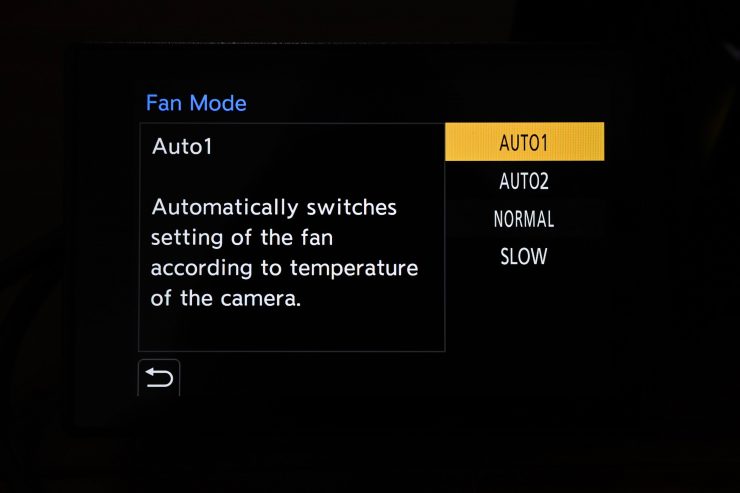
If you have the fan in the Normal mode you can hear it, but it’s not loud enough to be a problem.
I don’t find the addition of a fan to be of any real concern. It is relatively quiet and I don’t think it is going to affect any sound recording.
The S1H certainly doesn’t get as hot to touch as other mirrorless cameras I have used in the past. There is still some heat being generated and you can feel it at the bottom of the camera, but it never gets that hot.
Dual Native ISO
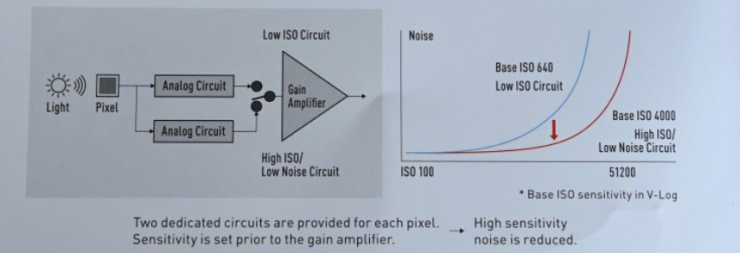
Unlike the S1, the S1H has a dual native ISO. The S1H’s Dual Native ISOs are 640 and 4000 when shooting in V-Log. Normally noise increases as sensitivity rises with a single native ISO image sensor. However, the new image sensor with Dual Native ISO in the S1H is claimed to minimize noise generation by choosing the optimum circuit to use before gain processing, according to the ISO sensitivity that is set.
This Dual Native ISO feature can be switched manually between LOW and HIGH or left in AUTO mode for the camera to make the decision for you.
Now, the Dual Native ISOs do change depending on what profile you are shooting in:
- Normal picture profiles: 100 and 640 ISO
- V-Log: 640 and 4000 ISO
- HLG: 400 and 2500 ISO
- Cinelike D2/V2: 200 and 500 ISO
V-Log/V-Gamut
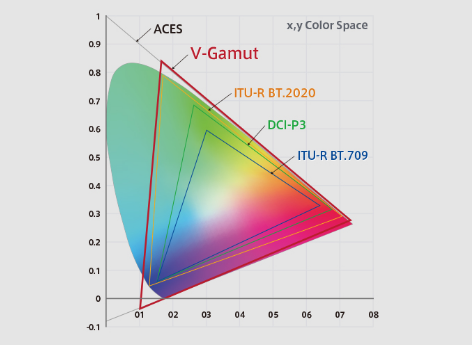
Unlike with the S1 and S1R, the S1H has V-Log/V-Gamut included as standard. With the video-centric S1, if you want to record internal 60p 4:2:2 10 bit and V-Log you need an update key similar to the GH5.
According to Panasonic, the S1H’s recorded footage is compatible with V-Log footage recorded by VariCam or V-Log L footage recorded by other LUMIX cameras such as the GH5/GH5S and S1.
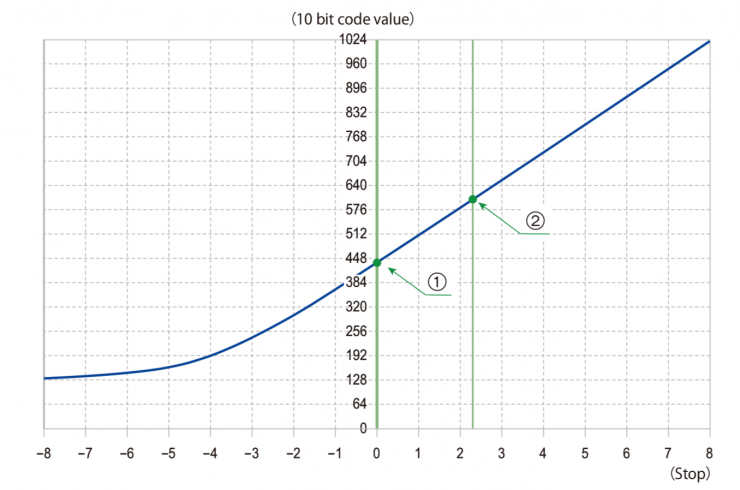
The [V-Log] curve characteristics comply with “V-Log/V-Gamut REFERENCE MANUAL Rev.1.0”. When set to [V-Log], the standard exposure when grey with a reflectance ratio of 18% is imaged is IRE 42%.

It’s nice to see that Panasonic has included V-Log/V-Gamut in S1H and not made it a paid option.
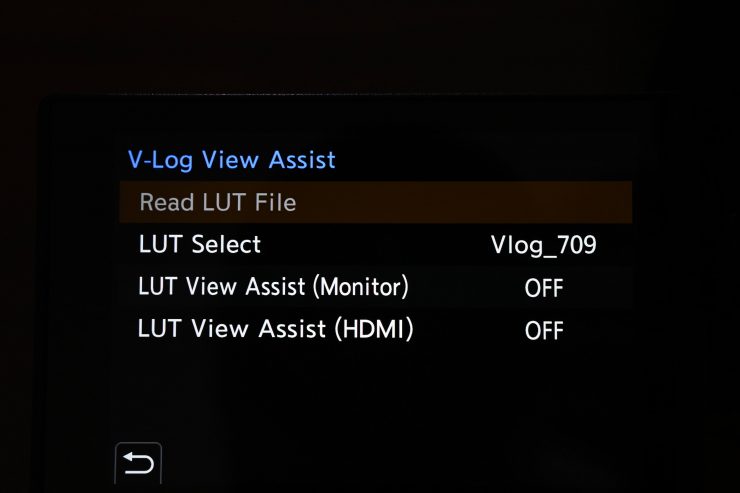
V-Log View Assist is also available on the S1H. V-Log View Assist means you can show images with a LUT applied on the monitor/viewfinder and also output them via HDMI.

Above you can see the options that are available when using V-Log View Assist.
Maybe it’s just me, but I find V-Log material a little difficult to grade. What I have always found is that I sometimes find V-Log difficult to work with when you are grading images that were shot in mixed lighting scenarios. This is probably because I haven’t shot a lot of V-Log material. I’m sure a much more proficient colorist could obtain a lot better results.
I’m also not a big fan of the V-Log to 709 LUT. It just doesn’t look good and makes everything way too magenta for my liking. Skin tones don’t look good if you are shooting in V-Log and then monitoring or just using the LUT.
I personally don’t like V-Log, but maybe some of our readers have some good suggestions for grading V-Log. If you do let me know.
Picture Profile Comparison
Above you can see a quick test showing the differences between Standard, Cine D, Cine V, V-Log, and HLG picture profiles. I have purposely placed the subject in a challenging lighting environment that is heavily backlit. I have done this so you can see how skin colors look and how the different picture profiles perform under these conditions. You can see the differences in dynamic range and highlight handling between all of these profiles.
Just to be clear, this is what you get out of the box, you could easily grade all of these images to obtain a more pleasing result.
I haven’t altered or touched any of the images in any way. The same ISO, white balance, T-stop and lens were used for this test.
HLG

HLG (Hybrid Log Gamma) is an international standard (ITU-R BT.2100) HDR format. On the S1H you can record directly in HLG. HLG has more dynamic range than some of the other picture profiles (although not as much as V-Log). HLG is a good compromise between using a standard picture profile and V-Log.
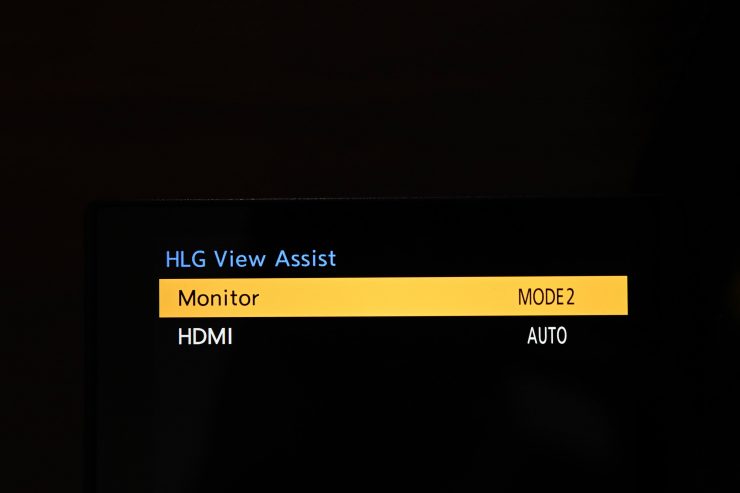
The monitor and viewfinder on the S1H do not support the display of HLG format images. If you are shooting in HLG then you need to use the HLG View Assist which allows the S1H to display a converted image.
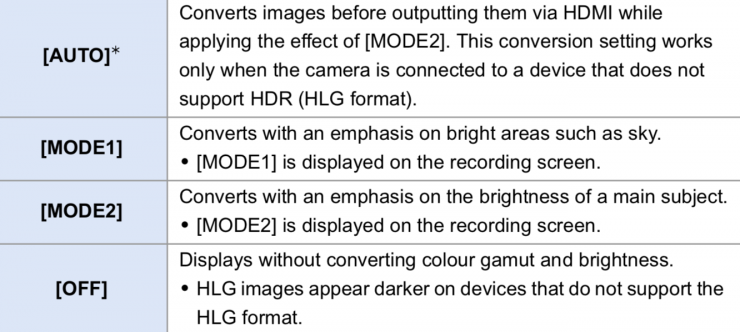
The HLG View Assist has several modes you can choose to use.
What you also need to be aware of is that HLG images will look dark on devices that do not support the HLG format.
I actually like shooting in the HLG profile. I think in a lot of instances it produces good results.
[Cine-like D2] & [Cine-like V2]
Along with V-Log and HLG, there is also the [Cine-like] gamma settings that offer warm skin tones and better shadow detail. Panasonic recommends using these if you need to turn material around quickly.
[Cine-like D2] prioritizes dynamic range and [Cine-like V2] emphasizes the contrast. According to Panasonic, by using these gamma settings it is possible to easily reproduce the look that reflects the VARICAM series without color grading.
LUTs
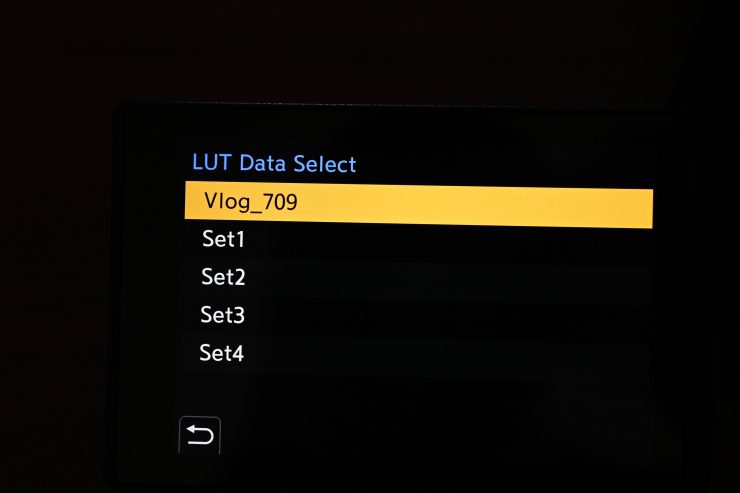
As you would expect from a video-centric camera, the S1H has the ability to use LUTs. You can only load up to 4 LUT data files on the camera. These LUTs also have to be in the “.vlt” format, which meets the requirements specified in the VARICAM 3DLUT REFERENCE MANUAL Rev.1.0.
VARICAM LUT library
The S1H is compatible with the VARICAM LUT library that is available in three different formats. When loading up one of thes4 LUTs into S1H, use the .VLT format.
White Balance
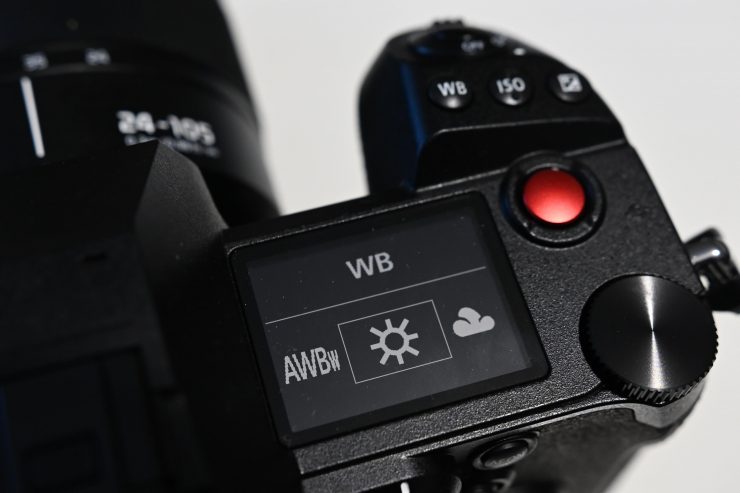
On a lot of mirrorless cameras (I’m especially pointing the finger at Sony here), doing a white balance is far more complicated than it should be.
With the S1H it is quick to do a custom white balance. The camera also has a dedicated white balance button that is easy to access. This allows you to make white balance changes very quickly.
You can store up to 4 custom white balance settings, and there are an additional 4-kelvin color temperature settings you also store.
You can also choose AWB as well as 7 other preset defined white balance settings.
Design & Build Quality
I personally like the design of the S1H. The camera feels nice to grip in the hand and everything is located in easy to reach positions.
I like that there are two record buttons on the camera body. The record button on the front of the camera is nice to use when it is difficult to reach the buttons on the top of the camera when you are using a cage or running the S1H on a gimbal.
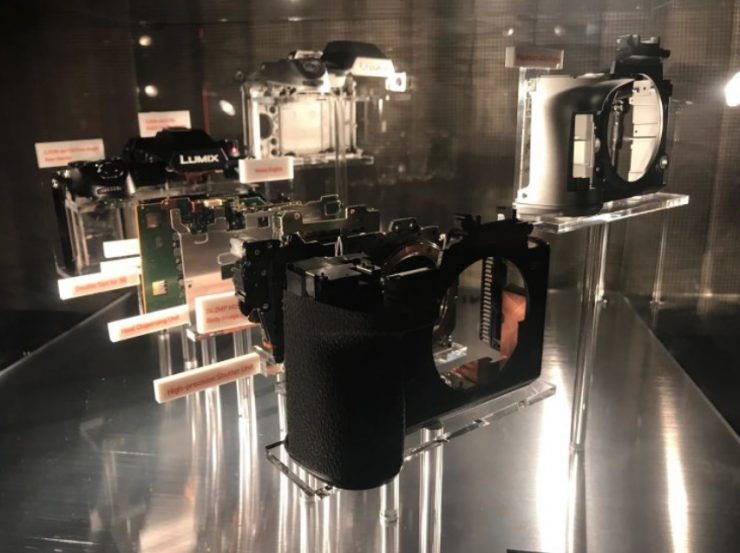
To be tough enough to withstand heavy field use, the main structure of the S1H is composed of magnesium alloy with full die-cast top/front/rear frame.
There is a seal for every joint, dial, and button that makes the S1H splash resistant, dust resistant, as well as freeze-resistant down to -10 degrees Centigrade. The body material is a shock-resistant.
The S1H is solidly made and it feels nice in the hands. The buttons and dials are all nice and tactile, and the door for the battery compartment opens and closes with no problems.
The media door is not my favorite design. It sort of has the double locking mechanism which makes it hard to open when you are in a hurry.
Weight & Size
The S1H is a sister camera to the S1 and the S1R. It shares a similar form factor and looks. It is, however, slightly taller and wider.
The S1H is big as far as mirrorless cameras are concerned. The camera tips the scales at 1.16 kg (2.56 lbs) with a battery and memory card.
To put this weight into perspective here is what the competition weighs:
| Panasonic S1H | 1.16 kg (2.56 lbs) Body with Battery and Memory) |
| Panasonic S1 | 1.02 kg (2.25 lbs) Body with Battery and Memory) |
| Sony a7III | 650 g (1.43 lbs) Body only |
| Nikon Z6 | 585 g (1.29 lbs) Body Only |
| Canon EOS R | 660 g (1.45 lbs) Body with Battery and Memory |
It has physical dimensions of 151 x 114.2 x 110.4 mm (5.94 x 4.5 x 4.35″). This larger size does provide some advantages though. Panasonic is able to squeeze in two card slots, larger batteries and plenty of cooling.
Tilt & Rotatable Screen
The camera has a 3.2″ fold out monitor that has been designed with flexibility in mind.
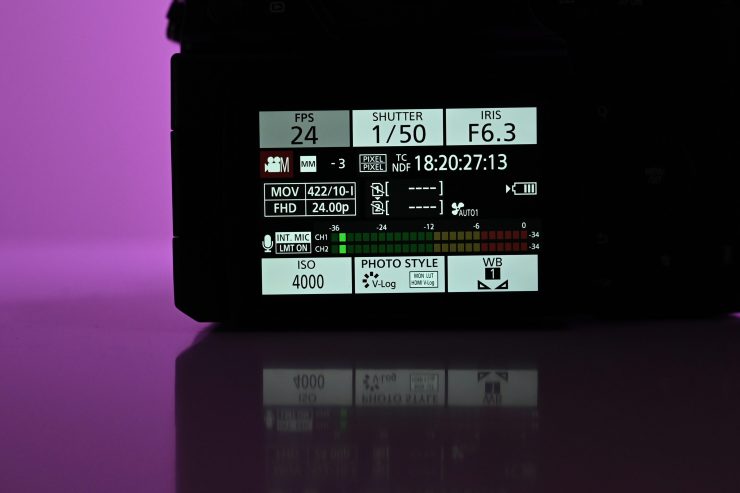
The 3.2-inch, 2,330K-dot 3:2 aspect rear touch-screen monitor features approximately 150% higher luminance compared with the S1R/S1, GH5 and GH5S for improved visibility when the camera is used outdoors in bright conditions. Adopting a new mechanical structure, the rear display features both tilt and rotation movement so that users can easily change angles without unplugging or clashing with HDMI and USB cables.
Live View Boost is another practical feature that makes it possible to check composition even in total darkness by boosting screen brightness just for live view. The S1H also incorporates a Night Mode that provides more moderate backlighting so the user’s eyes don’t have to adjust to comfortably see a subject right after viewing the monitor in dark situations.
The 3.2″ fold out monitor is easy enough to use and it offers enough flexibility that I think most users will be happy with its design. The touch screen functionality is responsive and the quality of the screen is really good. I would have to say that it is the best LCD display I have ever seen on a mirrorless camera. While you can see it very clearly in most conditions you will struggle if you are trying to use it outdoors in the sun.
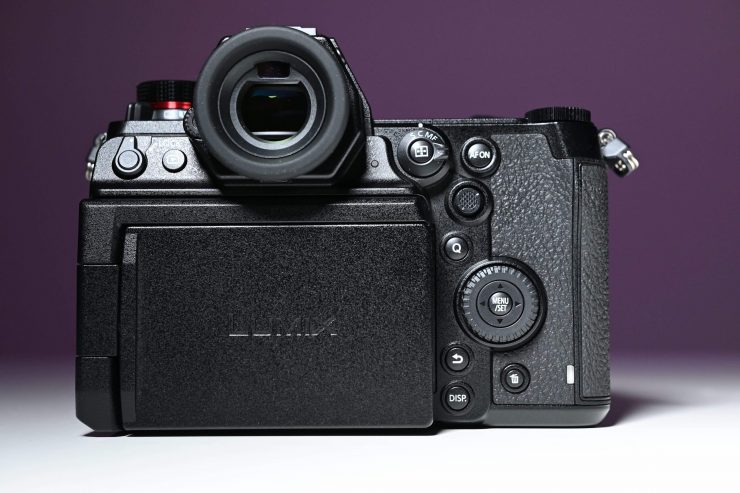
I like that the fold-out monitor can be flipped around and completely hidden away. It means that when you are putting the camera in a bag or transporting it the rear screen won’t get accidentally scratched.
Real View Finder
The camera has the same Real View Finder as the S1 and S1R, which boasts the World’s highest resolution of 5,760k dots. The 0.78x magnification ratio can be switched to 0.7x or 0.74x according to the shooting situation, and the use of a high-speed, high-precision OLED for the LVF provides a smooth display that refreshes at 60fps/120fps (switchable). The EVF has a high-speed response, with a lag of approximately 0.005 sec, as well as 10,000:1 high contrast.
I like that you can press the LVF button on the side of the EVF to turn the rear LCD screen off, or turn the EVF off. I wish Panasonic had have implemented a way to be able to keep both on at the same time and to turn off the EVF proximity sensor.
The rear viewfinder is very, very good and I think it is best I have seen and used on any mirrorless camera. I’m not sure if I like the round eyecup, but others may not have a problem with it.
The problem for me is that even though you have this great viewfinder and rear LCD screen, you can’t punch in to check focus when you are recording. This almost defeats the purpose of having good onboard monitoring.
Status LCD information panel
The new Status LCD information panel on the top plate is the largest-in-class, measuring 1.8-inch. Adopting MIP (Memory In Pixel technology), it is said to consume very little power. It assures high visibility both in bright outdoor and in dark situations thanks to a reflective LCD that can be backlit. Major settings for photo shooting or video recording are displayed. The response of the LCD is also fast enough for time code counting and audio monitoring.
I quite like this Status LCD information panel. Even though I don’t tend to look at it that often, it’s nice to have that key information available to you if you need it. Speaking of the Status LCD information panel, it would be nice if Panasonic could somehow allow you to display items like a waveform for those times when you still want to see it but not have it overlayed across your image.
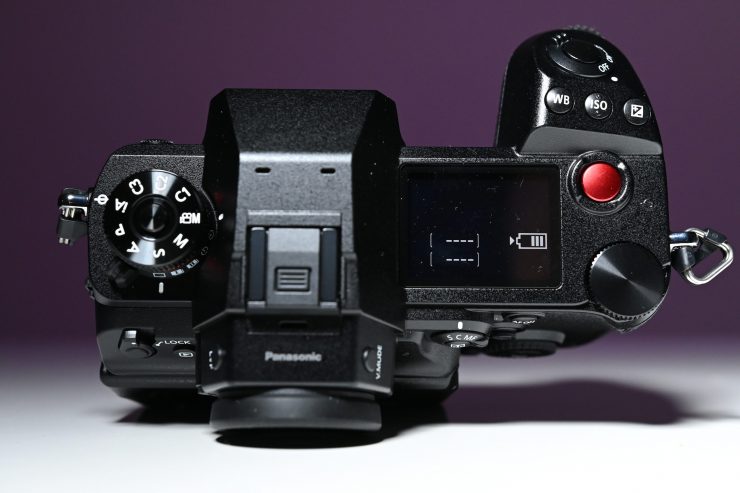
It’s also nice that it displays the battery life and card capacity even when the camera is turned off. It can do this because the screen dwaws very little power.
Multiple Function Buttons
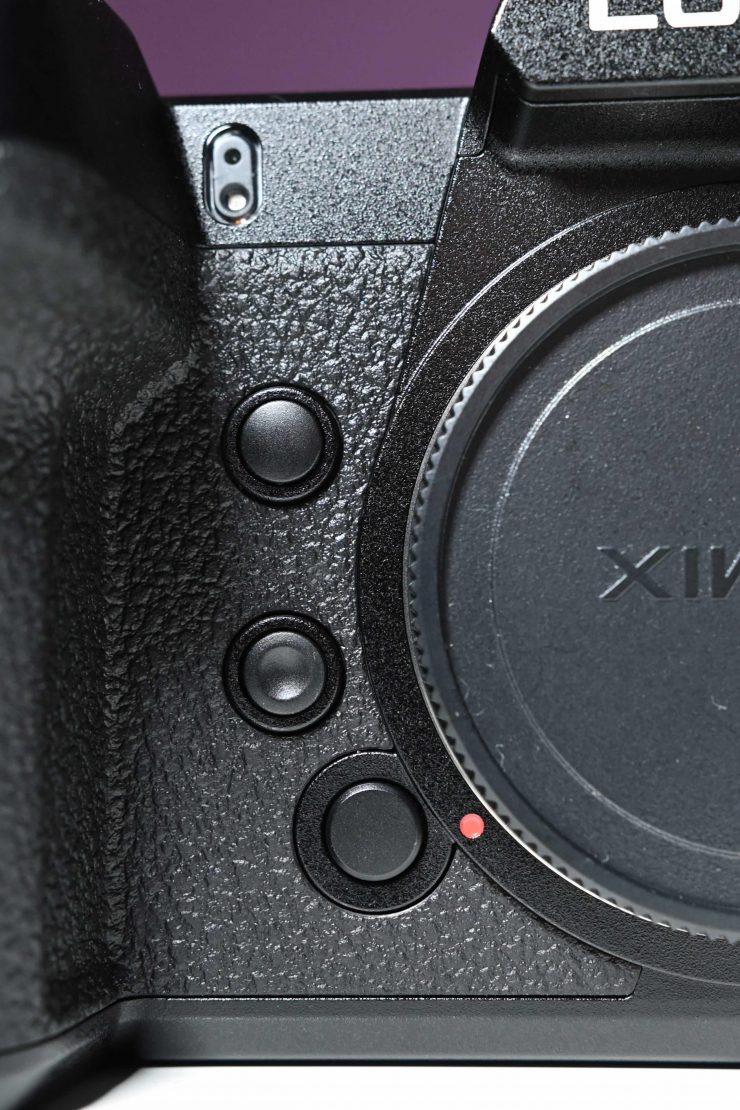
The LUMIX S1H has multiple Fn (function) buttons on the front panel of its body that allow quick access to the designated functions. An additional video button is positioned on the lower part of the left of the camera front so the user can also activate recording with the left hand when the right hand is occupied, when holding a cage or gimbal for example. Most of the buttons can be customized to assign the camera’s functions to suit the photographer’s operating style and needs.
Tally lights
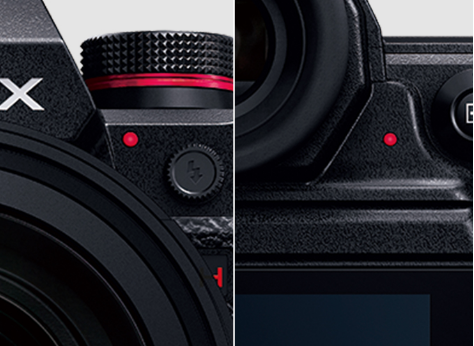
This is something you don’t see on mirrorless cameras. Tally lights are mounted on the front (subject side) and rear (photographer side) of the camera body. The tally lights can be turned ON / OFF independently for the front and rear.
The tally lights are not overly bright, but you won’t want to have them turned on if you are shooting near glass or reflective objects as you will end up seeing a red dot when you are filming.
Monitoring Tools & Other Functions
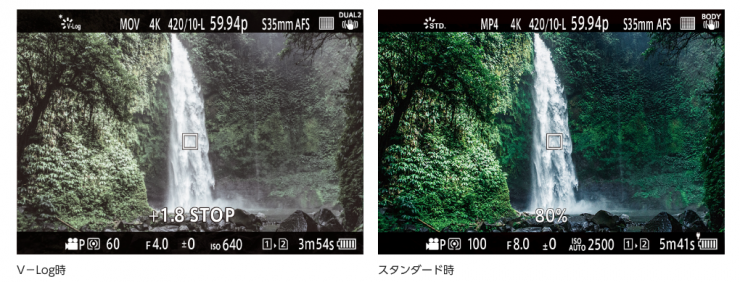
One of the monitoring tools I like on the S1H is the ability to measure the brightness of a very small area of your scene. You can move the measurement frame around and measure the brightness at any position after you decide on the composition. During normal shooting, the range of -7 to 109% (IRE) is measured and displayed in as a %. Exposure compensation, ISO, and gain settings are reflected in the measured values in real time.
When V-Log is set, the % is converted into a stop unit and displayed. By measuring to an 18% standard reflector and adjusting to [0 STOP], it’s fairly easy to obtain accurate exposure.
Image Zoom
As you would expect, the S1H is equipped with an image zoom function that can be used when MF and AF + MF MF are half-pressed when using the AFS setting. You can check at a glance which part of the subject is in focus.
The maximum magnification has been increased from 10x to 20x.
Now, the massive caveat here is that you can’t do this while you are recording. I’ll explain more about this in the Usability section of the review.
I’m not the biggest fan of the image zoom function. I hated it on the GH5 and I hate it on the S1H. I wish there was a way where it would automatically just zoom in on the whole screen instead of having this small box in the middle of your image and then to go full screen you need to activate another box. EDIT: I’ve since discovered that if you activate the focus punch in and then press thefull screen box once it will stay on there until you diable it.
Peaking
There are 10 different types of peaking available. Peaking can be assigned to a function button. I don’t personally like the peaking on the S1H. It’s not as intuitive or well displayed as I have seen on other cameras. Maybe I just need to fiddle around with the settings more.
Zebras
The S1H can support the simultaneous display of [Zebra 1] and [Zebra 2] with different thresholds applied. This is handy as you could set one for skin tones and one for highlight clipping.
Waveform/Vectorscope
The S1H has both a waveform and a vectorscope. These are both useful to have. You can also change the display size of the waveform monitor.
What you do need to be wary of is that if you have the waveform or vectorscope monitor up and you hit record, you can’t turn it off unless you stop recording.
Center Marker
There is a center marker you can bring up which is handy for composition and if you need to make sure that a subject is completely centered in the frame.
Electronic Horizon
The S1H also has an electronic horizon you can display if you need to check if your camera is level.
Synchro scan
Synchro scan can be used reduce flicker that occurs when shooting under fluorescent lights, TV screens, and PC monitor screens. By performing synchro scan, it is possible to select the appropriate shutter speed according to the environment, and it also supports subtle low-frequency fluctuations that could not be processed with the conventional flicker reduction function.
Color bar display
You can output and display color bars. There is also a 1kHz voice reference signal that you can generate or output.
Mount

The S1H uses the L Mount. The L Mount is fairly adaptable and there is a range of adaptors you can use to run non-native L Mount lenses if need be.
One of the key drawcards of the L Mount is its short flange focal distance. With an inner diameter 51.6 mm and a flange depth of 20.0 mm it allows enough room to place a lens adapter ring between just about any lens and the L Mount.
Below are the flange depths of some other camera systems:
- Nikon Z Mount 16mm
- Fujifilm X-Mount 17.7mm
- Sony E-Mount 18mm
- Canon RF-Mount 20mm
- Leica M-Mount 27.8mm
- Contax G-Mount 29mm
- Canon EF-Mount 44mm
- Nikon F-Mount 46.5mm
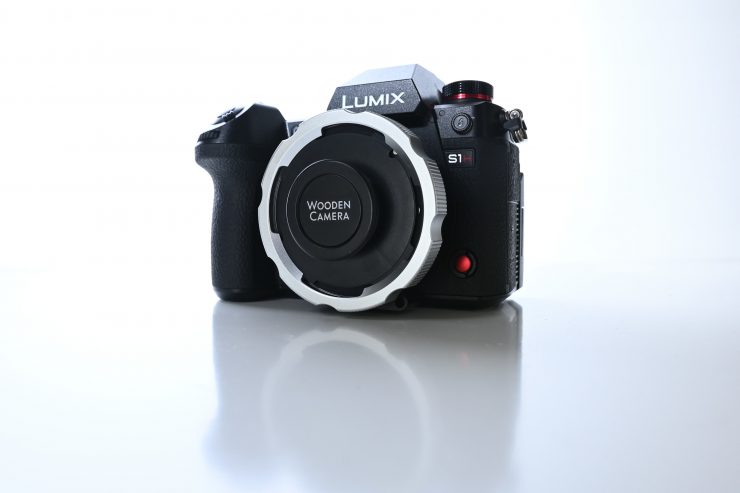
Wooden Camera makes a PL to L Mount conversion kit if you want to run cinema glass on your S1H. There are also other PL to L Mount Adapter options from a wide range of companies, including Fotodiox, c7 Adapters, Leitz, Kippon, and Sigma.
I will have a full review of the Wooden Camera L-Mount to PL Mount Pro on the site soon. I used that adapter during the S1H review.
Ins & Outs
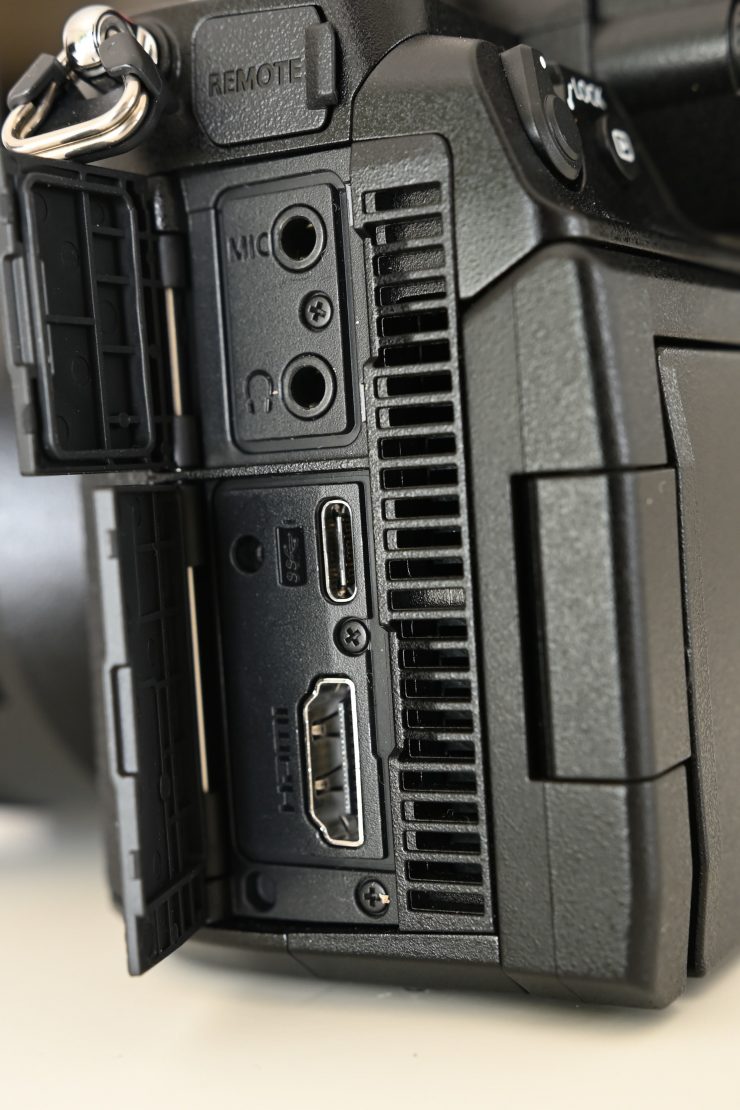
The camera has a USB Type-C port that allows for fast file transfers Additionally, there is an HDMI Type A port, a 2.5mm port can be used with the optional DMW-RS2 Remote Shutter, and a 3.5mm microphone and headphone jack.
The S1H offers 4:2:2 10-bit 4K 60p/50p HDMI output via a Type A terminal that allows the included cable-lock holder to be used to prevent accidental unplugging and interruptions to the recording.
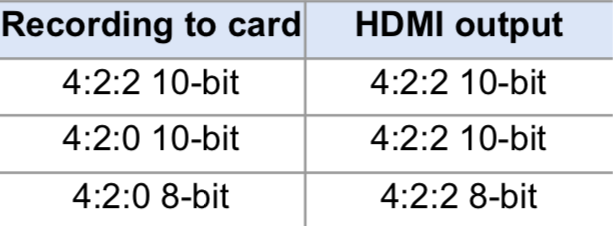
Unlike the GH5 and GH5S, you can internally record 10bit Cinema4K / 60p, or 4K / 60p video, while simultaneously outputting Cinema4K / 60p, 4K / 60p 4: 2: 2 10bit video from the HDMI terminal.
What you need to know when outputting over HDMI:
- 6K, 5.9K, and 5.4K videos are output with a 4K or FHD resolution. Output is not possible during recording.
- Anamorphic (4:3) video is output with a 4K or FHD resolution.
- When set to a recording quality for high frame rate video, the frame rate is down-converted for output.
- When set to a 4:3 or 3:2 [Rec Quality], bands are added to the images and they are output with a 16:9 aspect ratio.
- Output may be in 8-bit if you output to devices that do not support 10-bi
Settings for Down-Converting:
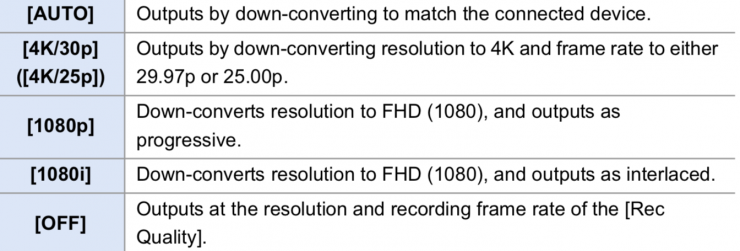
You can output the camera information display to an external device connected by HDMI if you don’t need to record externally and just want to use that device as a monitor.
The S1H does not have the ability to output and record to an external SSD via the USB Type-C port.
Time Code
It is also compatible with Time Code IN/OUT synchronization through the flash synchro terminal and comes bundled with a BNC converter cable and a BNC cable. This makes it easy to synchronize the non-linear editing of footage shot with multiple cameras. The feature was also included in the GH5, however, the timecode drifted very quickly.
The timecode is super easy to set up and use on the S1H. The nice thing is, once you have jammed the timecode from another device you can pull out the BNC cable and it will continue to stay in sync.
Having a good timecode system on a mirrorless camera is a big deal, especially if you are using it with other cameras.
I tried the Time Code IN/OUT synchronization with a Tentacle Sync and it worked well. I didn’t find there was any noticeable drifting of the time code, but then again, I didn’t test it over the period of a whole day.
Recording Media
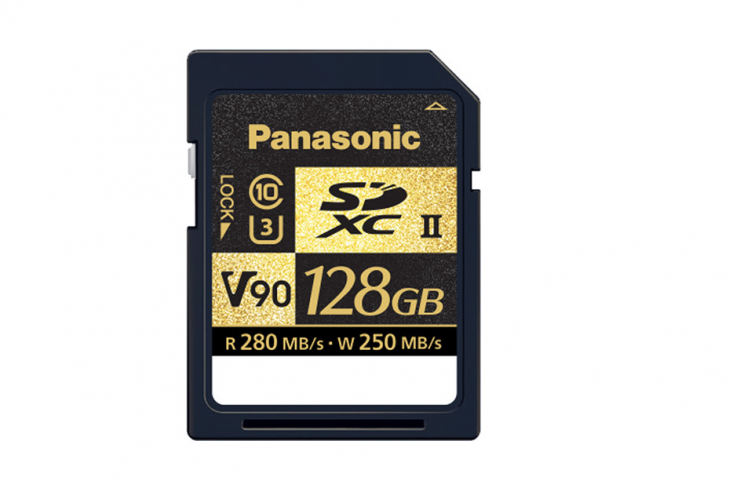
The S1H features dual SD memory card slots that are compatible with the high-speed, high-capacity UHS-II and Video Speed Class 90 cards. As a comparison, the S1 has one XQD and one SD.
Both slots support UHS-II video speed class 90 SDHC / SDXC memory cards and support high bit rate recording such as ALL-Intra (up to 400Mpbs).
Users have the flexibility to choose the recording method from Relay Recording, Backup Recording or Allocation Recording which enables the saving of video and photo data on separate cards. The SD Cards are hot-swappable so you can continuously record for hours on end or at least until the battery dies. (Sequential (relay) recording is not possible with AVCHD.)
When shooting stills If you open the card door or battery door while writing to the card, a warning tone will sound to prevent you from accidentally removing the card. You don’t get this warning sound when recording video.
If you are a little paranoid you can choose to do video split recording. The reason this is an option is that if you want to avoid the loss of video due to an unexpected power supply interruption, you can set the video split recording to ON to record a MOV video. In this mode the recorded video will be divided into a separate clip every minute. This is not something I would personally use, but it is there if you need it.
It is interesting to see that Panasonic decided to stick with SD cards as the recording medium, instead of choosing CFast 2.0 or CF Express.
Live Cropping
On the S1H you can utilize a function called Live Cropping. What this essentially does is let you capture a zoomed-in view of your image.
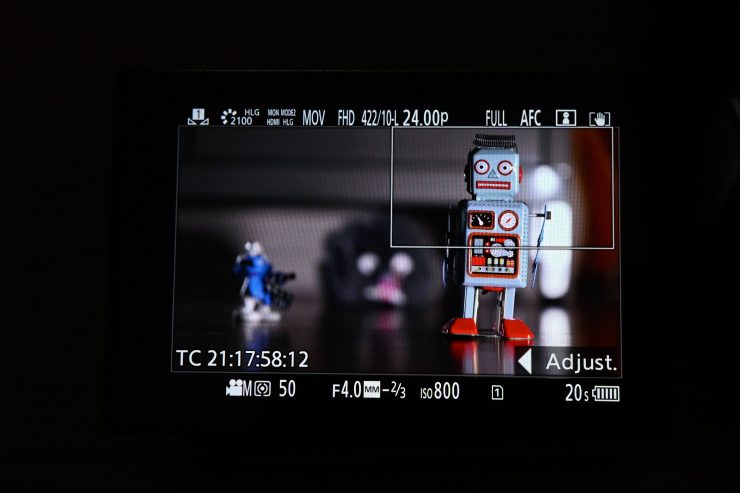
By cropping a part of the image from what is displayed in the live view, you can record FHD video that incorporates panning and zooming as long as the camera stays in a fixed position. You can also just record a frame that doesn’t move.
You need to select a compatible recording mode and format to be able to record Live Cropping. If you have selected a recording format or recording quality where Live Cropping isn’t available, the camera will automatically switch to a recording format that is.
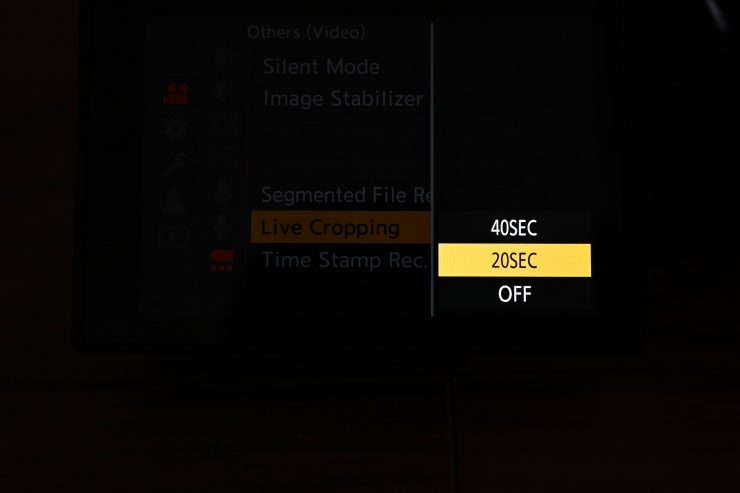
There is a little catch when using Live Cropping. You can only set the S1H to record for either 20 or 40 seconds. It’s a little strange that you can’t just set it to stay on whatever frame you have selected for as long as you want, but I’m sure Panasonic did this on purpose so that users wouldn’t forget that Live Cropping was activated.
So does it work well? In short yes. The zooms you can do are really smooth. The pans aren’t quite as good and they have a slightly digital feel to them. The only problem I have with Live Cropping is there is no way of setting a start or a pause at the end. Once you set your points and hit record, the zoom or pan instantly starts and then when it finishes it instantly stops. As you can also only select recording durations of 20 or 40 seconds, the usefulness of this function becomes somewhat limiting.
It’s also a little limiting that you can only get an HD recording. It would have been nice to be able to record in 4K when using the 6K mode. Yes, this wouldn’t allow for that much of a pan or zoom, but it would still be nice to have.
You really need to use a tripod when doing Live Cropping. While you can do it handheld, the results aren’t nearly as good. I did, however, find that if you are holding the camera very still you can still use the Live Cropping effect.
Live Cropping is a nice feature to have. While it’s great that you can do the cropping, panning, and zooming in camera, there probably isn’t any real benefit over doing it in post, unless you are handing footage off to a client or turning material around quickly.
Just to be crystal clear, anytime you are using Live Cropping, the recording will be done in HD. The HD recordings can be done at up to 60p 4.2.0 8 bit. You can also record at up 30p in 4.2.2 10-bit.
Timelapse
With the interval shooting function you can automatically set up time-lapse recording on the S1H. The shooting interval can be set from 1 second to 99 minutes 59 seconds in increments of 1 second.
Once you finish recording a timelapse you can then turn it into a movie file without leaving the S1H. The S1H supports 4K / 60p interval video generation. What is nice is that the exposure is smoothed when the video is being generated so you can create time-lapse videos with smooth exposure changes.
Loop Recording
The S1H has a Loop Recording mode that can be selected. Loop Recording lets the user continually record for as long as the camera is powered. Even when recording uses up the card’s free space, the camera continues the recording by deleting the oldest segment of the recorded data.
Essentially it will just keep over writing data once your card fills up for as long as you have this mode selected. This could be useful in certain shooting scenarios.
Loop Video Recording is not available in the following modes:
- [Rec Quality] with a bit rate of 400 Mbps
- [Variable Frame Rate]
- [Live Cropping]
Focus Transition
Focus Transition, as the name suggests, lets you smoothly transition the focus position from the current position to a position registered in advance.
You need to use an interchangeable lens that supports the AFC focus mode for it to work on the S1H. The moving speed of focus varies depending on the lens being used.
Focus Transition will not work when you are in the HFR mode or Live Cropping mode.
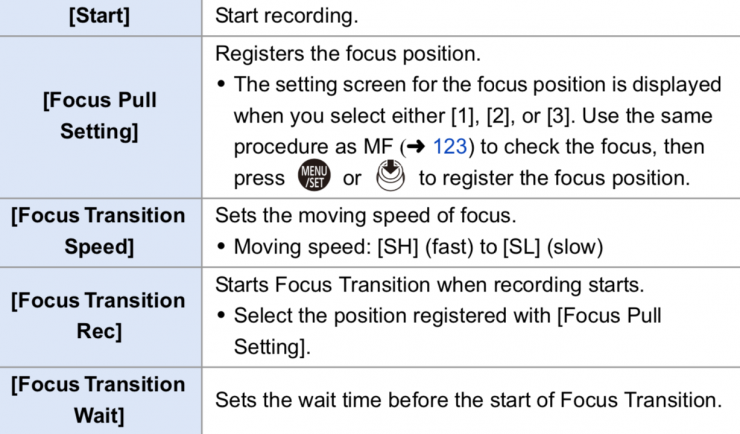
Above are the parameters you can change when using Focus Transition.
So is it useable? Yes, it actually works really well. I tried it with the Panasonic Lumix S 24-105mm F4 lens and I was able to do pretty smooth focus transitions.
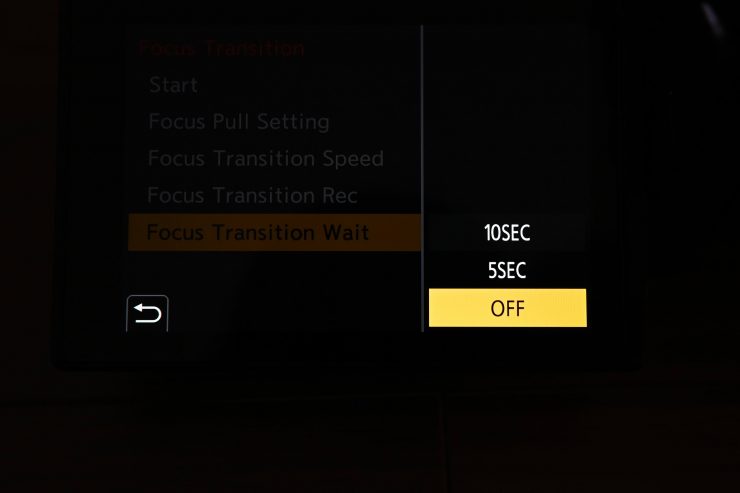
I like how you can set the Focus Transition Wait to either 5 or 10 seconds. This lets you have a nice clean start to the focus transition.
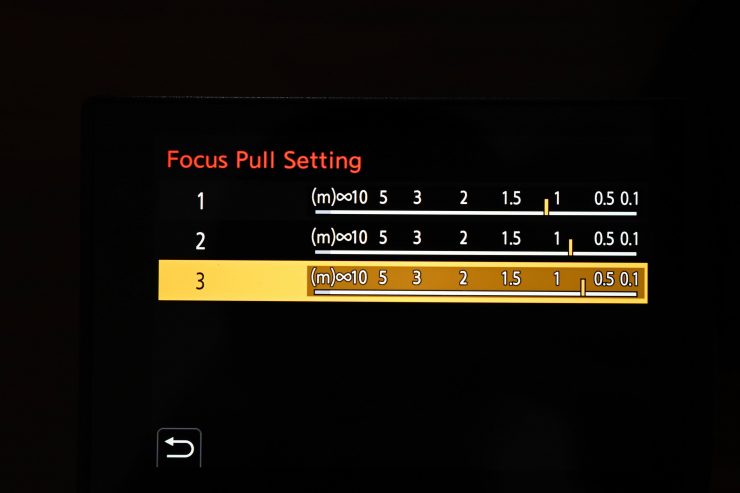
You can also set up to three focus transition points and then go between them or go from say point 1 straight to point three if you want to. You can also go from the last focus transition back to the first.
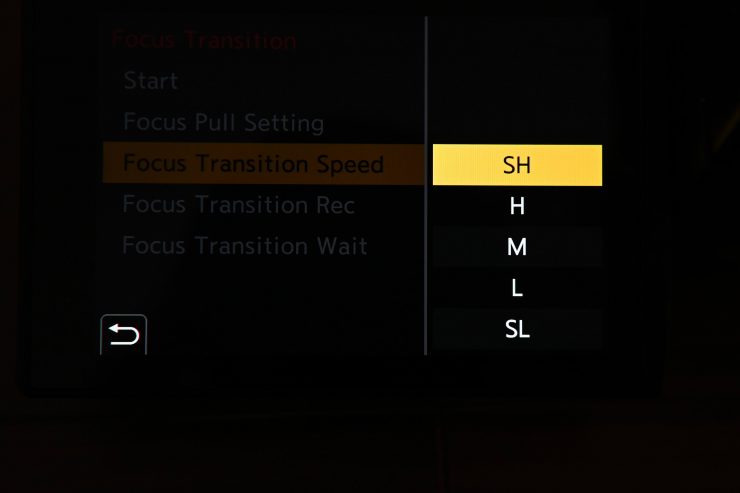
It’s also nice that you can change the speed of the transitions. There are settings all the way from super high to super low. The super high and super low settings are pretty extreme. The SH speed is good if you are shooting events and need to transition as quickly as possible between to focal points.
Setting up the Focus Transition is relatively quick to do and it certainly allows you to set up and repeat perfect focus pulls between two objects as long as they aren’t moving.
No RAW (yet)
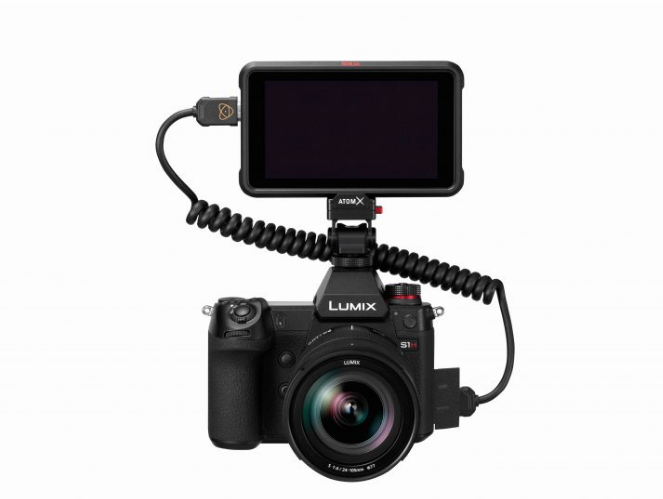
We have started to see quite a few cameras emerge that are capable of recording RAW. While there is no internal RAW recording in the S1H, Pansonic did confirm to Newsshooter that they are working with Atomos to deliver ProRes RAW via HDMI to an Atomos recorder at the launch event in Hollywood.
Since that time, a press release has emerged that states that Panasonic is working with Atomos to enable 5.9K up to 29.97p as well as C4K up to 59.94p RAW video data over HDMI. With this upcoming firmware program, Apple ProRes RAW can be recorded on an Atomos Ninja V. There is no time frame as to when this will happen.
Battery & Battery Performance
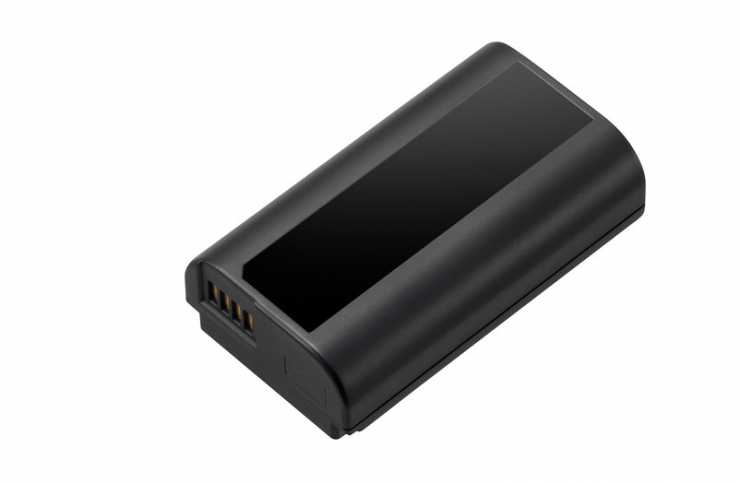
The S1H uses the same batteries as the S1 and S1R, the DMW-BLJ31. It has a 3,050mah capacity.
For extended shooting, you could add the DMW-BGS1 battery grip which can hold another battery and connects via electronic contacts rather than a dummy battery like other battery grips. The grip retails for $349.99 USD.
The 7.4-V 3,050mAh high-capacity battery can achieve continuous recording times of approximately 2 hours in all recording modes. The battery can be quickly charged via USB PD (USB Power Delivery) using the bundled USB3.1 Type-C cable. The battery charger also complies with USB PD and enables quick power charging in approximately two hours. The camera can be used while charging via this adaptor.
Battery life is exceptionally good. You wouldn’t need more than 2 -4 batteries to get you through a whole day of shooting.
O.I.S & I.B.I.S
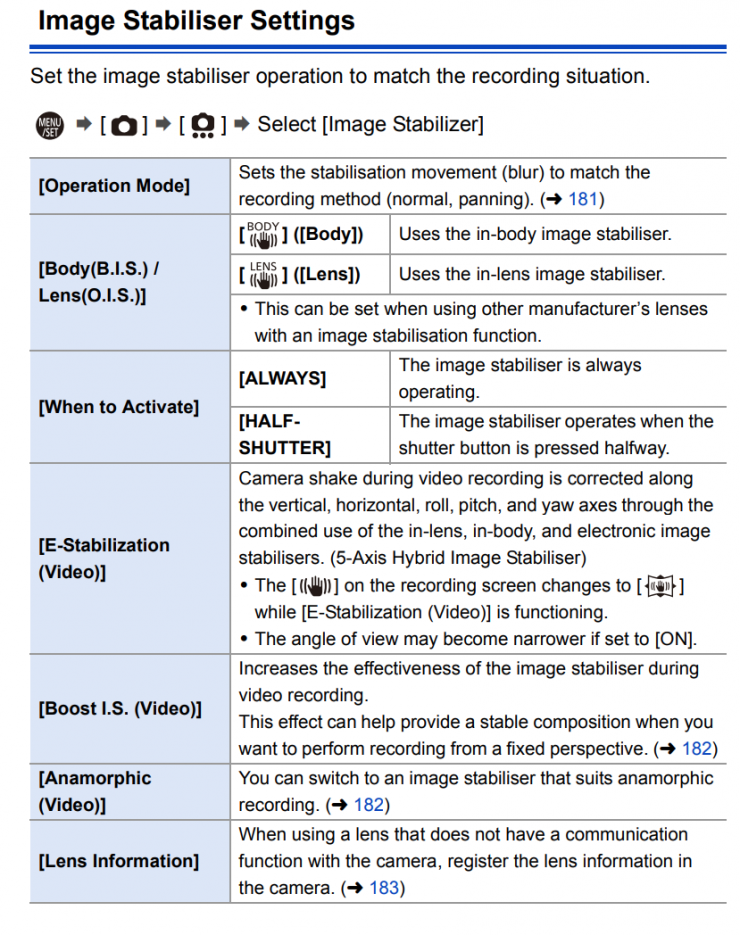
The S1H integrates in body image stabilization (I.B.I.S). Panasonic has developed an algorithm that is claimed to precisely calculates shake using information acquired not only from a gyro-sensor but also from the image sensor and an accelerometer sensor within the body of the camera. This is said to enable more accurate shake detection and compensation
By combining the Body I.S. (5-axis) in the camera and the O.I.S. (Optical Image Stabiliser, 2-axis) in the LUMIX S Series lens, the 5-axis Dual I.S. compensates for larger movements than are controllable by conventional methods. Maximizing both O.I.S. and I.B.I.S. is claimed to give users up to 6.5-stops of compensation.
The 5-axis Dual I.S. 2 works for both photo and video modes, including 4K, 6K, and anamorphic recording. The Body I.S. compensates for camera movement even when L-Mount lenses without O.I.S. are used and when other lenses are fitted via an adapter
The I.S works really well, it certainly allows you to capture very steady footage when shooting handheld. If you combine a Panasonic lens such as the 24-105mm that has O.I.S with the S1H’s in-body image stabilization you can obtain remarkably steady shots when shooting handheld.
With this combination, handheld shots that I did looked like they had been shot using a tripod.
There is also an additional E-Stabilization mode you can activate where camera shake is corrected along with vertical, horizontal, roll, pitch, and yaw axes through the combined uses of in-lens, in-body, and electronic image stabilization.
Above you can see a quick test showing the different stabilization mode combinations. You can also see how they work with and without OIS on. This was shot at 105mm hand held in full frame.
The biggest downside to using IBIS and OIS is that if you try and do pans or tilts you get this bad floating effect that makes it hard to do anything smoothly. If you are shooting anything where you are getting lens flare you will also see the flare moving around in an unnatural way.
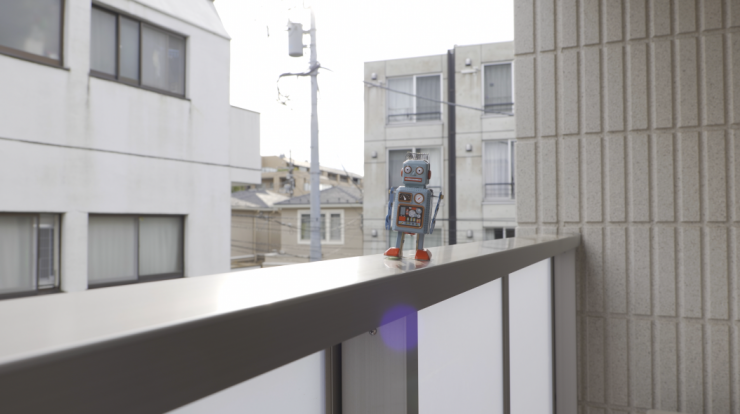
E-Stabilizatio, Boost I.S & OIS 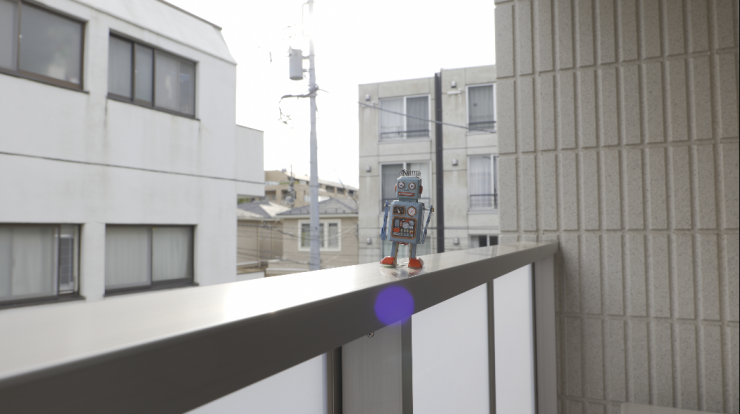
E-Stabailization and Boost I.S off 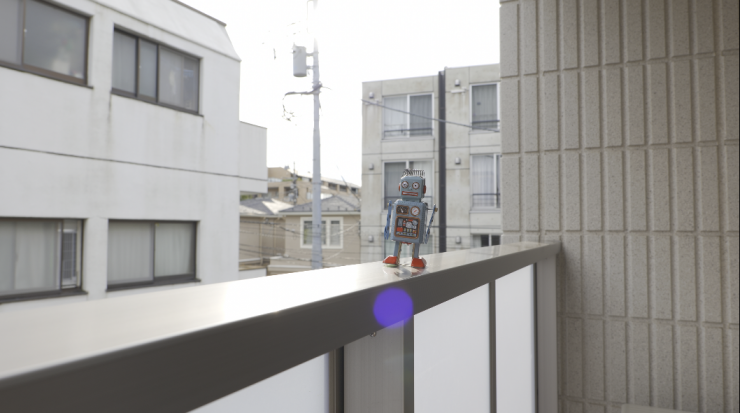
Boost I.S & OIS on
There is a slight image crop when you turn on the E-Stabilization (video) mode, but it is fairly minimal. If you just have the Boost I.S (video) activated there is no crop.
Rolling Shutter
Any CMOS sensor mirrorless camera is going to have some rolling shutter. Just how much you think is acceptable is a question I can’t answer. I personally don’t go whipping my camera around quickly where I ever find rolling shutter to be a problem. In saying that, there are cameras out there that have horrible rolling shutter which can certainly make some shots (especially handheld) unusable.
The rolling shutter is more pronounced when shooting in full frame, especially in 6K. If you don’t want a lot of rolling shutter, it does improve a bit going to the S35 crop mode. While the rolling shutter isn’t great, it’s significantly better than that of the BMPCC 6K.
Auto Focus
Every camera has an Achillies Heel, and the S1H’s is auto focus. The S1H uses a Contrast AF system. You can select AFS (Single), AFC (Continuous), or MF (Manual Focus).
When using continuous auto focus you can change which mode you want the camera to use.
You can use Continous Auto Focus when shooting video. I personally didn’t find the autofocus when shooting video to be that great when I was using the pre-production S1H with a pre-production 24-70mm F2.8 lens.
The auto focus was pretty horrendous on the pre-production version of the camera, but I was pleasantly surprised to find it had become a lot more usable on the production version. It’s still far from perfect, but at least it’s now usable, to a certain extent.
The production version of the S1H with the 24-105mm F4 lens did perform a lot better. It’s certainly usable in well-lit conditions, but it does struggle in high contrast or low light scenes. In high contrast or low light the autofocus just won’t lock onto anything and you have to switch to manual focus.
Above you can see some example shots using continuous autofocus. Here I am just trying to see how quickly, accurately, and smoothly it works.
Above you can also see clips where I had the camera set to continuous auto focus and moved an object back and forth on the focal plane. Now, sometimes it works and other times it doesn’t. This is quite frustrating as there doesn’t seem to be any rhyme or reason as to why sometimes it works well and other times it doesn’t. It didn’t seem to matter what settings I adjusted with the auto focus, the results were the same.
You can change the speed and sensitivity of how the continuous auto focus works. I found that I got better results when I turned both the speed and sensitivity up.
There is no face tracking available when shooting video (edit: apparently there is but I couldn’t find out how to get it to work). You can move around a focus box on the screen either using your finger or via the joystick but this is not the fastest process. You can also change the size of the focus area by making the box bigger or smaller.
In my opinion, the autofocus is not up to the same standard as Canon, Sony, or Nikon. Although, it’s not as bad as everyone seems to be making out. I found it worked well enough to be used in a lot of situations, but it can be unreliable. You can’t just rely on it working all the time and that’s a problem.
Does having average autofocus really matter? Well, yes and no. If you are going to be using this camera with a PL adapter for more serious applications then you probably aren’t going to care, but if you are using native S mount lenses, then yes, you are going to want good autofocus performance.
If you are after a full frame mirrorless camera that has great autofocus, then the S1H probably isn’t the camera for you. It’s not that the autofocus is terrible by any means, but it could be better.
The autofocus does not work when shooting in high frame rates.
Audio
Good onboard audio recording is something that is rarely seen in mirrorless cameras. This is a pity because I would argue that manufacturers should be paying more attention to audio, especially with more video-centric models.
A good proportion of people buying an S1H are probably going to be doing there own audio and won’t have the benefit of using a sound recordist. So how is the audio on the S1H?
I didn’t have access to the optional DMW-XLR1 audio module, but I did test the S1H by plugging in a microphone directly, as well as using a JuicedLink RM333.
When using the S1H, the recording level range can be set from -18dB to + 12dB. In addition, the recording gain of the built-in microphone and any external microphone you use can be switched in two steps ([Standard] 0dB / [Low] -12dB) so that it can be used in a wider range of environments.
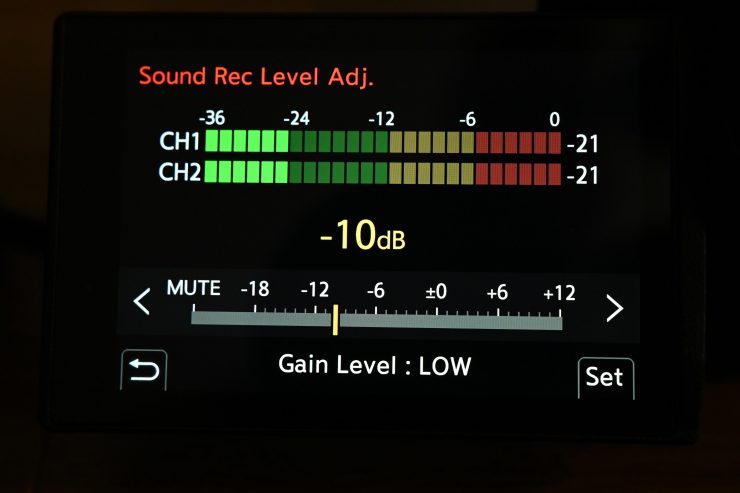
This ability to set the recording level very low means you can eliminate any internal pre-amp noise when you connect up an external audio device like a JuicedLink. When I hooked up the JuicedLink RM333, I set the S1H to [Low] and then set the recording level to -10db. This way I could take advantage of the good preamps on the JuicedLink and send in an audio signal that could be recorded at a nice level.
The audio I was able to capture was clean with no noise floor.
I also tested the S1H with a variety of RØDE microphones including the Wireless GO. Again, I was able to obtain good results.
The S1H also has a new voice signal processing algorithm that suppresses distortion and ensures better quality * when recording audio in noisy environments. Compared to the S1, the dynamic range that helps suppress distortion has been approximately doubled.
*When using the recording level limiter. Valid only for built-in microphone and external microphone (stereo).
In the camera’s audio menu you can also select the type of input you want to choose.
The S1H has a recording level meter that is displayed on the shooting screen. In addition, the S1H uses meters with the same display characteristics as cinema cameras. The meters displays -36dB to -12dB in 2dB increments and -12dB to 0dB in 1dB increments.

Compared with conventional meters (in 3dB increments), the audio monitors on the S1H make it possible to check a greater range. In addition, the display of peak level values is also displayed separately for each channel.
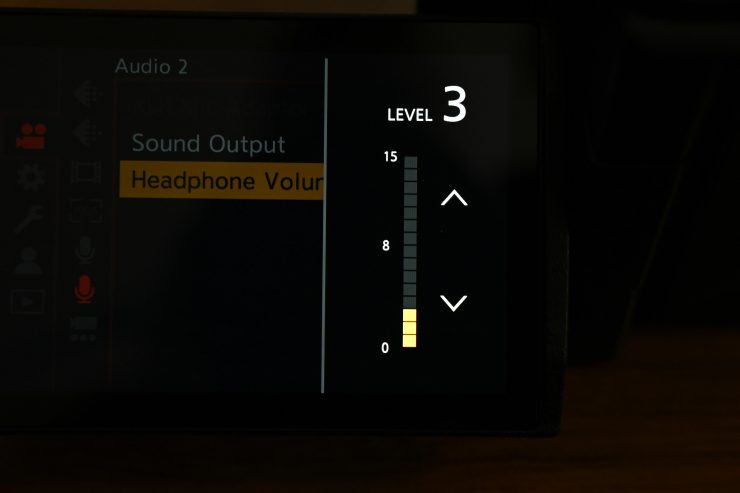
Now, as far as audio monitoring goes, the S1H has the same problem you will find on a lot of cameras. There is no way to monitor just channel 1 or just channel 2. If you are running two microphones, you hear one microphone through the left earphone and the other through the right. This really frustrates me. Why is it so hard to make a system where you can choose to monitor an individual channel and not just both at the same time.
The positive aspect of the headphone monitoring is that you can choose to listen to the audio in REALTIME, or you can choose RECSOUND, so you can monitor the outputted HDMI audio. This compensates for the slight audio delay.
DMW-XLR1
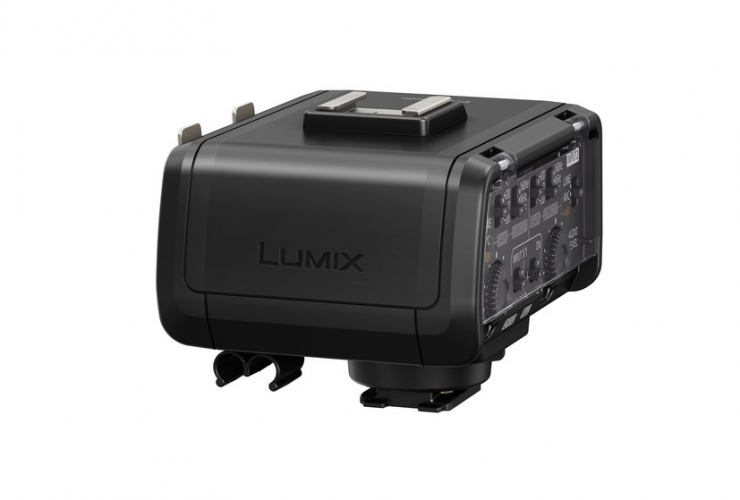
If I was buying an S1H I would also be purchasing the optional DMW-XLR1 audio module. This is the best way to keep the S1H relatively small while adding better audio recording options.
Playback
Playback on the S1H is a bit of a mixed bag. It’s nice that you can see detailed information about the clip that you shot, including what settings you were using, F stop, shutter speed, ISO, etc. and lens information.
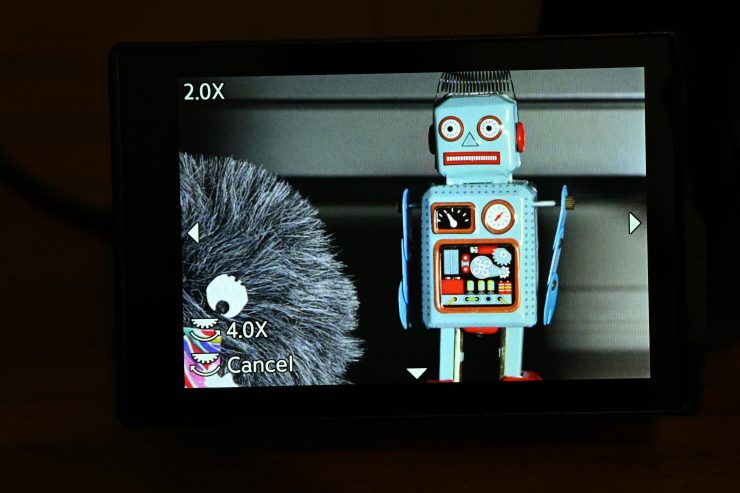
On playback, you can also zoom in 2x or 4x on the image and move that zoom around. This is good if you want to check a shot quickly to make sure it is in focus.
During playback you can also extract a frame and save it as a JPEG image. This is a handy feature to have. The picture is saved with a size according to the resolution of the recording quality.
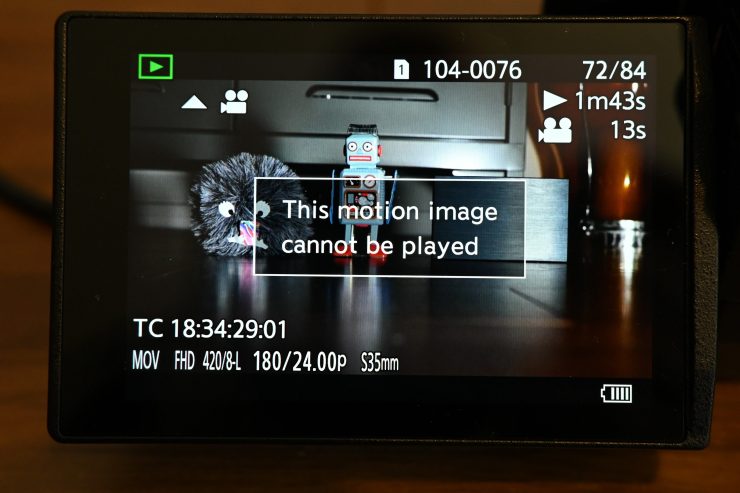
If you have mixed frequency clips on your card, you can’t playback say a 25p clip if the camera is in the 24Hz mode. This may be a small thing, but I thought it was worth mentioning.
Dealing with the footage in post
Like a lot of mirrorless cameras, the codecs being used in the S1H are not particularly edit friendly. I don’t have a current computer, but my iMac struggled to play back a lot of the files. I would personally transcode the files into ProRes for editing.
Usability
For me personally, usability is a huge factor when deciding on what camera to purchase. If the image quality is fantastic and the camera has a lot of great specifications that means nothing if it is a pain to use.
A mirrorless camera needs to be functional, easy to operate, easy to navigate, and not have overheating or battery issues.
I found that while not perfect, the usability of the S1H, for the most part, was pretty good. It certainly ticks a lot of boxes when it comes to handling, being able to hot-swap cards during recording, having unlimited recording times, and good battery performance. The LCD screen and the EVF are really good and that certainly translates into making the S1H a very usable camera.
I love that by just pressing on the ISO and WB buttons you can cycle through the settings without having to go into any menus. This is very handy when you are working in fast-paced environments.
I enjoyed using the S1H once it is set up and configured for what you want to do. The great aspect about the S1H is you can just pick up the camera and shoot. With a good EVF, good LCD screen, and good internal recording options, you don’t really need to add an external recorder or monitor and this, in turn, means you can get away without using a camera cage.
It was refreshing to be able to walk around with a camera and just shoot. The combination of IBIS and OSS allows you to get very steady footage without needing a tripod. The EVF and screen are so good that I didn’t find myself wanting to use an external monitor.
In my personal opinion, this is the first mirrorless camera I have been happy to use with no additional accessories. I can just pick up the camera and start shooting. This is one of the aspects of the S1H that shouldn’t be overlooked.
While I personally prefer the images from the BMPCC 6K, the S1H is a far superior camera as far as usability is concerned. You can’t seriously use the BMPCC 6K without adding a monitor, and as the camera has no IBIS and horrible rolling shutter, it is not a great option for handheld shooting.
For situations where you need to be more discreet or just look like a tourist taking photos, the S1H is a good option. I shot in several places where I would have been kicked out had I have been using a larger camera.
By adding the DMW-XLR1 audio module to the S1H you can create a very compact setup that can be used without adding any additional accessories. I like this, as for me personally, this is the whole reason to use a compact, mirrorless camera in the first place.
Of course, if you want to add extra gear to the S1H you can do that as well.
The menus as I mentioned earlier are not bad, but there is certainly room for improvement. They aren’t nearly as intuitive as the menus on say a BMPCC6K.
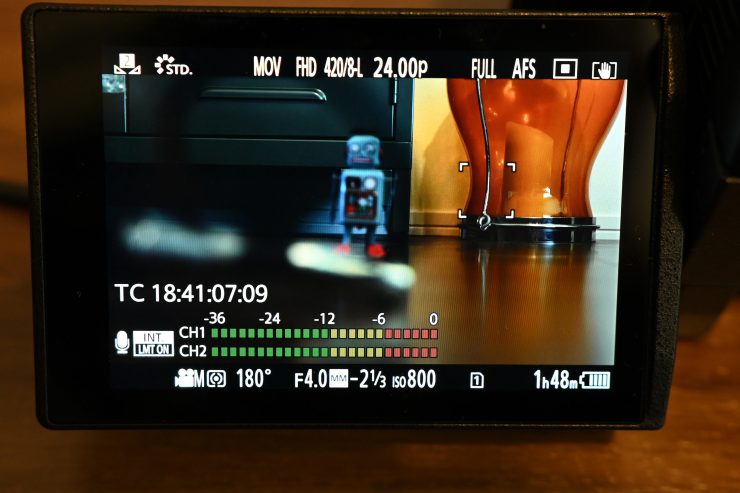
The other small complaint I have is that the screen can get very cluttered with information., especially if you have timecode and the audio meters up at the same time. I wish there was some sort of larger surround-view you could choose so all of the information wasn’t covering your frame, not just some of it.
I’m not the biggest fan of the focus punch in system. I don’t like the small box that appears windowed inside your main image so you can check focus. I would much prefer to have a full screen punch in available in one go, without having to activate yet another mode. Edit: As I mentioned earlier I found that if you activate the focus punch in and then press the full screen box it will stay like that until you disable it.
The biggest downside for me is that you can’t punch in and check focus while recording. In some ways, this is almost forcing you to use an external monitor so you can do this. According to Panasonic, it’s not possible for them to have the ability to punch in when recording. Apparently, this has to do with the design of the processing engine and the data path from the sensor to the SD card. If they added in focus punch in when recording that would ultimately end up being burnt into your footage!
Now, this is also the case over HDMI. If you have the S1H hooked up to say an Atomos recorder and you aren’t recording internally, if you press the focus punch in on the camera then the Atomos will also record that punched in view.
Panasonic is looking into changing this on future camera models.
The other annoying thing is that if you have the waveform up and you are recording you can’t then take that waveform off the screen until you stop recording. A small bug I found with the waveform is that it moves position when you hit the record button.
I like the large red record button on the top of the camera. It is easy to see and locate. The front side record button is also very useful when you have the camera in a cage or mounted on a gimbal.
What you also need to keep in mind is the S1H has all the same still photography capabilities of the S1. This strong combination of still and video performance shouldn’t be overlooked. If you are doing multimedia work then there is a strong case for choosing a camera like the S1H.
Is it too big for a gimbal?
Despite being larger and heavier than other full frame mirrorless cameras, you can certainly use the S1H on a compatible gimbal.
I didn’t have any problems balancing it on a Moza Air 2 with a Panasonic 24-105mm F4 lens.
Accessories
A variety of accessories can be used for the S1H. A Microphone Adaptor (DMW-XLR1), Remote Shutter (DMW-RS2), Eyecup (DMW-EC6), Battery Grip (DMW-BGS1), Battery Charger (DMW-BTC14) and so on. The Microphone Adaptor is a hotshoe-mounted adaptor for up to two XLR microphones to record high-quality stereo sound. Dedicated switches allow direct, quick control, and MIC, LINE and CONDENSER MICROPHONES are switchable.
Netflix Approved
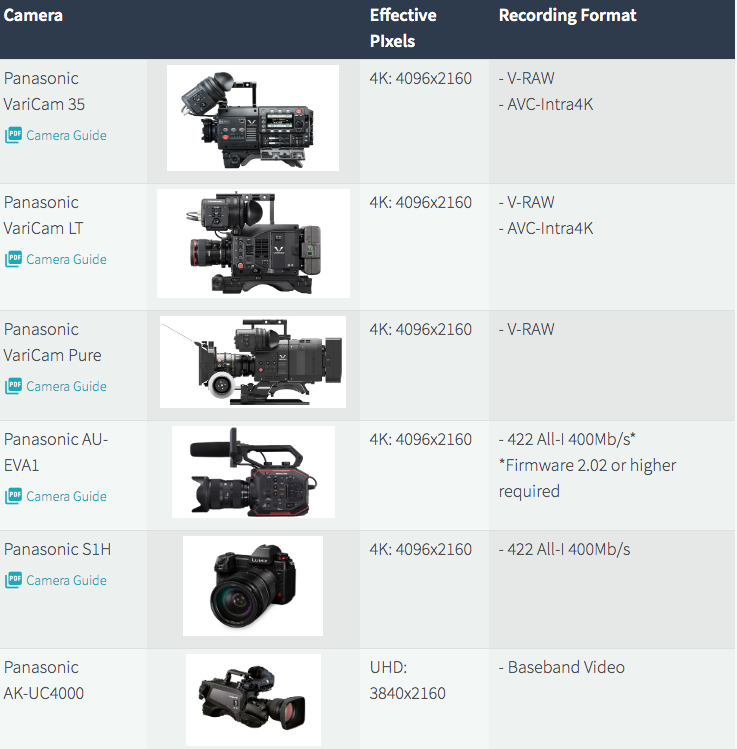
The S1H is the first-ever mirrorless or DSLR camera to obtain Netflix approval.
As you might be aware, Netflix has quite stringent regulations for what cameras and capture formats can be used on original Netflix productions.
The Netflix specifications state that a camera must have a true 4K UHD sensor (equal to or greater than 3840 photosites wide) and that 90% of the total runtime of a final program should be captured on an approved camera. The only exception to the 90% rule is for, For nonfiction content, this threshold may be more flexible.
Now, these regulations only apply to original Netflix productions. Productions that are on-sold to Netflix don’t have to meet these requirements.
While the approval for the S1H is significant, I highly doubt many Netflix original productions are going to start using an S1H as their ‘A’ camera.
Does the S1H throw a spanner in the works for Panasonic?
With the S1H being specifically marketed as a film production tool how does this affect other dedicated Panasonic Cinema cameras, especially the EVA1?
It’s very rare to see mainstream manufacturers put features in lower-priced cameras that are as good, if not better than their more expensive offerings.
Even though the S1H offers 4K DCI & UHD 4:2:2 10-bit 60p, 6K, and 5.9K recording, a claimed 14 stops of dynamic range, and V-Log/V-Gamut, it is still missing a lot of features that you get on an EVA1.
The EVA1 has proper onboard audio recording with XLRs, built-in ND filters, external RAW recording, Dual Native ISO, 2K up to 240 fps, and SDI out.
Despite all these extras features, it could be argued that the S1H really starts to blur the lines between a hybrid/mirrorless camera and a cinema camera such as the EVA1.
Back at Cinegear, Panasonic told us that their strategy is to unify the Varicam, EVA1, and Lumix divisions and try and bring them all closer together.
The S1H sets a high bar
Panasonic was aggressively going after Sony to provide the best available (at least as far as specifications are concerned) full-frame mirrorless cameras for video shooters, and I think they have done that.
Sony really does seem to have dropped the ball. They had a golden opportunity to keep their crown as the king of mirrorless cameras, but they have so far failed to produce the long-anticipated a7S III.
As everyone is well aware, Sony had a massive jump on the competition when it came to full-frame and APS-C mirrorless cameras. Over the last few years, this jump became a small step, and now you could well argue that they have been leapfrogged by some of the competition. Panasonic, Fujifilm, Nikon, and even Canon (well, sort of) have all caught up.
We have seen it time and time again in our industry where someone who is out in front with not a lot of competition gets complacent and fails to innovate. Canon did this after the initial success of the 5D Mark II and the C300, and now it seems that Sony has done the same thing with their mirrorless range.
That’s not to say the a7S III may not be a great camera, but Sony has left the door open, and now everyone else has crashed the party. In saying all of that, Sony is still firmly entrenched as the market leader in mirrorless cameras. So whether they are genuinely worried about all of this new competition is hard to know.
Interview with Mr.Yosuke Yamane, Director of Panasonic’s Imaging Network Business Division
At the Hollywood launch event, I got a chance to sit down with Mr.Yosuke Yamane, Director of Panasonic’s Imaging Network Business Division.
I wanted to ask him about how long the S1H has been in development, what the technical reason behind why it can’t do 4K 60p in 4:2:2 10-bit using the full frame, why 6K and not 8K, and if they were working on a RAW output.
Who is it aimed at?
I personally see S1H as being either a camera for those shooters who want to step up to full-frame from say a GH5, or users who like the smaller form factor of a mirrorless camera, but want something more video-centric.
It could also find a place as a B camera to compliment larger digital cinema cameras. If you are a Varicam LT or EVA1 user, the S1H should match up nicely.
The camera will also appeal to those users who want to shoot anamorphic, and have the budget to rent lenses.
As for the competition
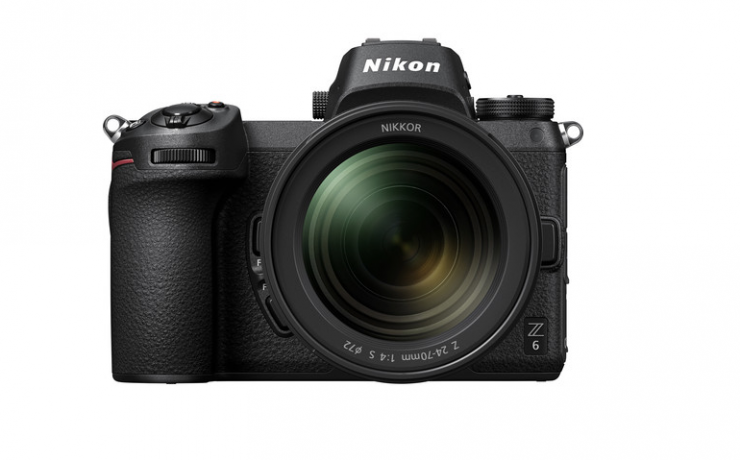
As far as the competition goes if you are looking for a full-frame mirrorless camera to primarily use for video, the best available options are the Panasonic S1, Nikon Z6, Sony a7s II, Sony a7 III, Sigma fp, and Canon EOS R.
I don’t personally think that the S1H has a direct competitor, because it offers a lot of features that are not found in other cameras.
On paper at least, most of these cameras look outclassed by the S1H. In saying that, all of these other cameras are significantly cheaper than what the S1H costs.
| Panasonic S1H | $3,997.99 USD |
| Panasonic S1 | $2,497.99 USD |
| Nikon Z6 | $1,796.95 USD |
| Sony a7s II | $1,998.00 USD |
| Sony a7 III | $1,998.00 USD |
| Sigma fp | $1,899.00 USD |
| Canon EOS R | $1,999.00 USD |
All of these cameras offer different features and functionality, but all of them are capable mirrorless cameras if you are looking at using them primarily for video.
It’s no real surprise that given its abilities and feature set that the S1H is significantly more expensive than most other mirrorless full frame cameras.
However, the question you need to ask is – Is it worth twice as much as its competitors? That, I’m not sure.
Quick Panasonic S1H, Nikon Z6, Sony a7 III Comparison
I decided to do a quick comparison between the S1H and the Nikon Z6 and Sony a7 III. Now, this is nothing in-depth, as that would make this already long review too long. These are just simply a couple of quick tests I did so you can get a better idea of how the cameras fare out of the box.
The S1H is the only camera out of the three that can record 4:2:2 10-bit internally. For these tests, I didn’t want to introduce any external recorders as I thought it was important you see what the cameras are capable of recording internally.
Low Light
I set up a quick test where I could compare the low light performance of all three cameras. To make this as fair as possible all three cameras were using the same exact lens, same T stop, same white balance, and they were all set to their standard picture profile settings.
Above you can see that comparison. After carefully looking at the noise levels the S1H and the Sony a7 III are pretty close. The Nikon has the worst low light performance of all three of the cameras.
When I compared V-Log against S-Log3 it looked like the S1H image had slightly less noise, but it was very close.
What was interesting is that the standard picture profile on the Panasonic S1H produced a much darker image than both the Sony and Nikon.

S1H 
a7 III 
Z6
If you look above you can see the difference between all three at 12,600 ISO. Despite all being at the same ISO, the S1H isn’t displaying nearly as much luminance. In the standard picture profile, it seems as though Panasonic is crushing the blacks a lot more than Sony or Nikon.
Colors out of the box
If you want to shoot with a camera out of the box in a standard picture profile that you can turn around straight away without having to do anything to the image, you want something that has nice colors and a pleasing image.
This is where the S1H performs better than any other mirrorless hybrid camera I have come across. Skin tone and color replication are very good in the standard picture profile.
At the top of this section, you can see a comparison between the Panasonic S1H, Nikon Z6, and Sony a7 III in their Standard picture profile. I purposely placed Jeff in a heavily backlit contrast scene so we could see how each camera behaved. The whole idea behind this test was to see how the cameras fared in an uncontrolled environment, it was not to try and make them look as good as possible.
All three cameras are running the exact same T stop, ISO and white balance and they are all using the exact same lens. These are exactly as shot, I haven’t touched the images at all.
It was quite interesting to see just how different the images were. Now, to be perfectly clear, any of these three cameras can be made to look good with a bit of tweaking.
Would you be better off just buying a digital cinema camera?
At $3,997.99 USD the S1H is certainly not what you would call affordable as far as mirrorless cameras go. The question I kept asking myself is would you just be better off buying a digital cinema camera?
There are arguments to be made both ways. A lot of shooters who want to step up from an affordable mirrorless camera, usually make the jump up to an entry or mid level digital cinema camera. However, the S1H offers another alternative. You could step up to an S1H if you wanted better features and performance but still wanted to maintain and use that mirrorless form factor. On the other hand, if you are going to spend $4K on a camera that doesn’t have built-in ND or good onboard audio recording options then maybe it makes sense to spend a little bit more and grab a digital cinema camera.
Ultimately it comes down to the right tool for the right job and how you like to work and what type of gear you want to use. No one camera is going to be perfect for everyone. It’s good that we have a camera like the S1H, because it’s starting to blur the lines between mirrorless and digital cinema cameras.
We have certainly seen a trend over recent years of cameras getting smaller and lighter. They are also getting more affordable and offering more features than ever before. We are now spoilt for choice and the quality gap between affordable and expensive cameras continues to close. There really are no more excuses for anybody creating content. Any of today’s cameras are up to the task.
Conclusion
The S1H got hyped up a long time before we even knew what the specifications were going to be.
Whether you like Panasonic’s tease strategy or not, that is the way they now seem to market their products. Announce a camera and then try and build up hype by not giving everything away. They did the same thing with the EVA1, S1 and S1R.
So does the S1H live up to the hype? Well, yes and no. There is a lot to like about the S1H and its hard to be too critical of a sub $4,000 USD camera that can shoot open gate, 6K, 4K full-frame at up to 30p internally in 4:2:2 10-bit with this form factor and size. In saying all that, the camera is far from perfect and just like any camera it has its flaws.
Companies will always heavily promote and tout all the good things about their camera and they will try and gloss over any flaws or issues. That’s just marketing. I, however, wanted to give you honest and open feedback about every aspect of the S1H. If you are going to spend your hard-earned money on a camera then you need to know all the positives and the negatives.
I like the form factor, build quality, and a lot of the features the S1H has to offer. The onboard EVF and LCD screens are the best I have seen on any mirrorless camera.
I don’t like the fact you can’t punch in and check focus while your recording is absurd on a $4,000 USD camera.
Despite these issues, the overall usability of the S1H is pretty good. It’s probably the best hybrid mirrorless camera I have used. It is a camera you can just shoot without having to turn it into a frankenrig.
The image quality is good, but it does have its limitations. In saying that, I personally think that the images coming out of the S1H are the best I have seen from a mirrorless hybrid. Once the camera gets the ability to record in ProRes RAW it will add further versatility.
At $4,000 USD, it’s certainly not going to appeal to everyone and a lot of shooters will have a hard time justifying purchasing the camera when other capable options are available for half the price.
The S1H is the first mirrorless hybrid I would comfortably want to use with no external monitor or monitor/recorder. The overall user experience is the best I have had with any hybrid mirrorless camera.
Despite its flaws, I think Panasonic has set the bar fairly high for what you should expect out of a high-end full-frame mirrorless camera. In my opinion, it now sits on top of the throne as the king of mirrorless hybrids as far as video is concerned. How long it stays there remains to be seen.
Like what we do and want to support Newsshooter? Consider becoming a Patreon supporter and help us to continue being the best source of news and reviews for professional tools for the independent filmmaker.

